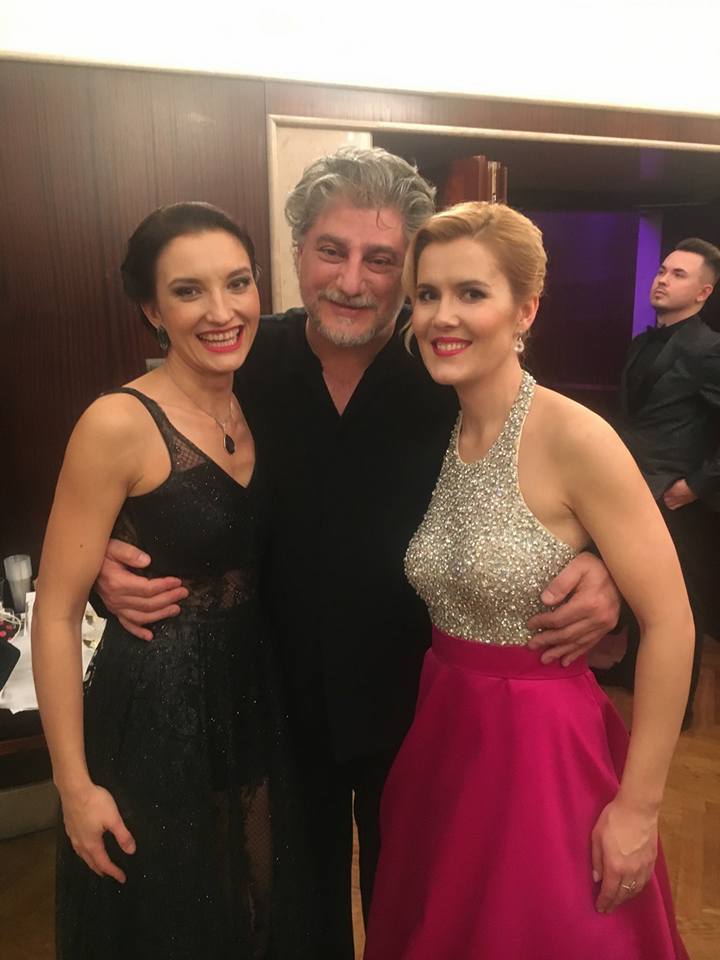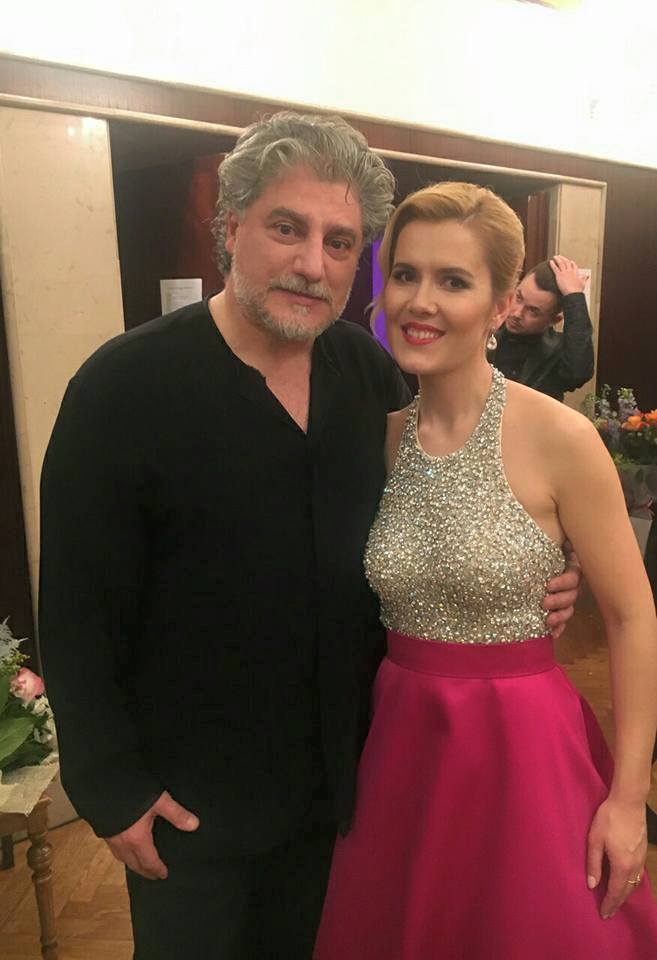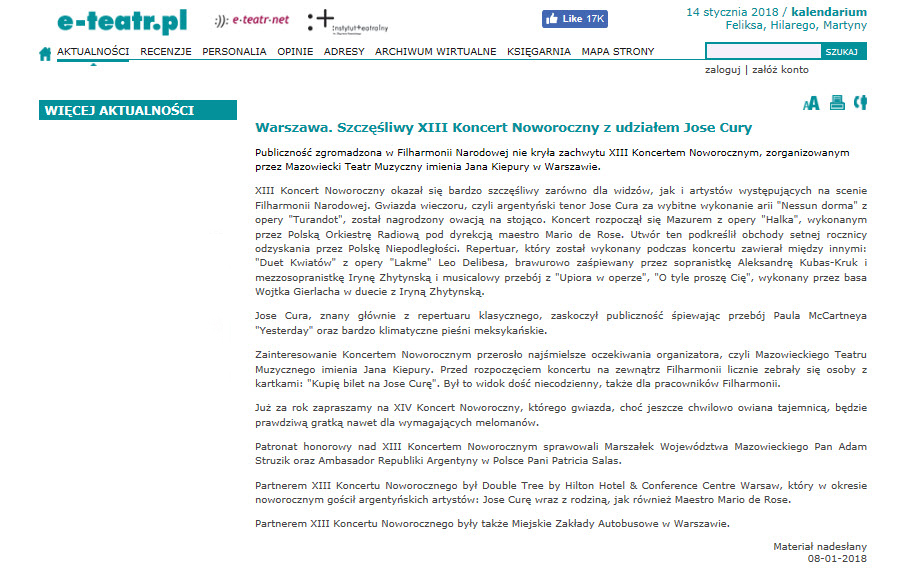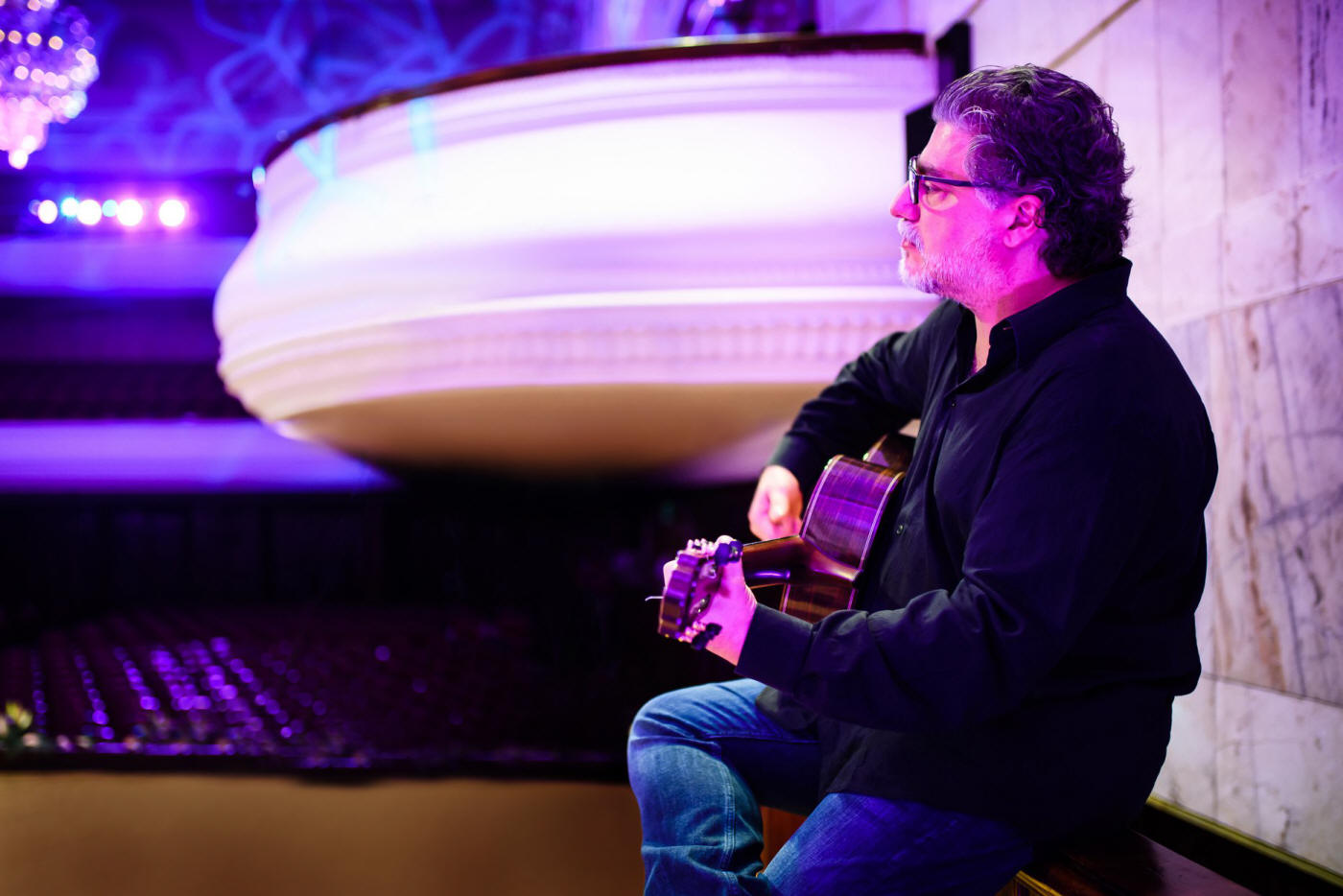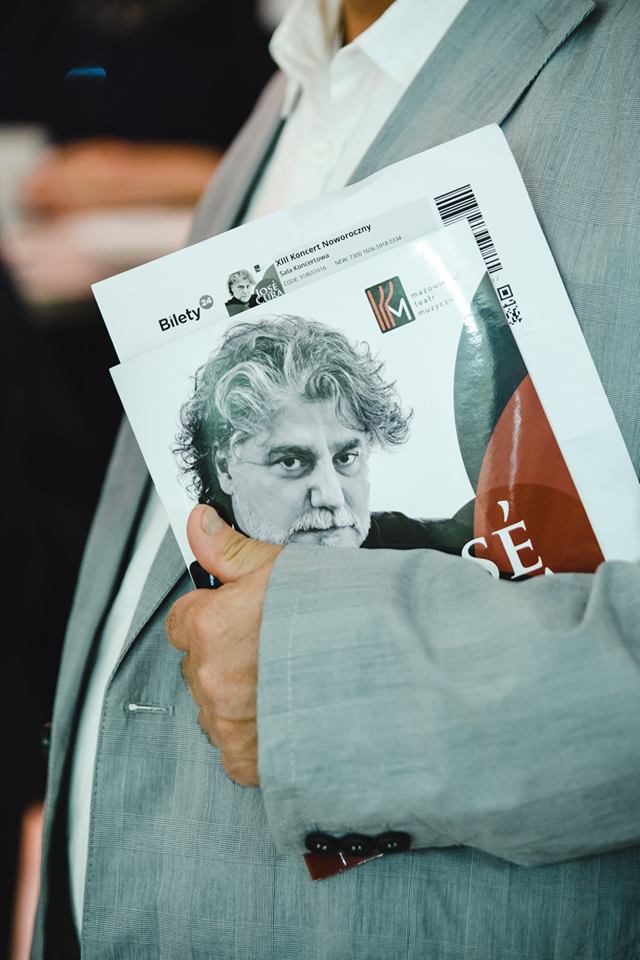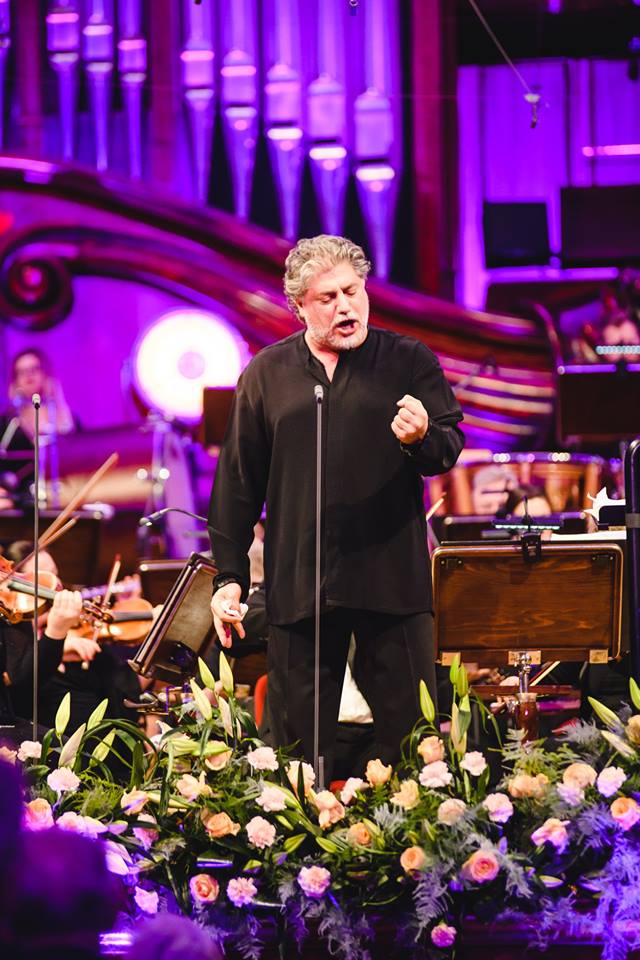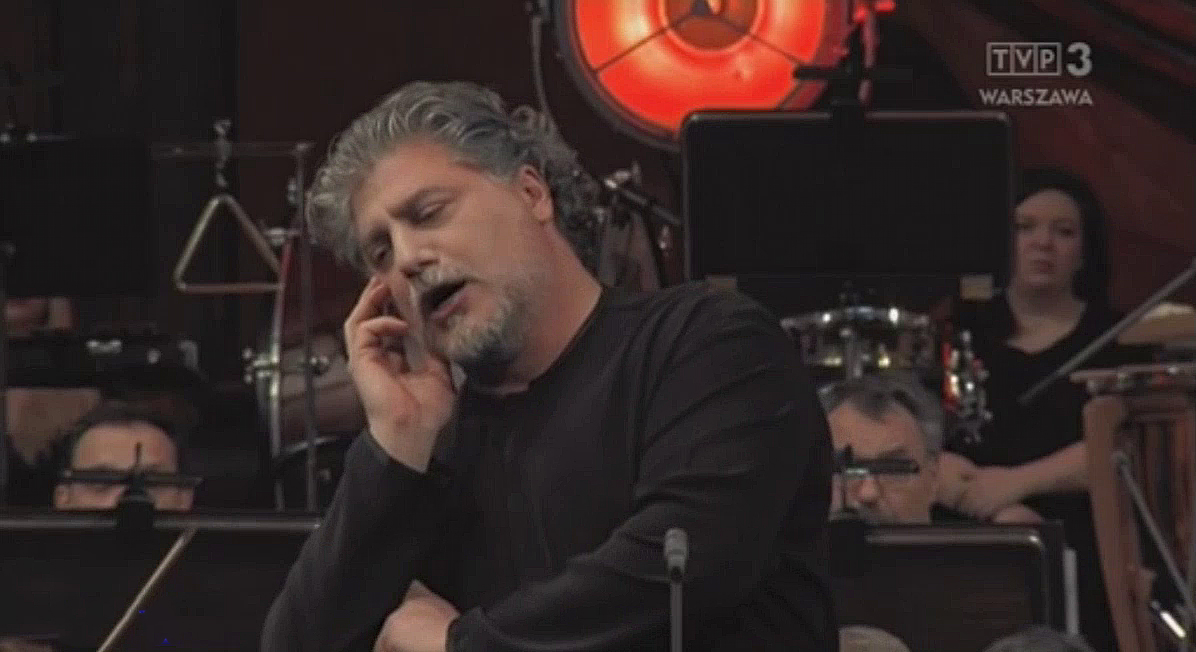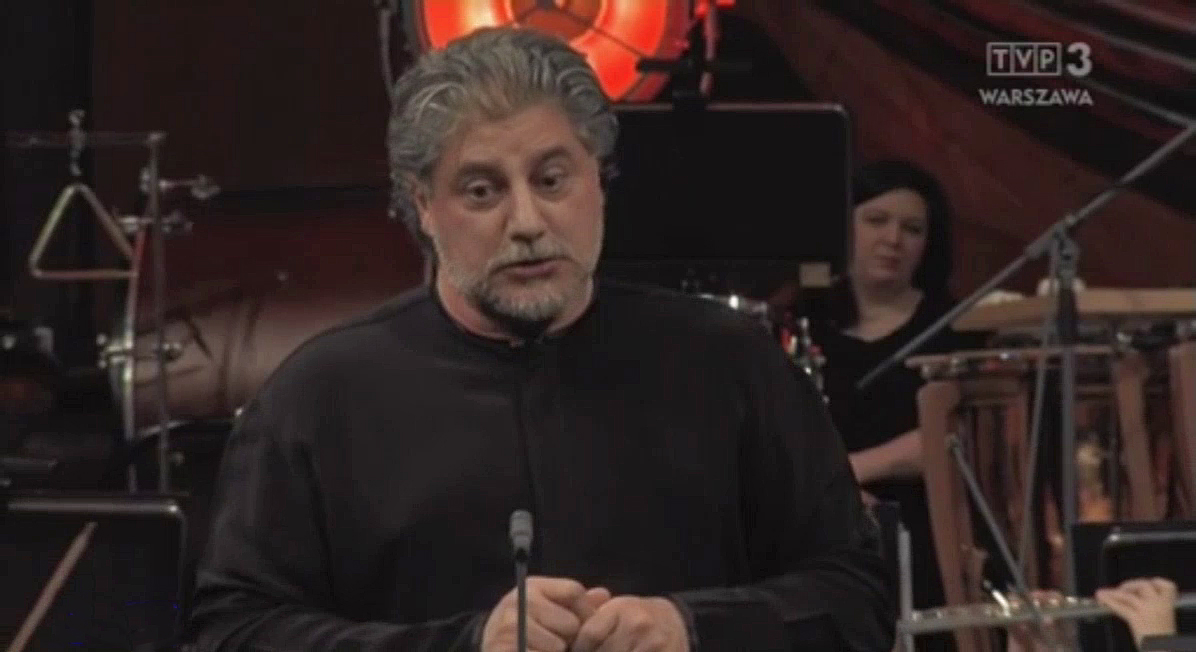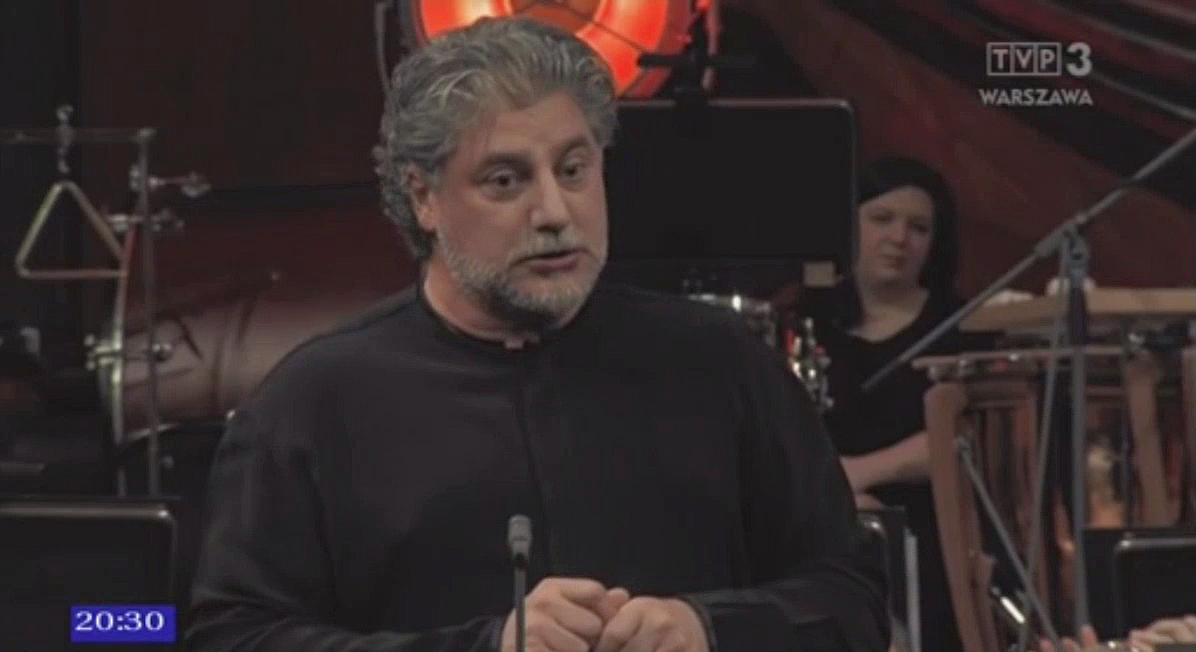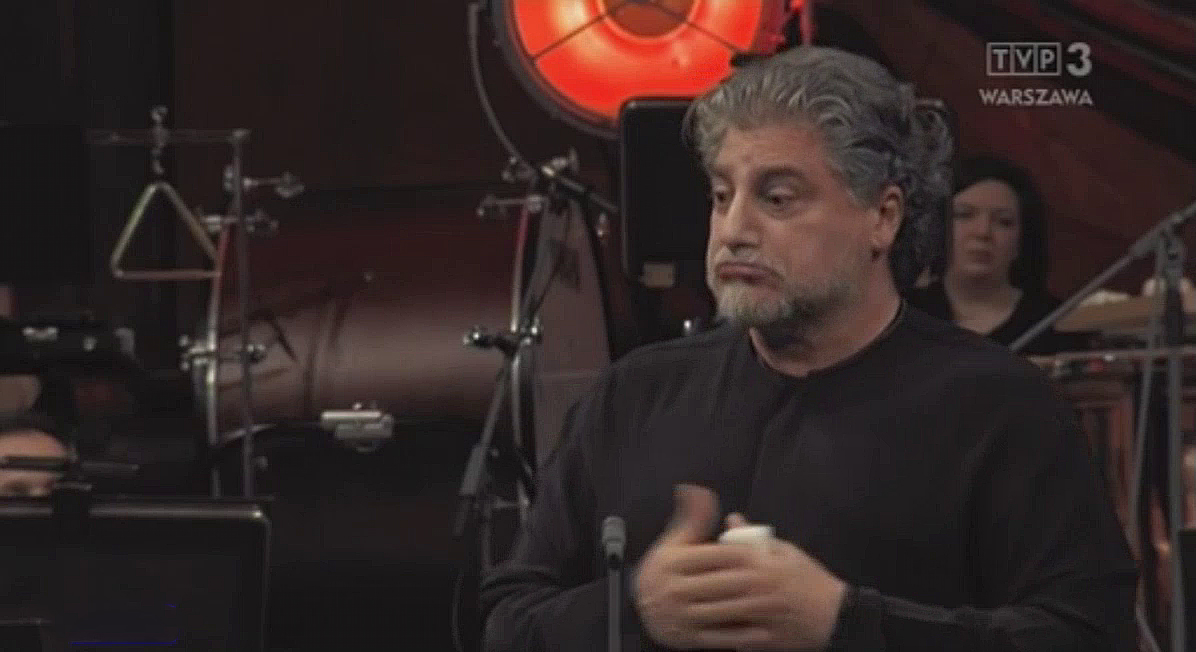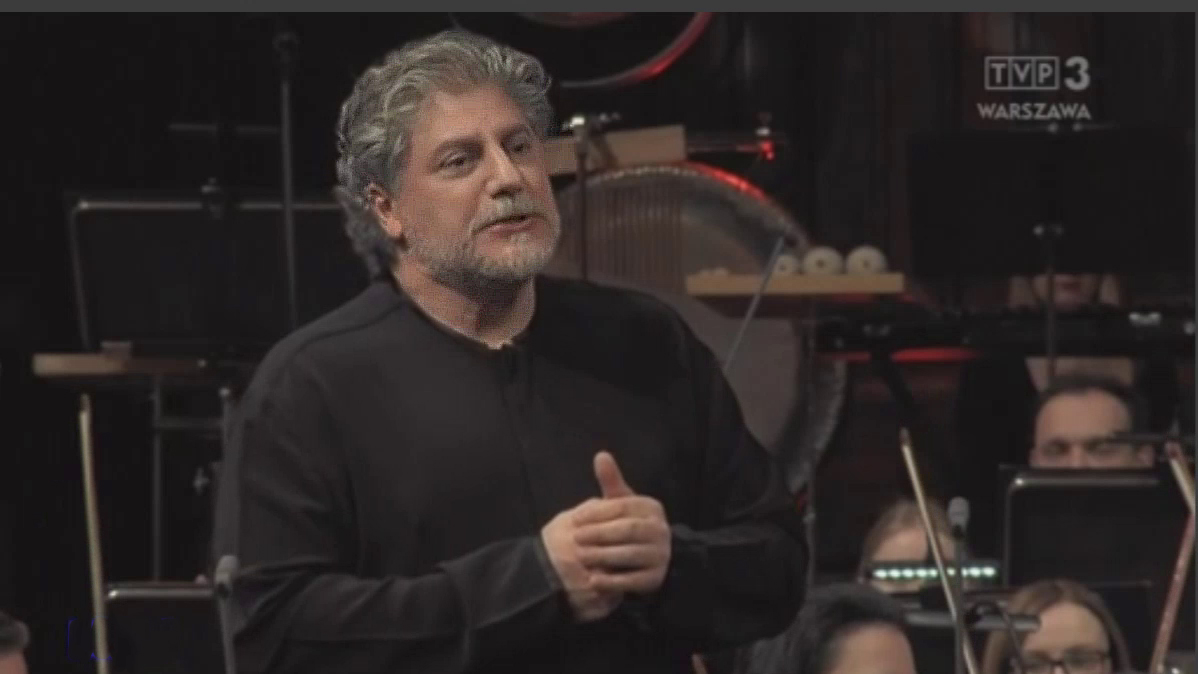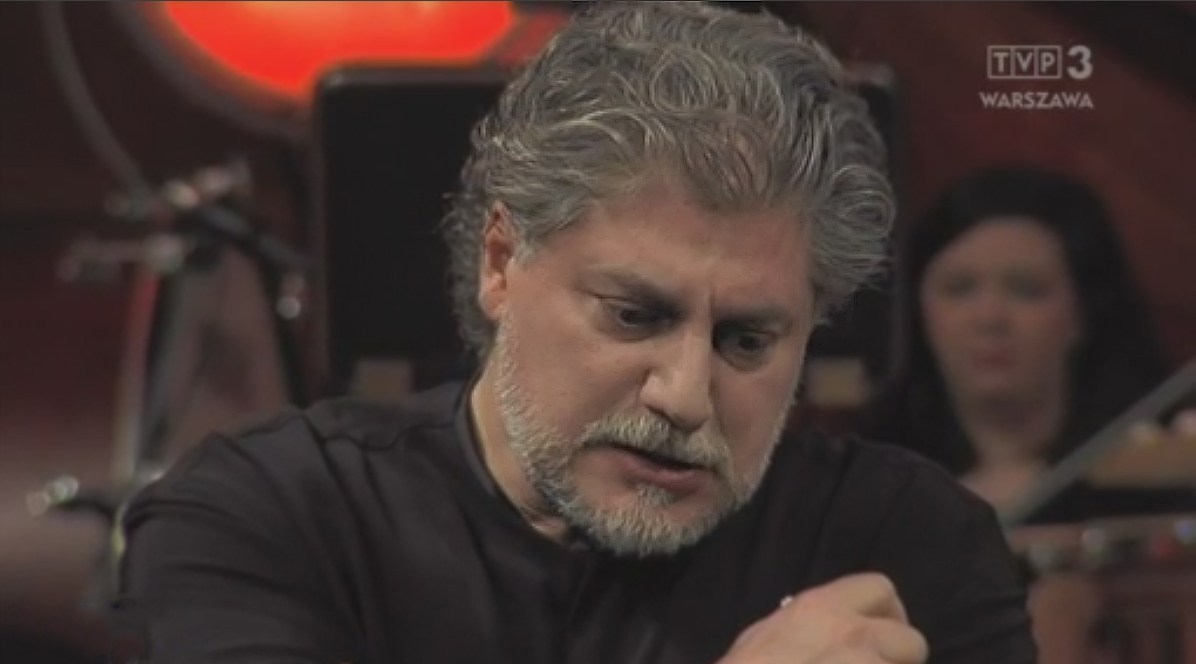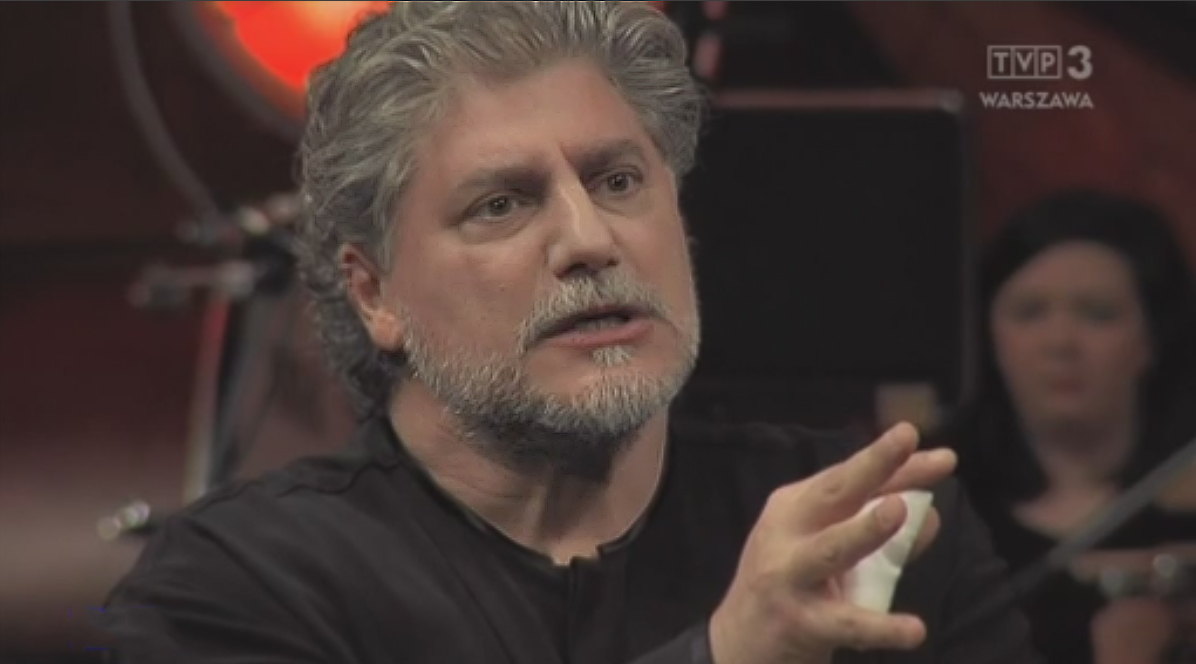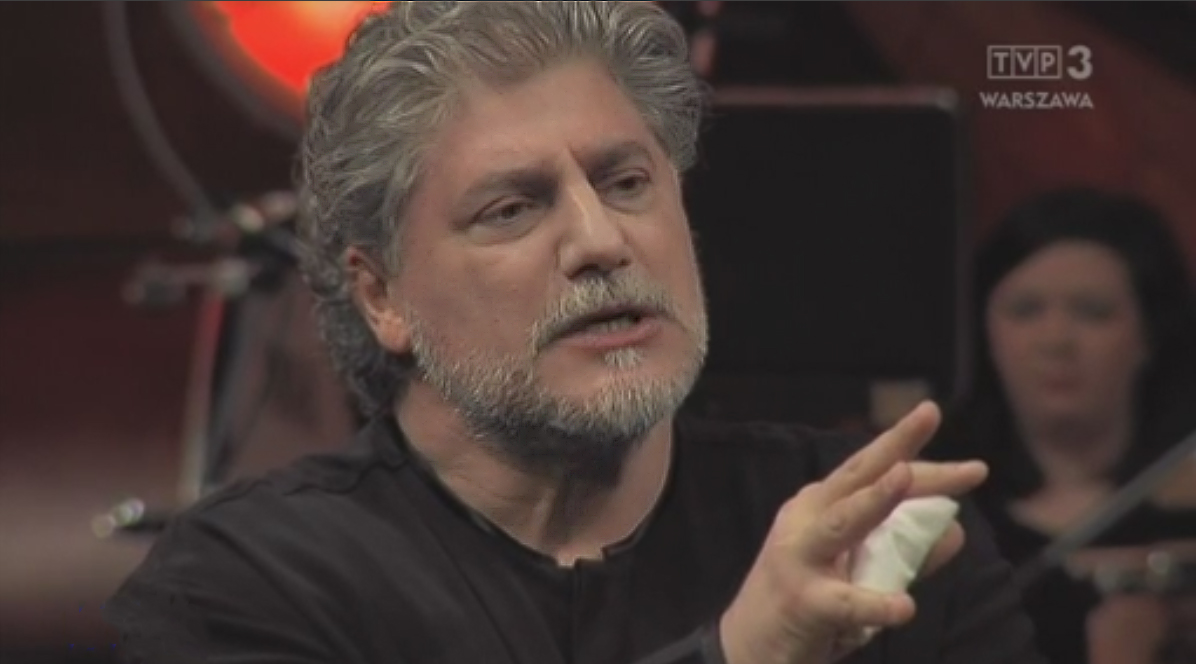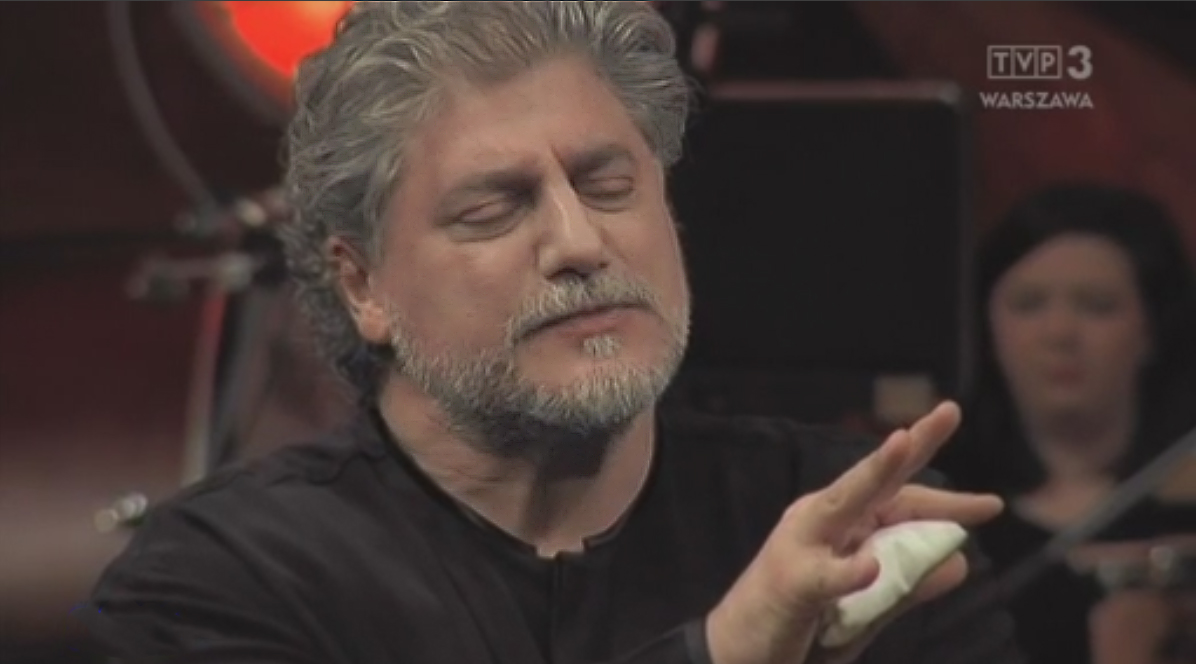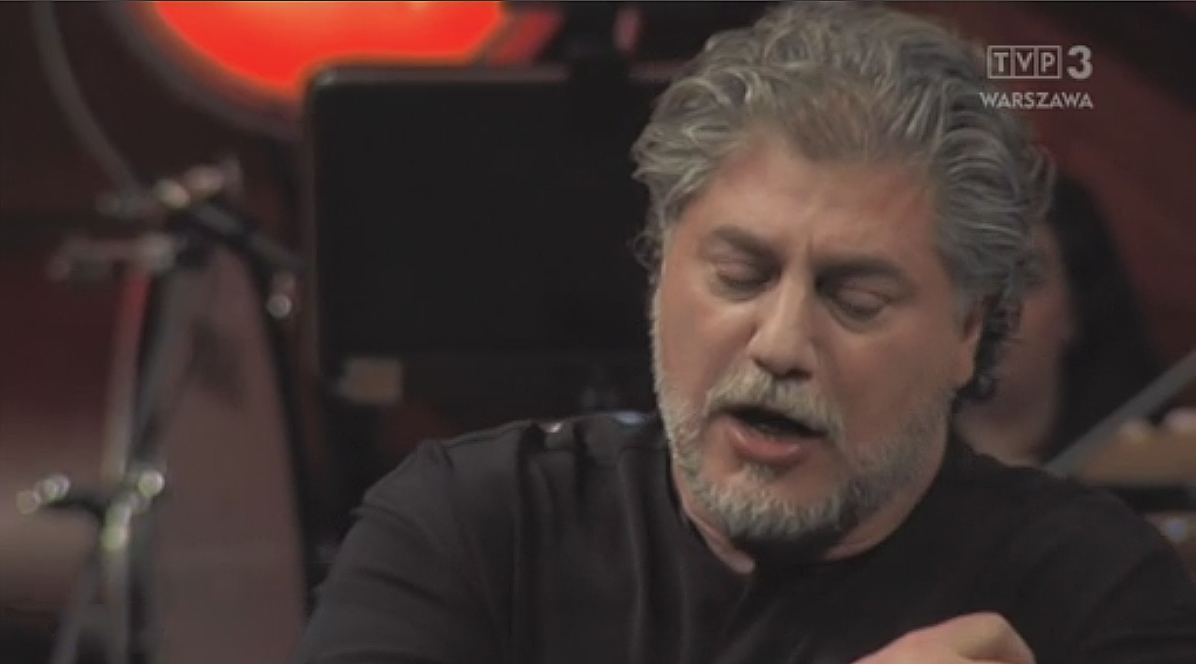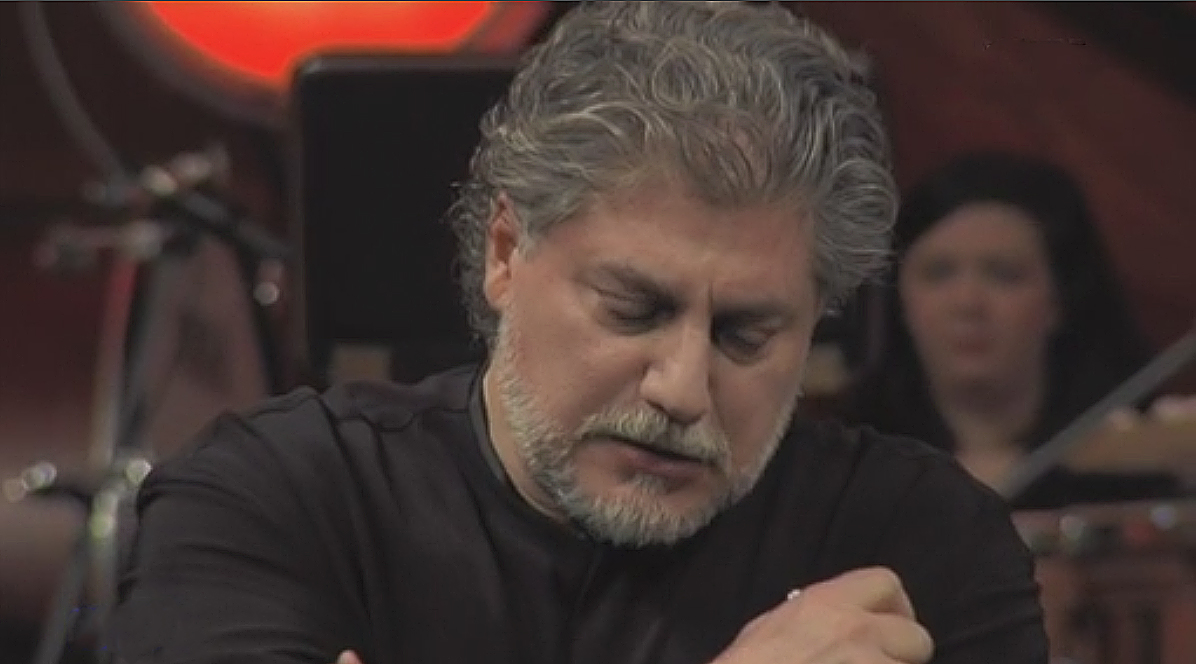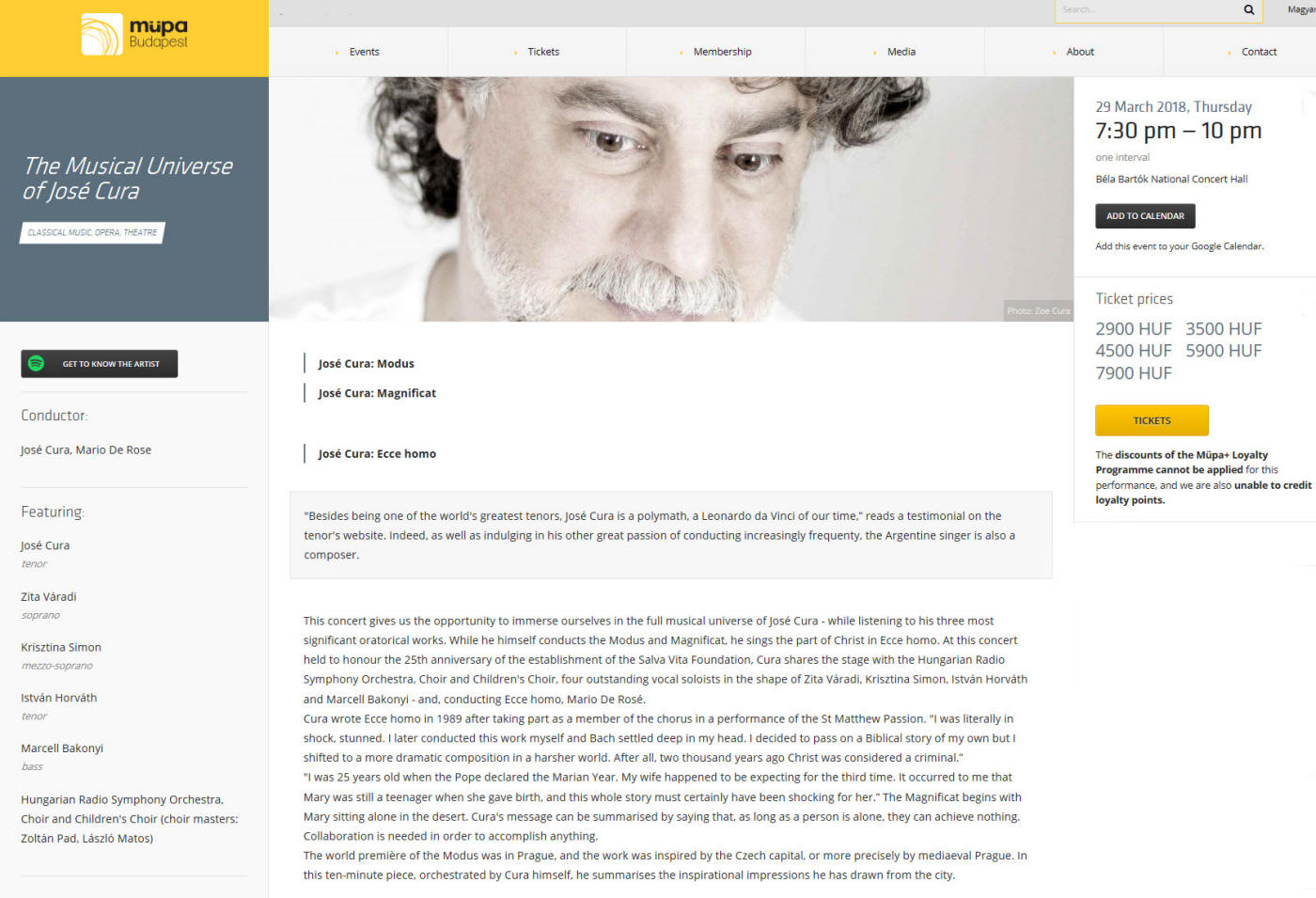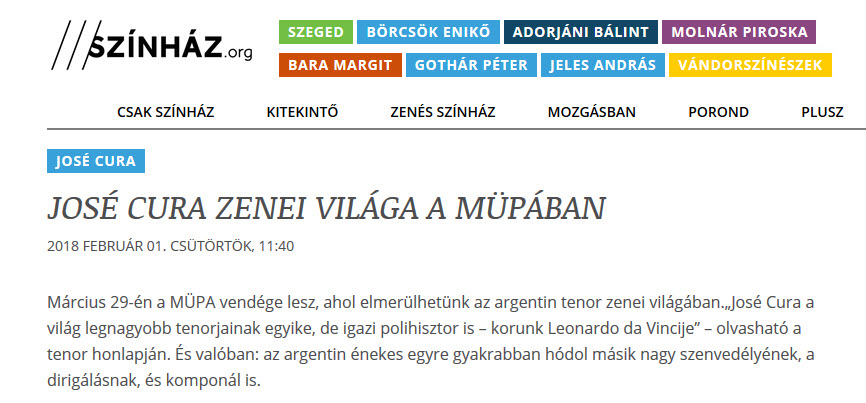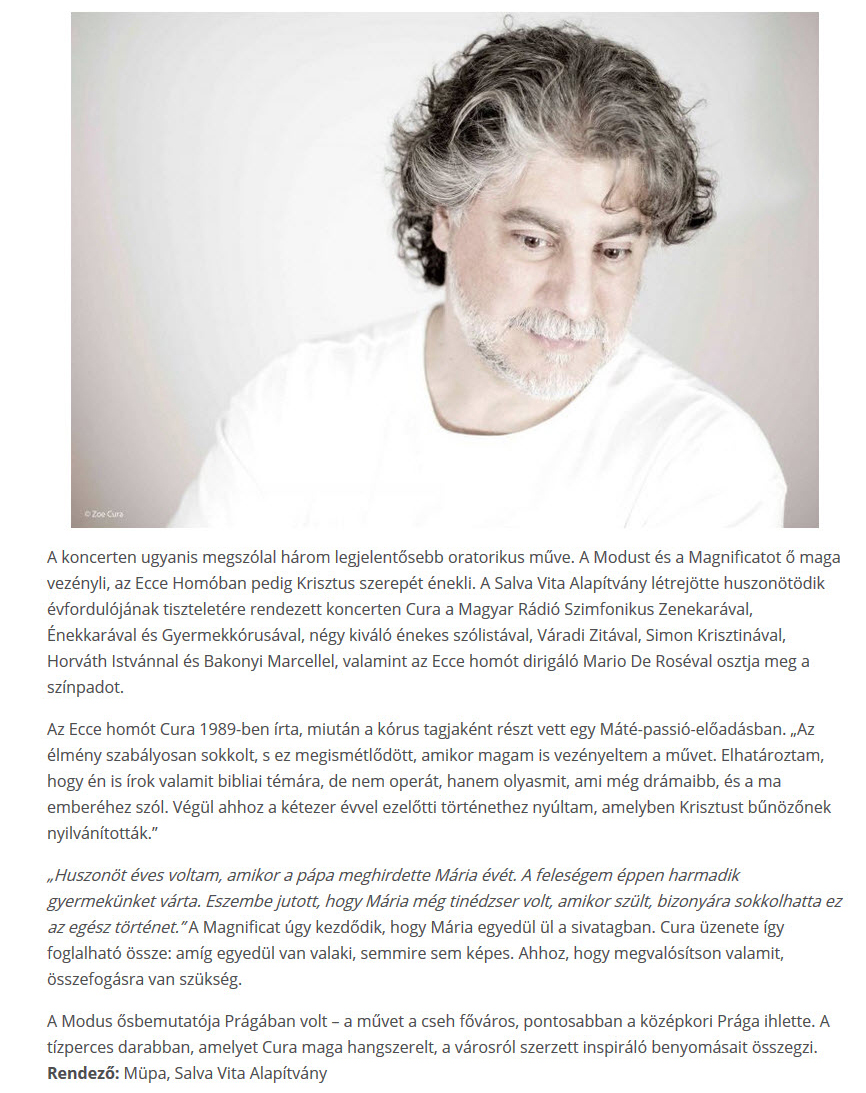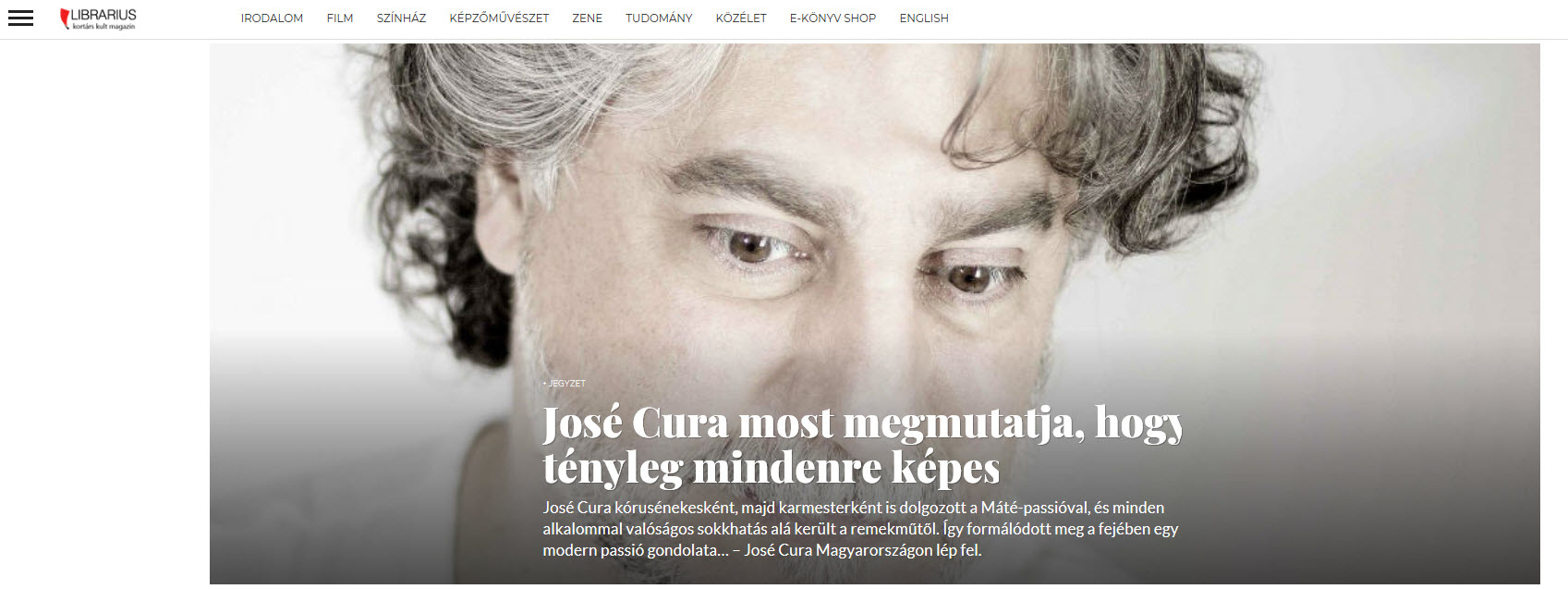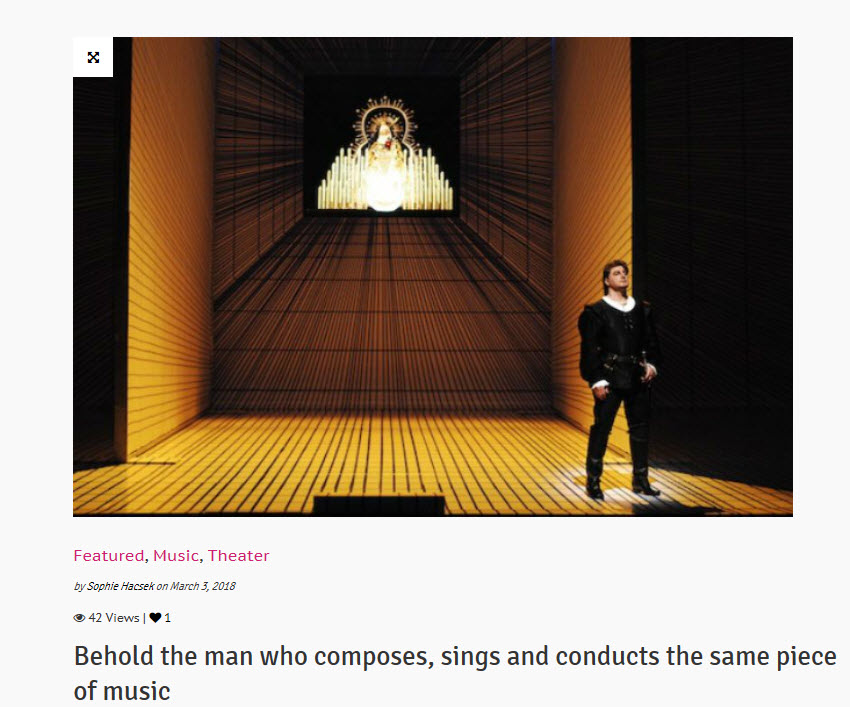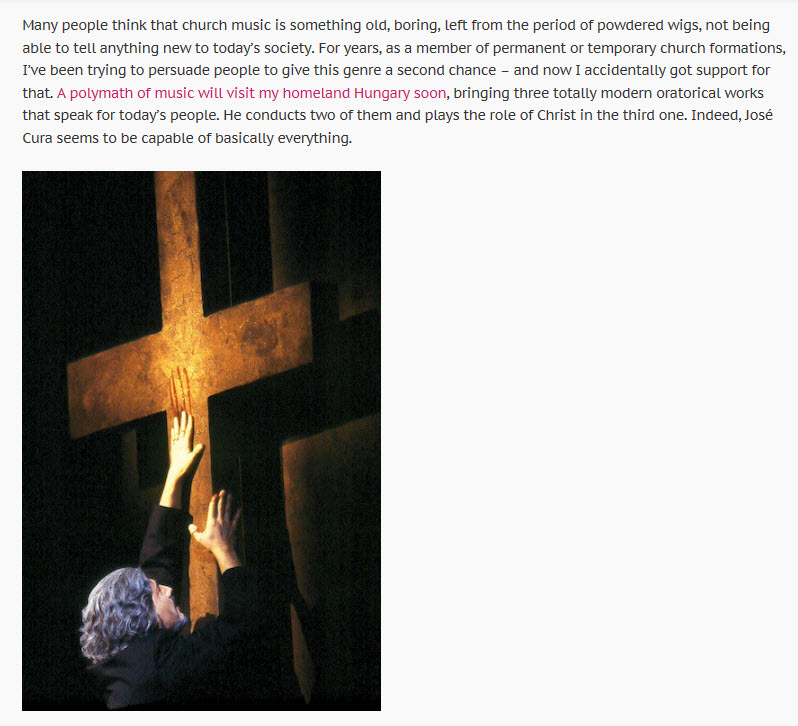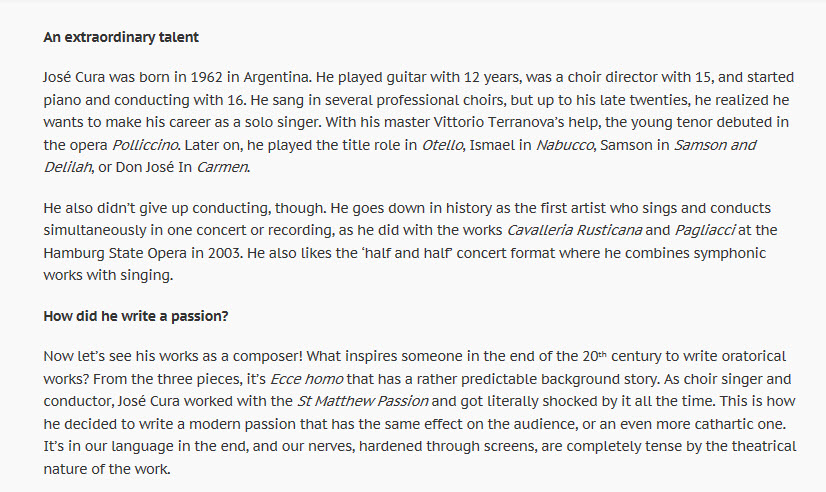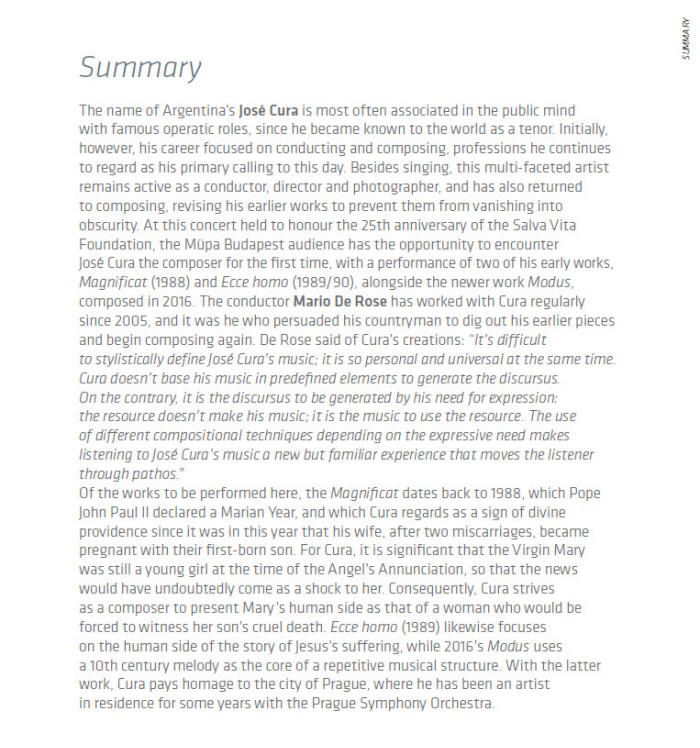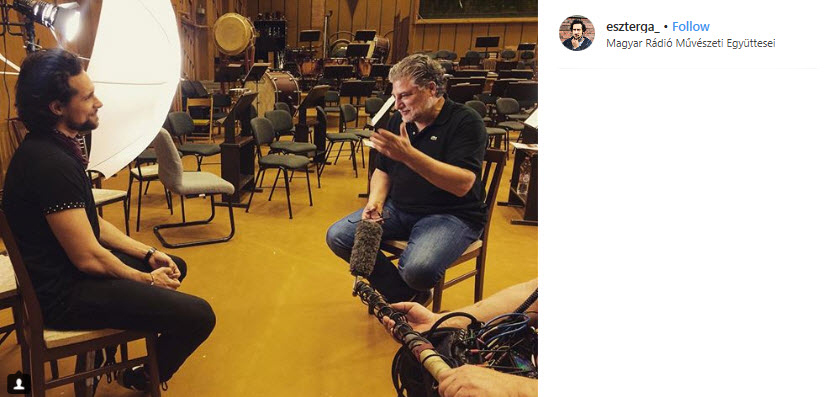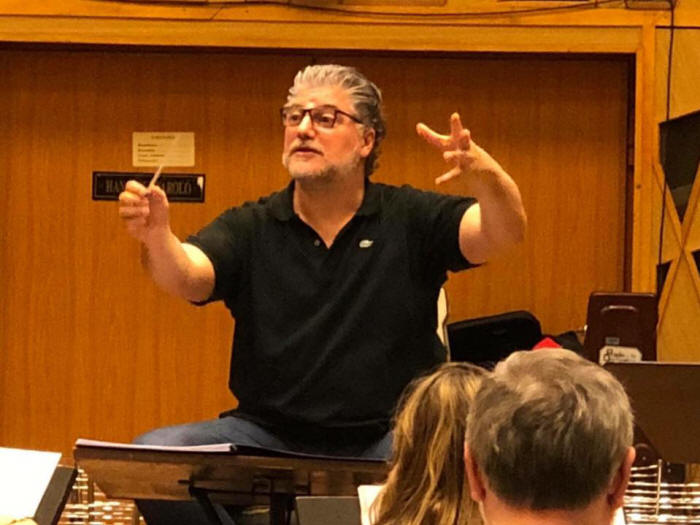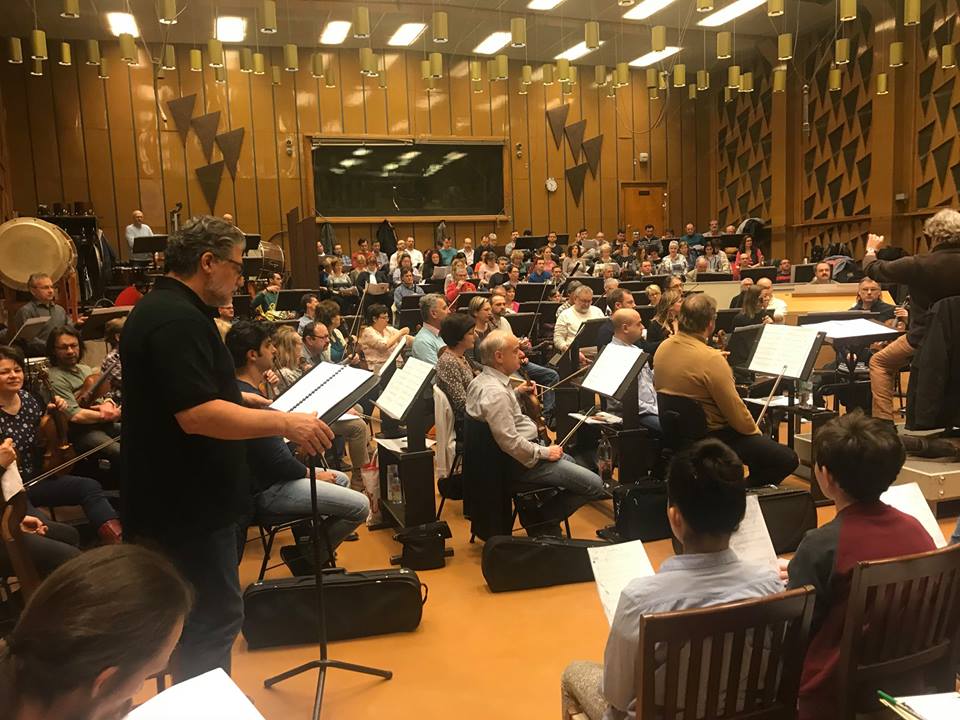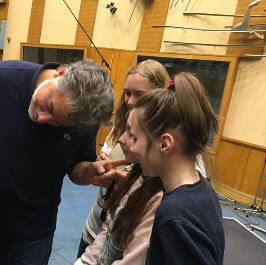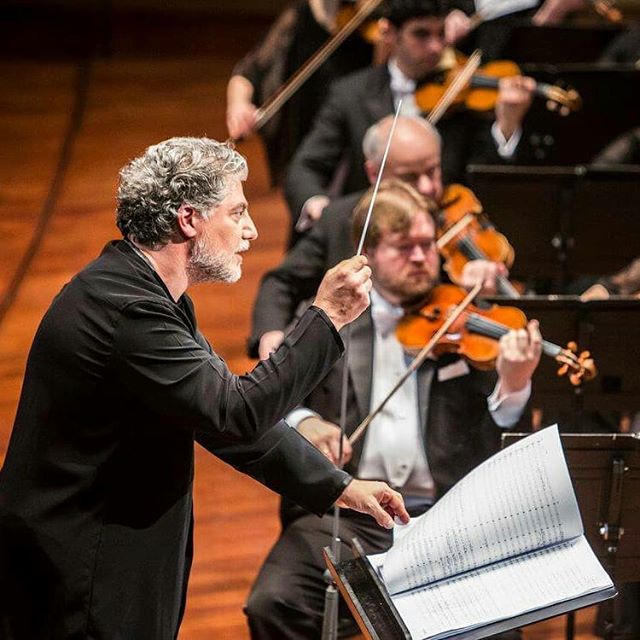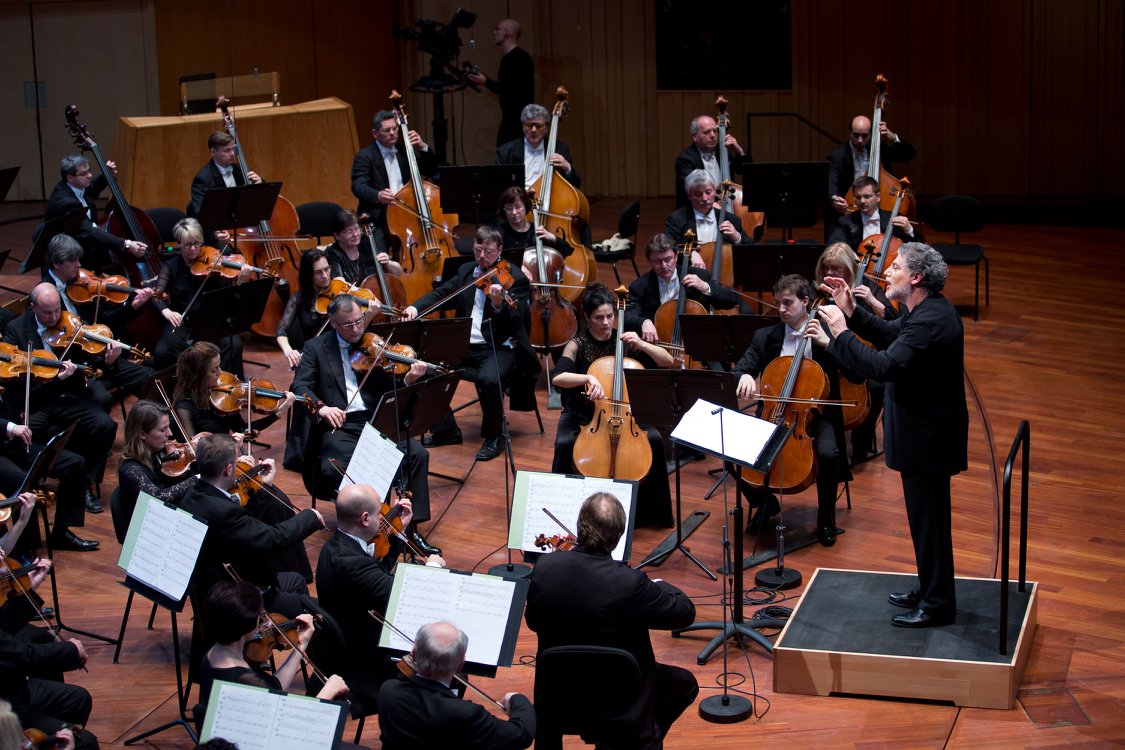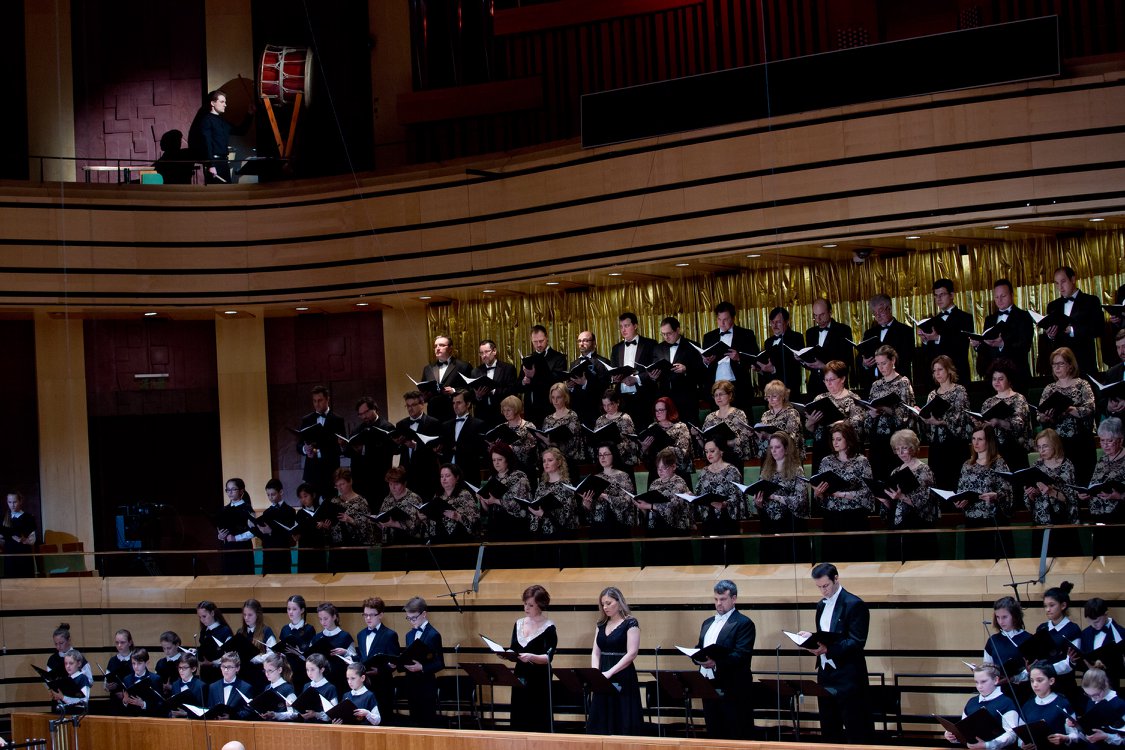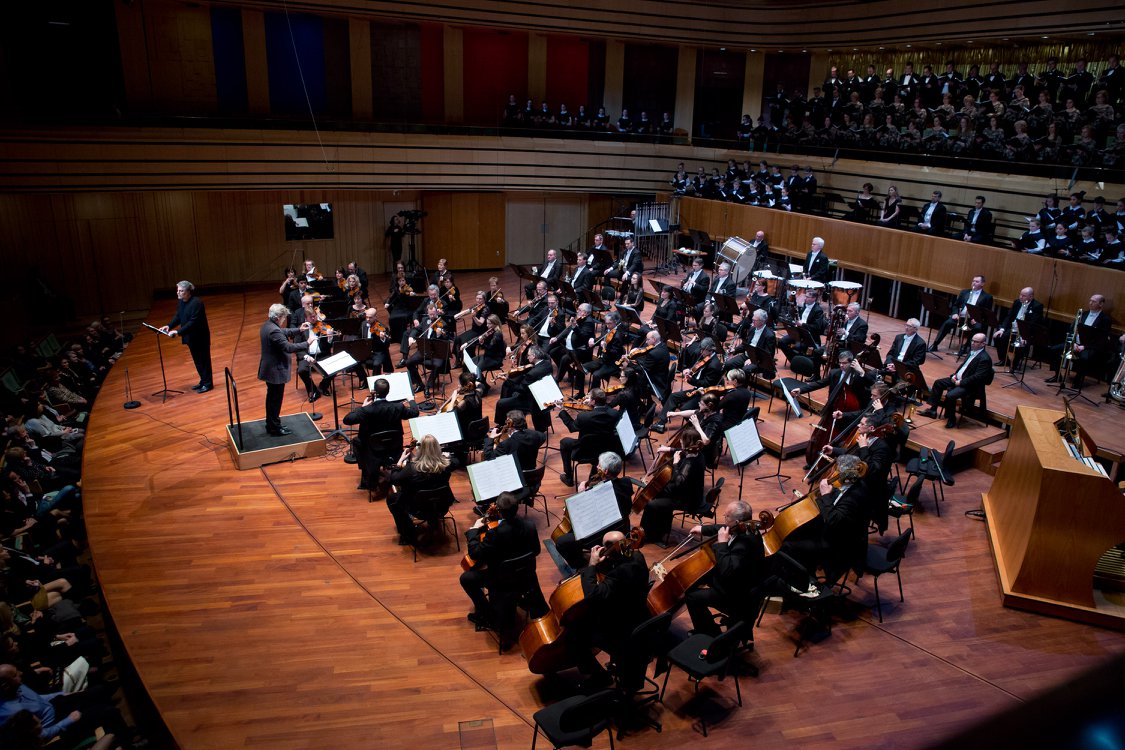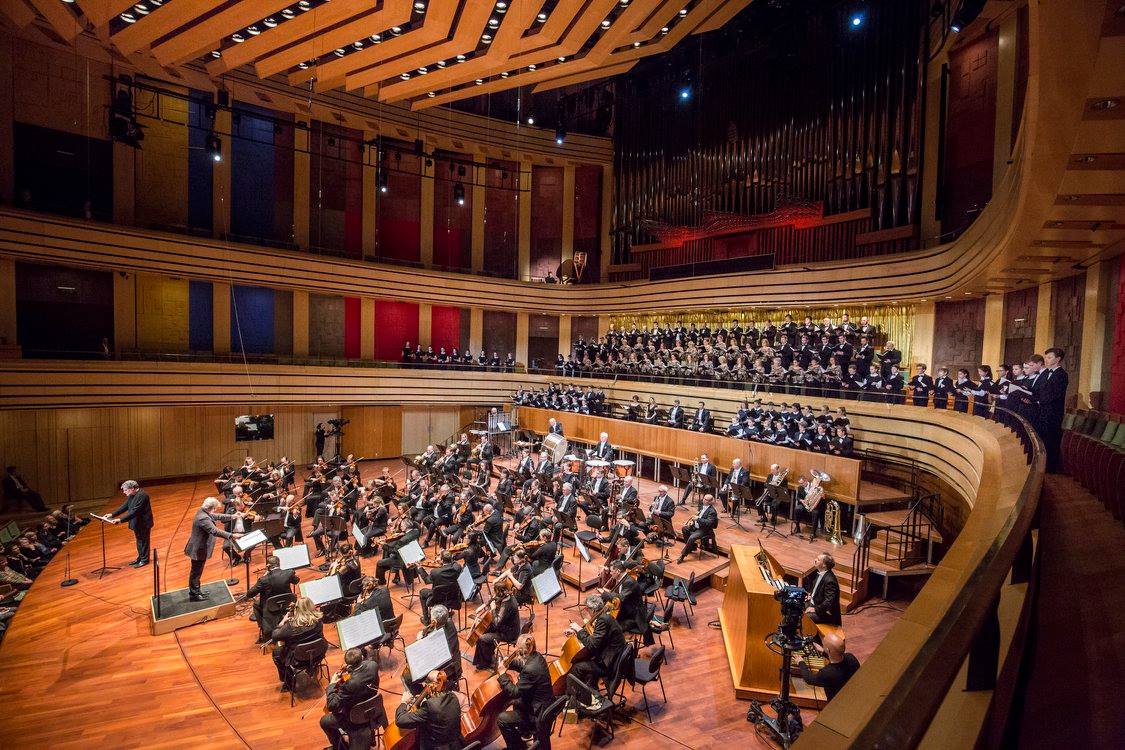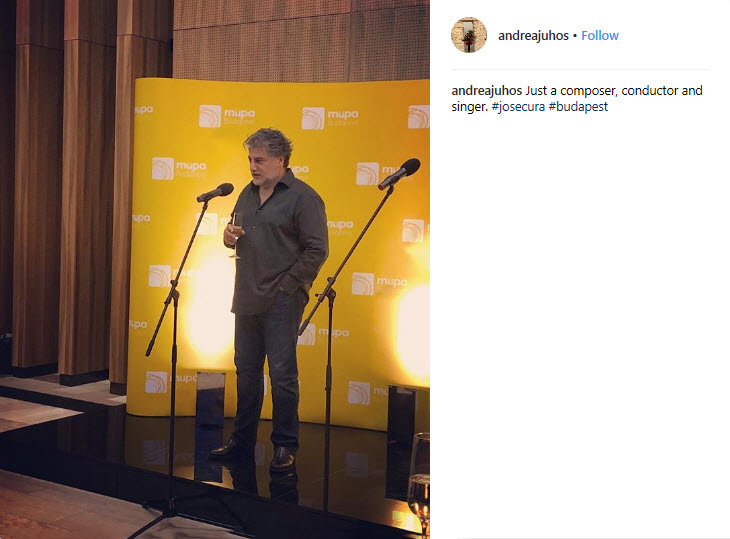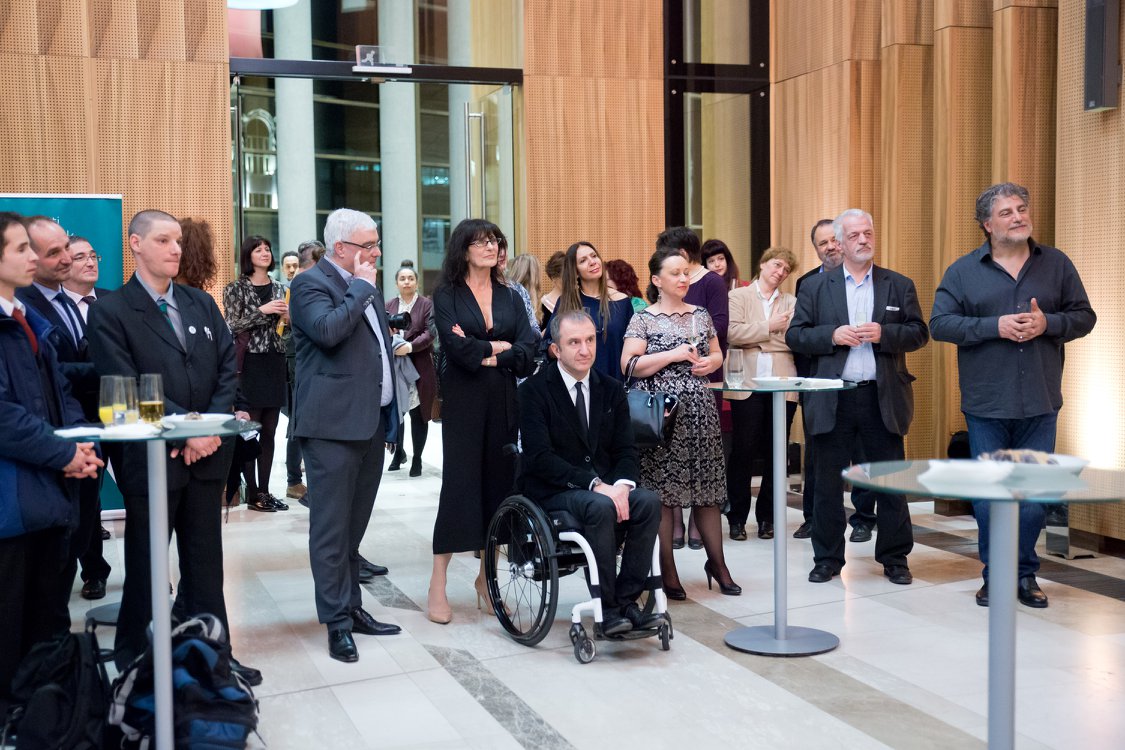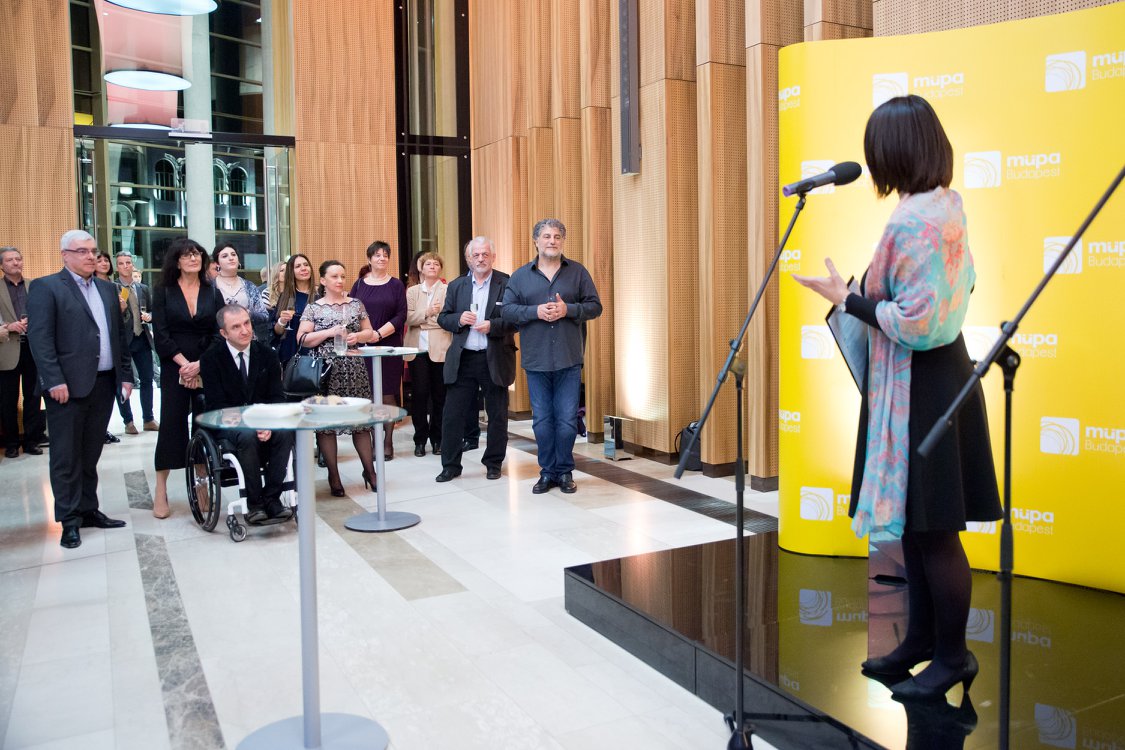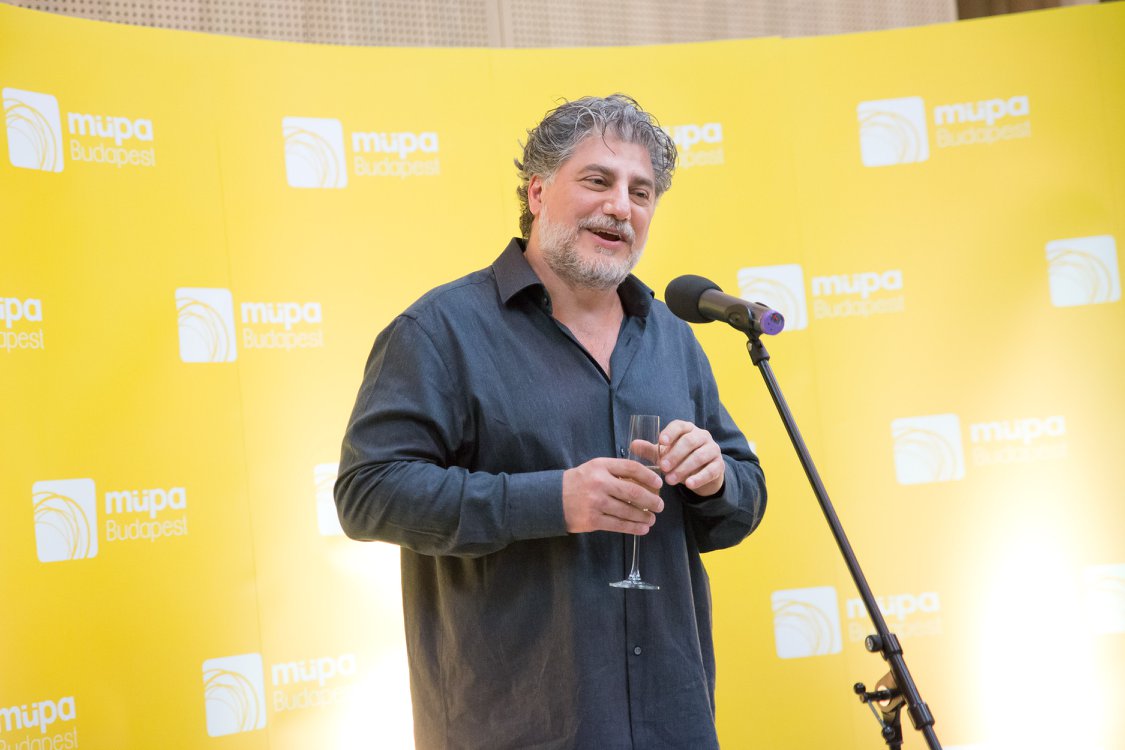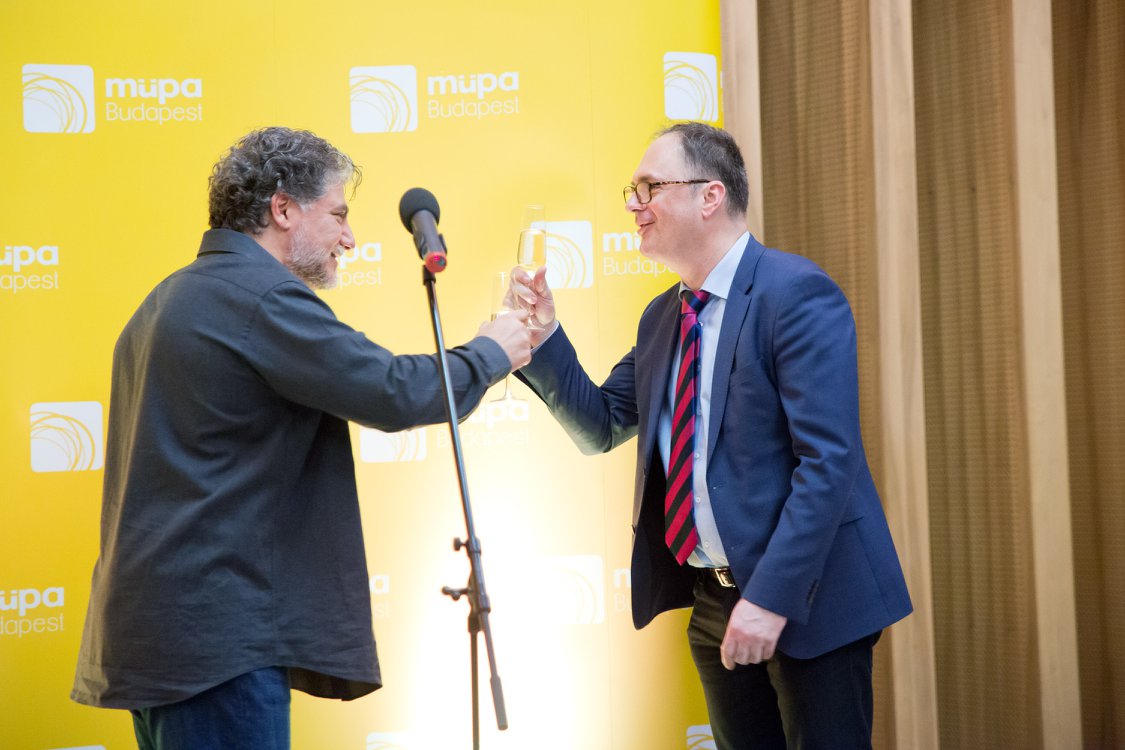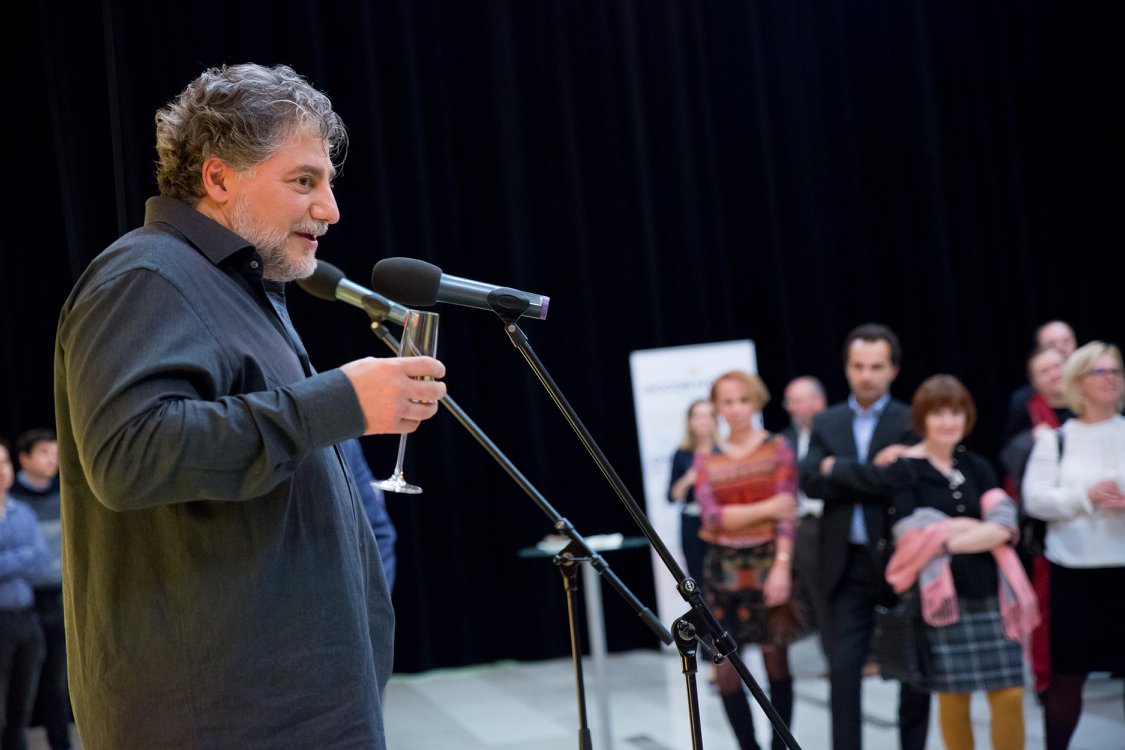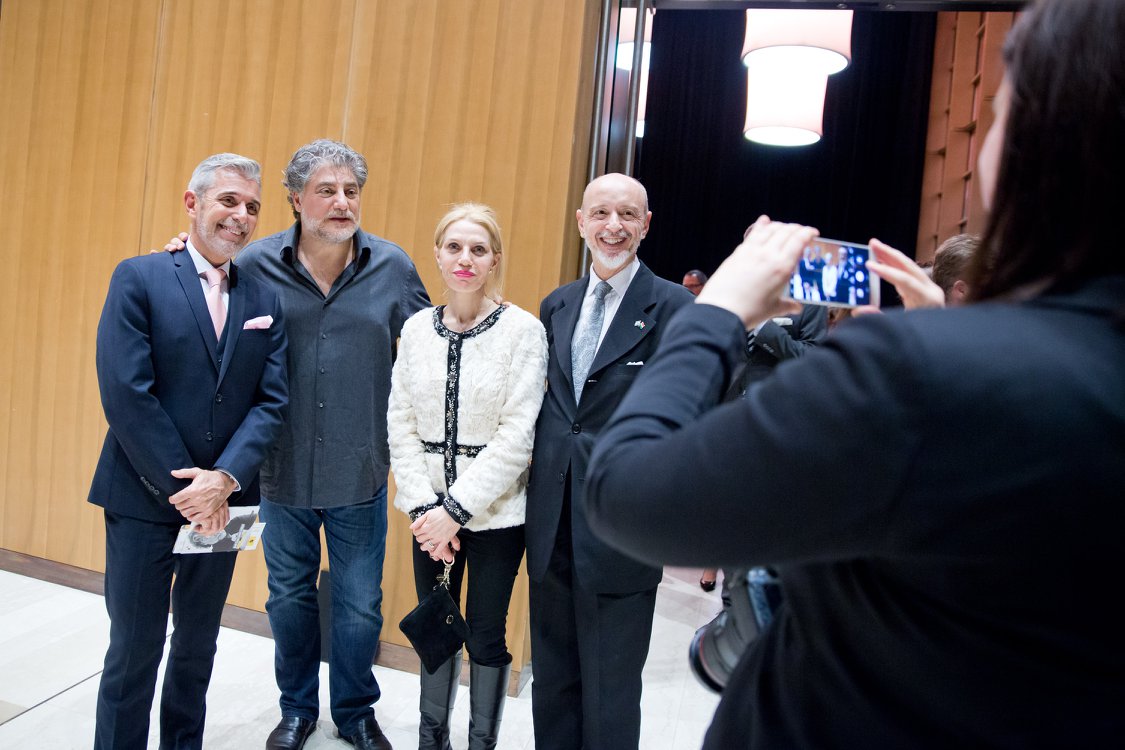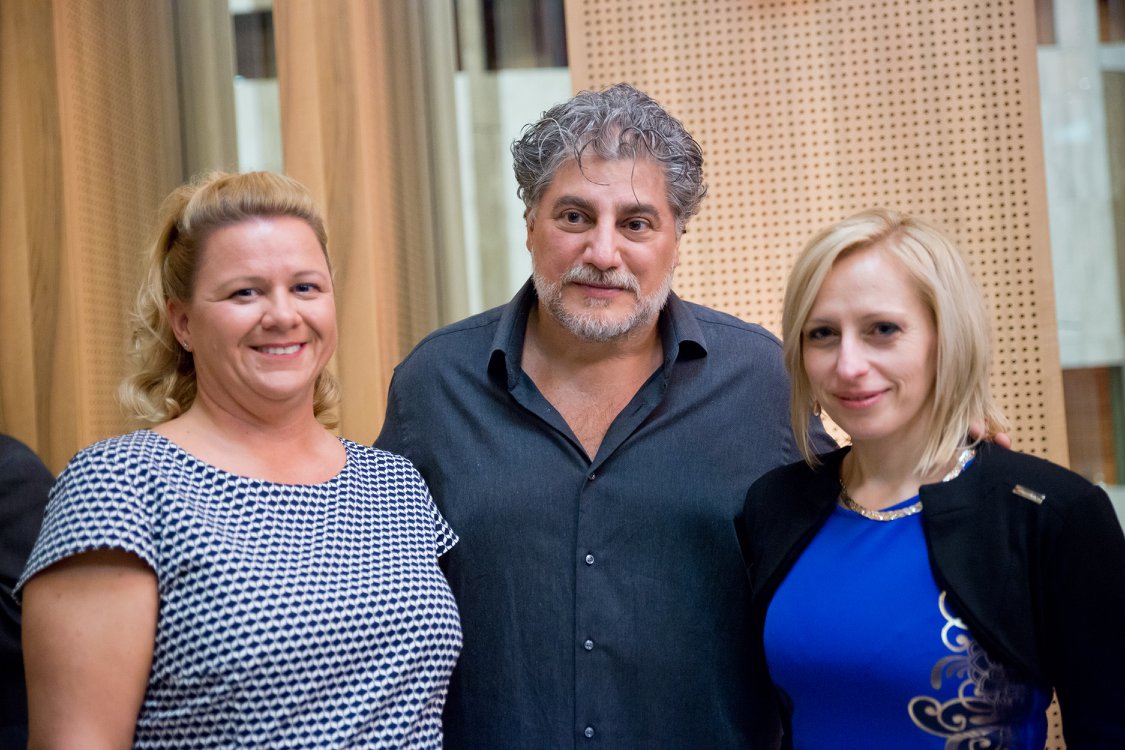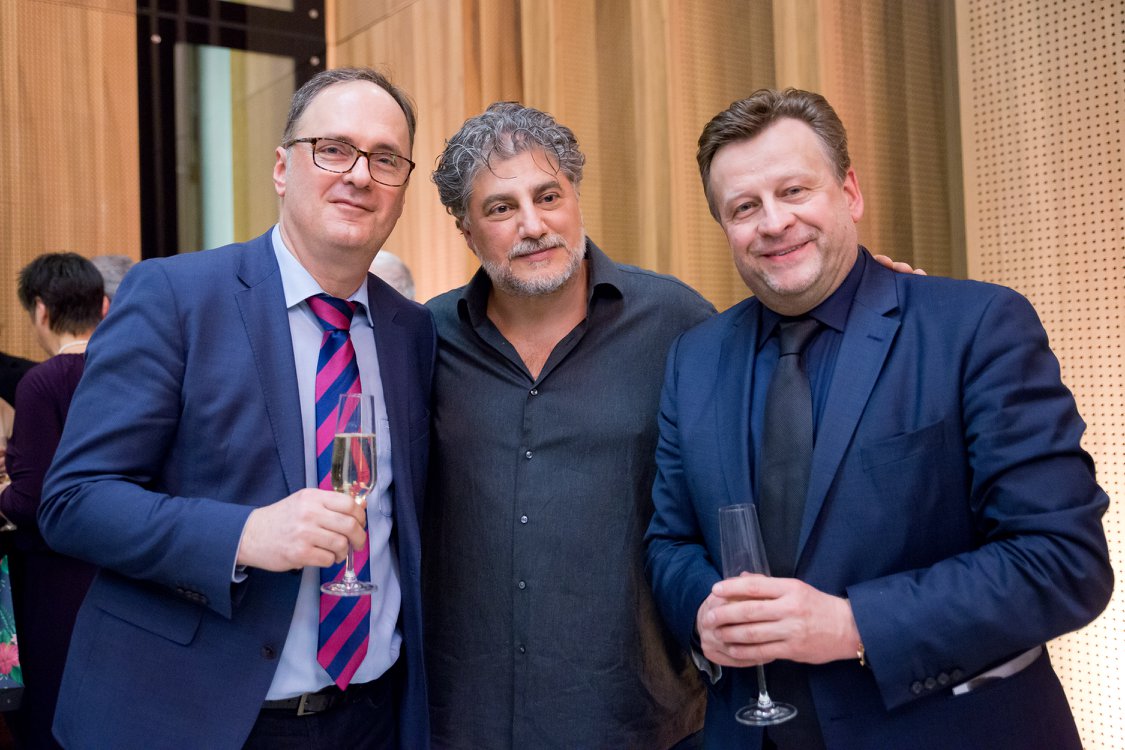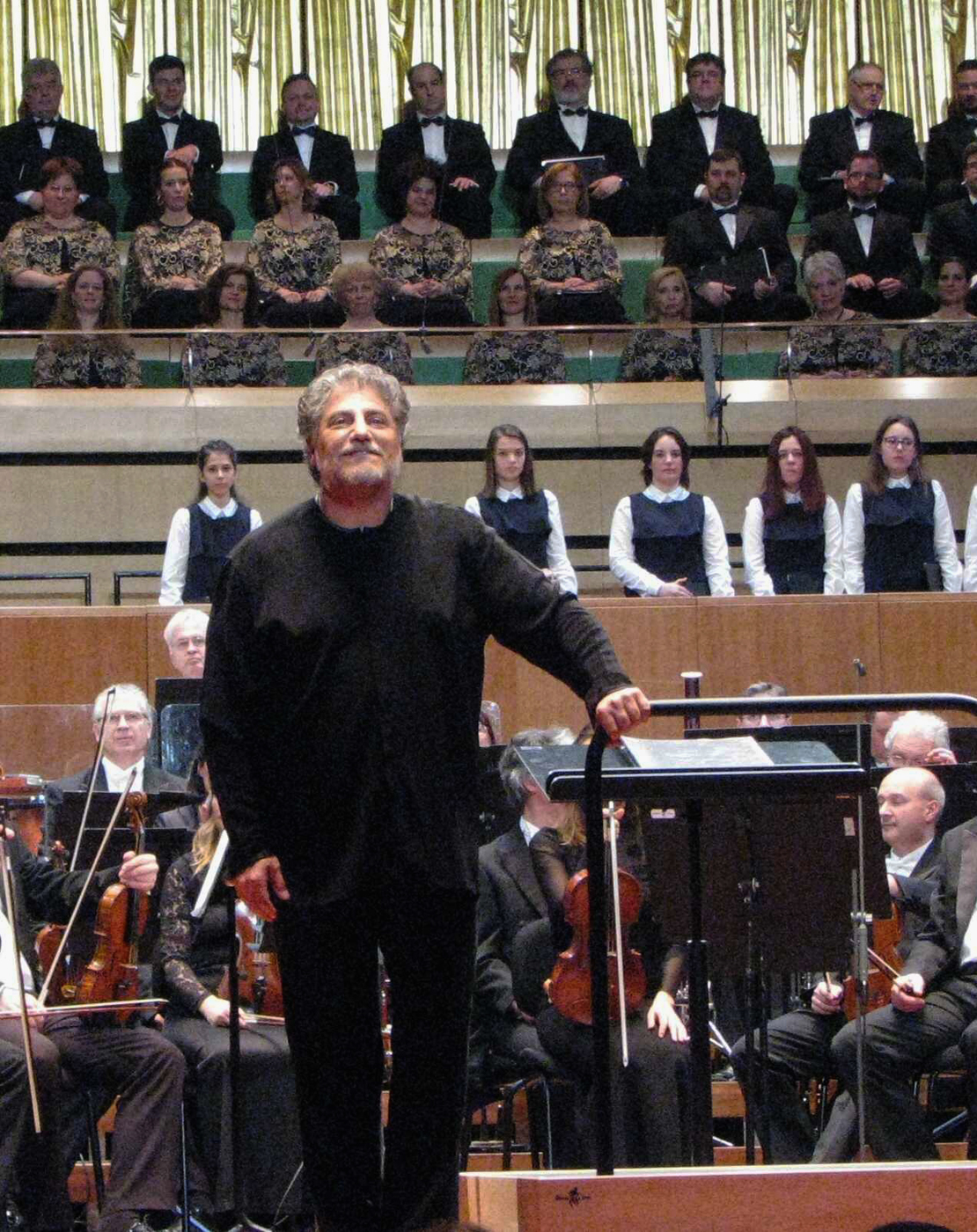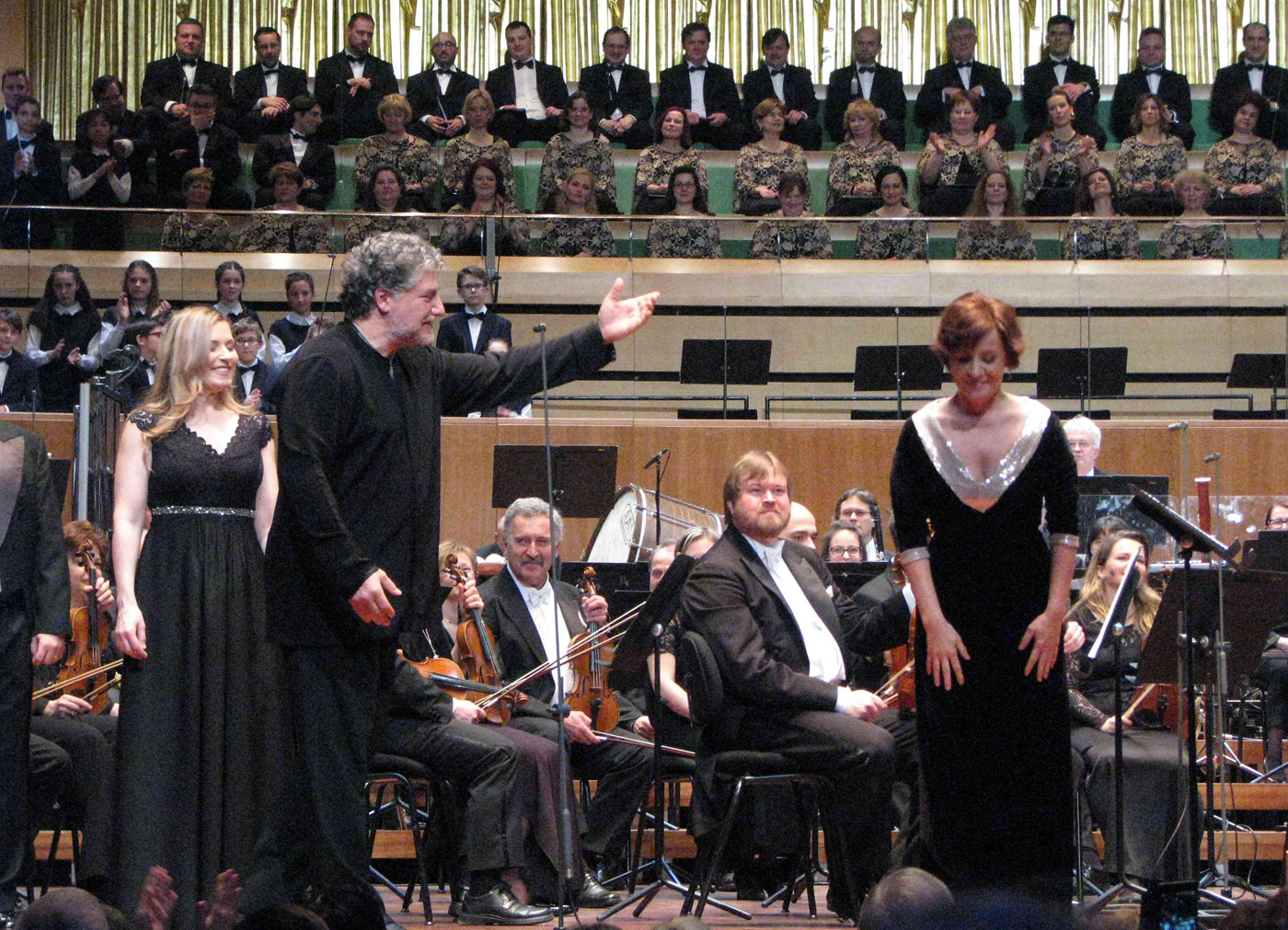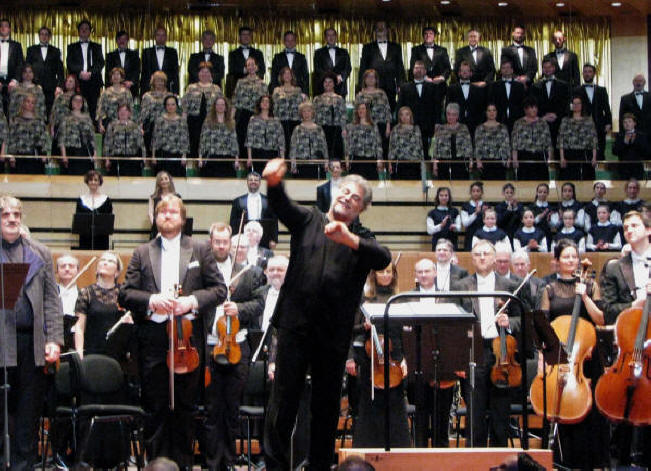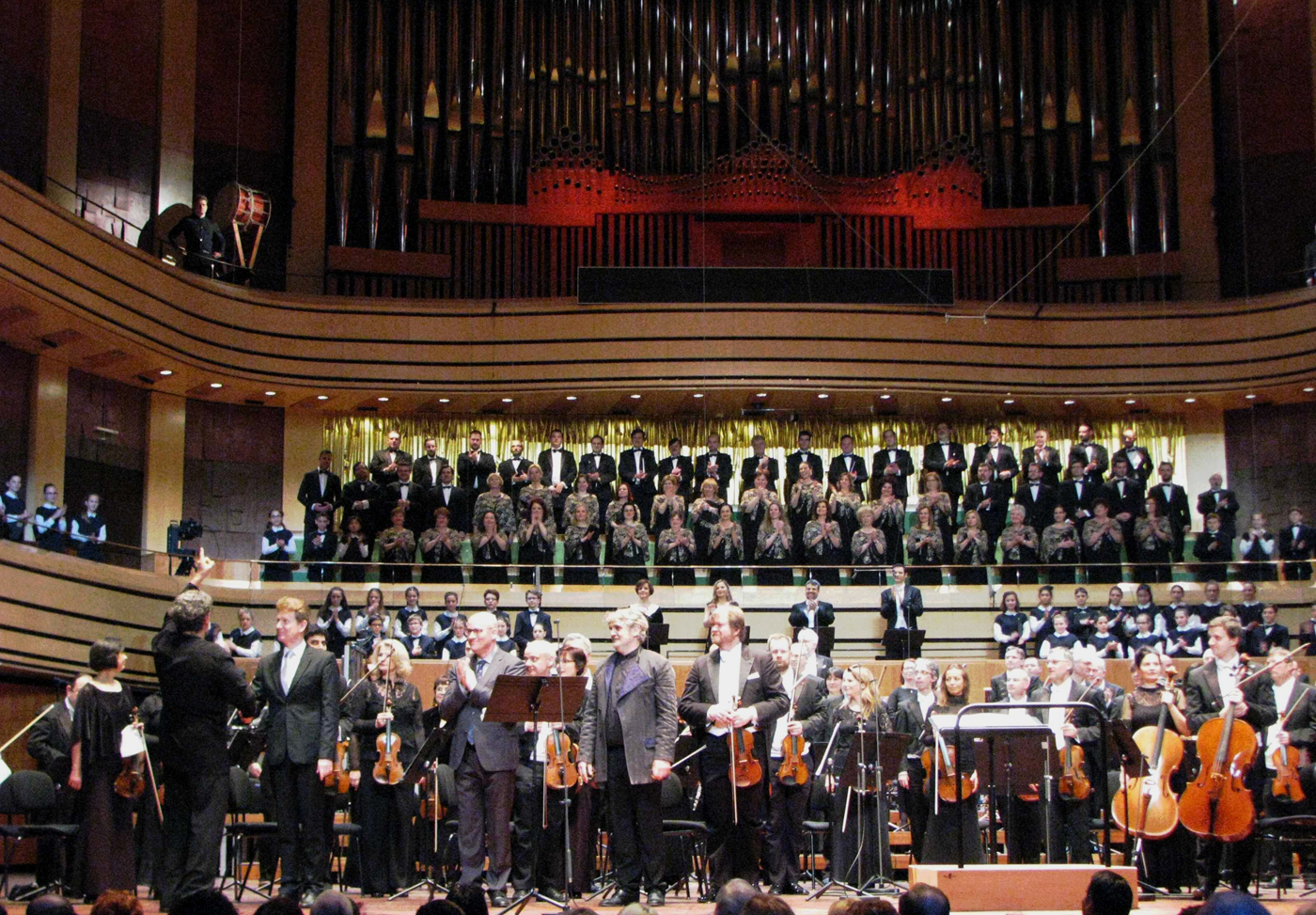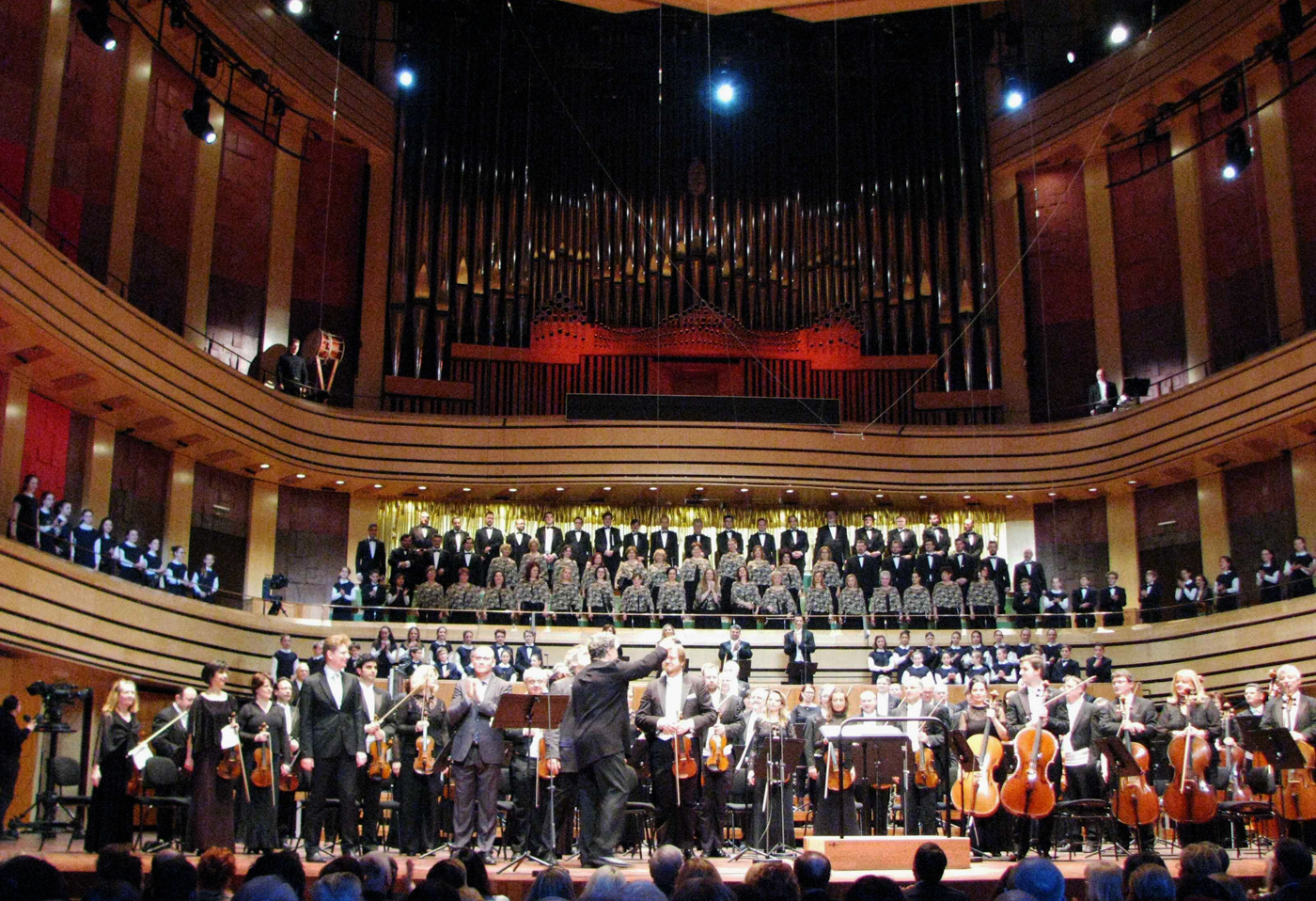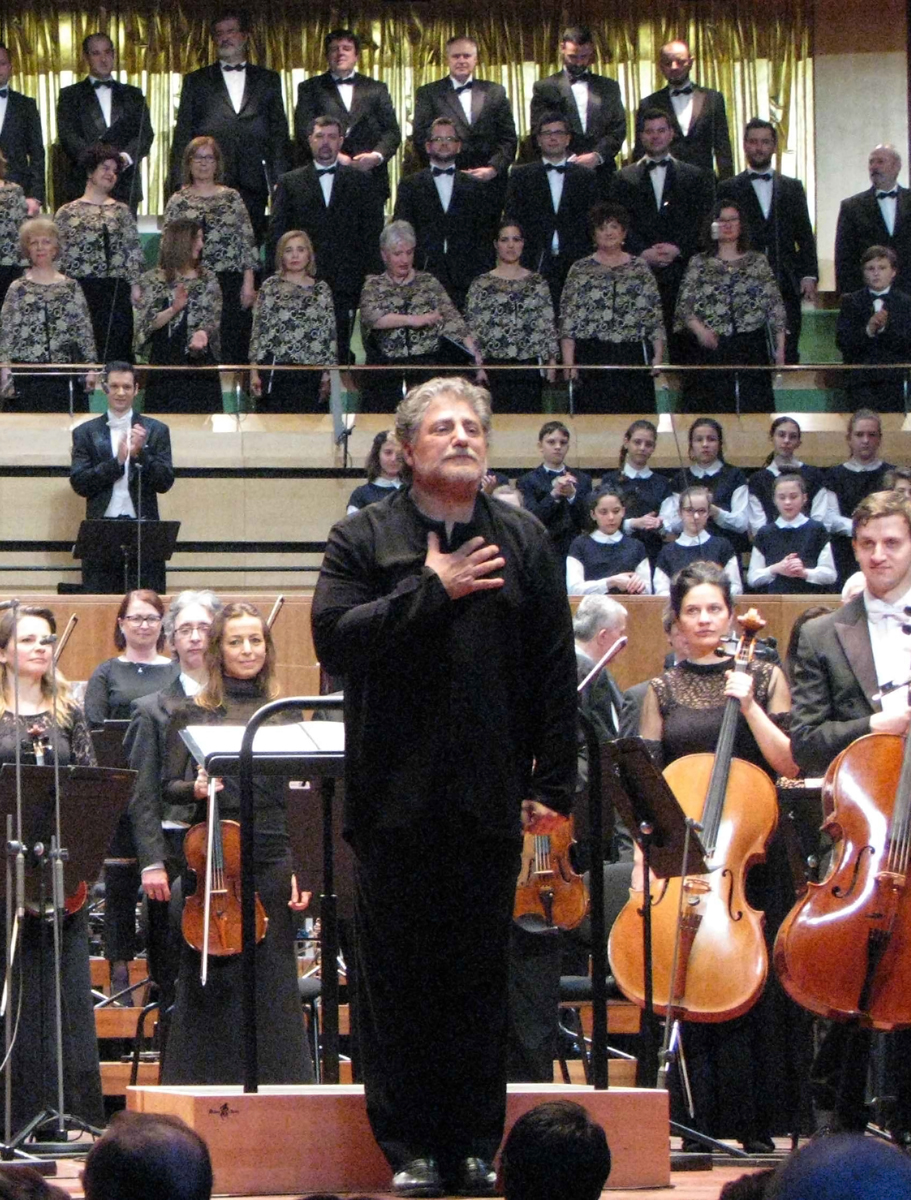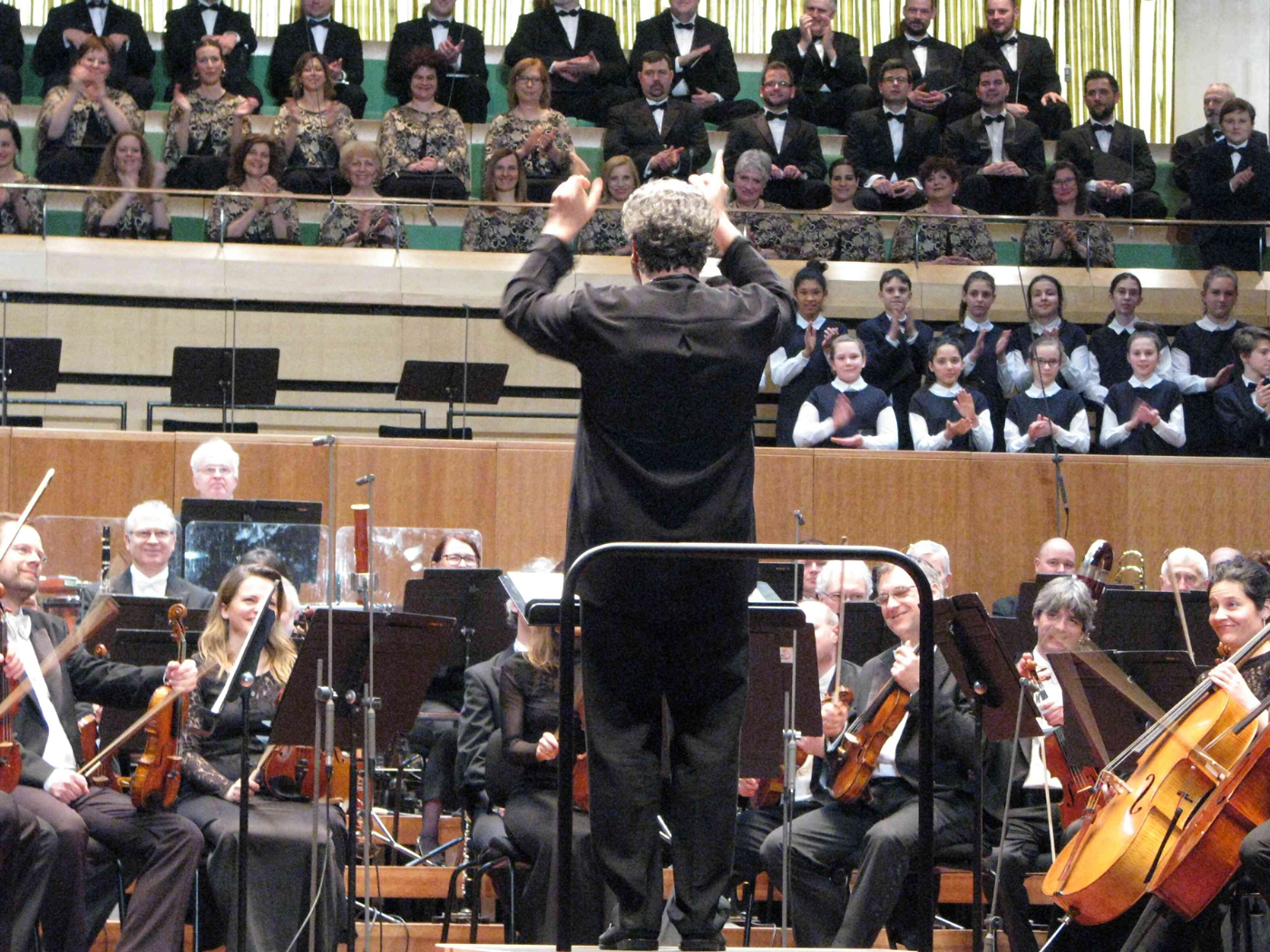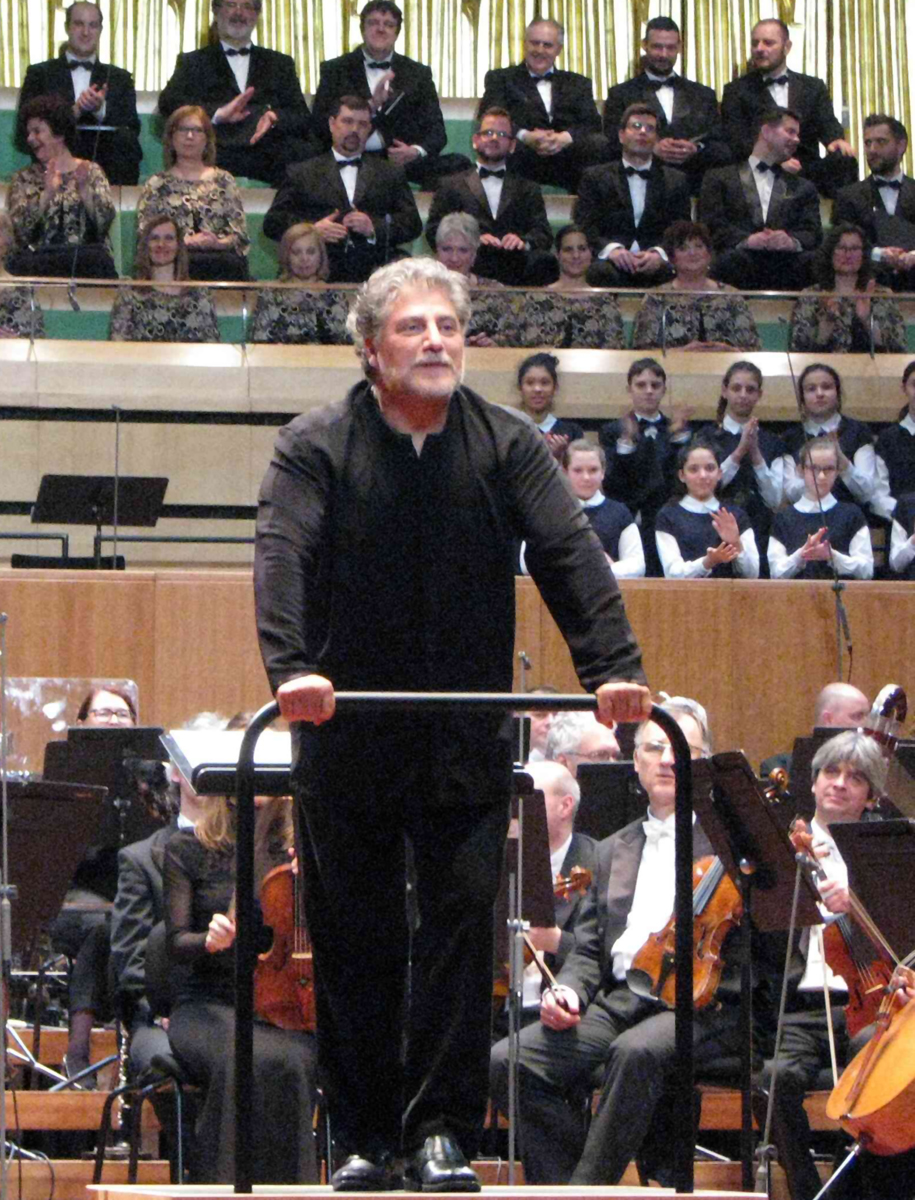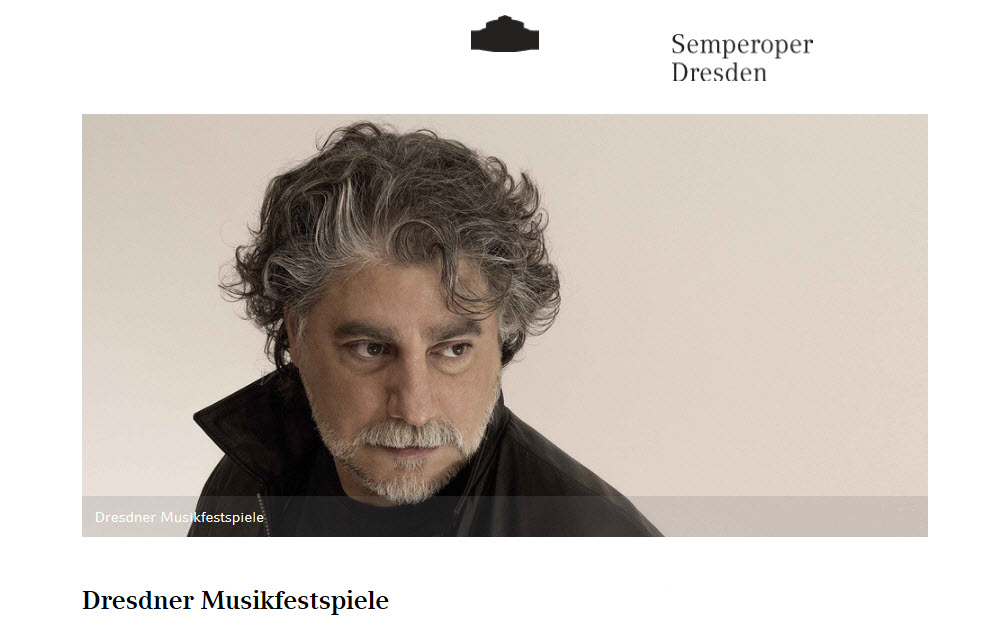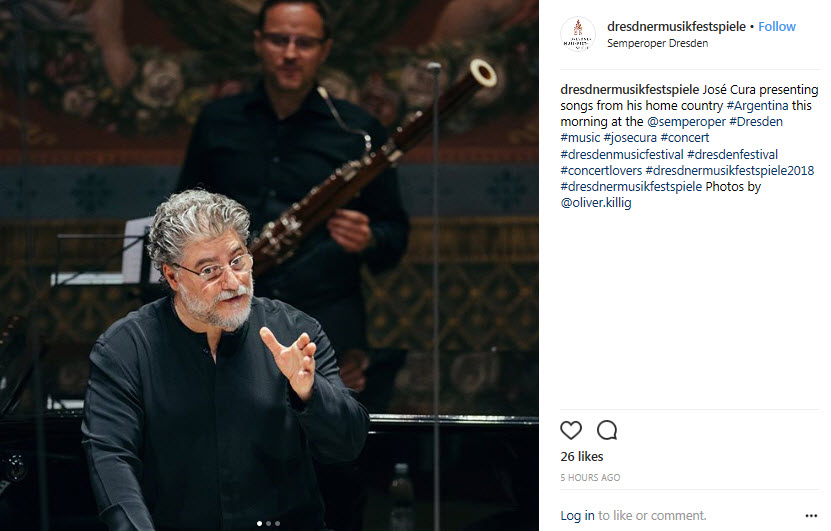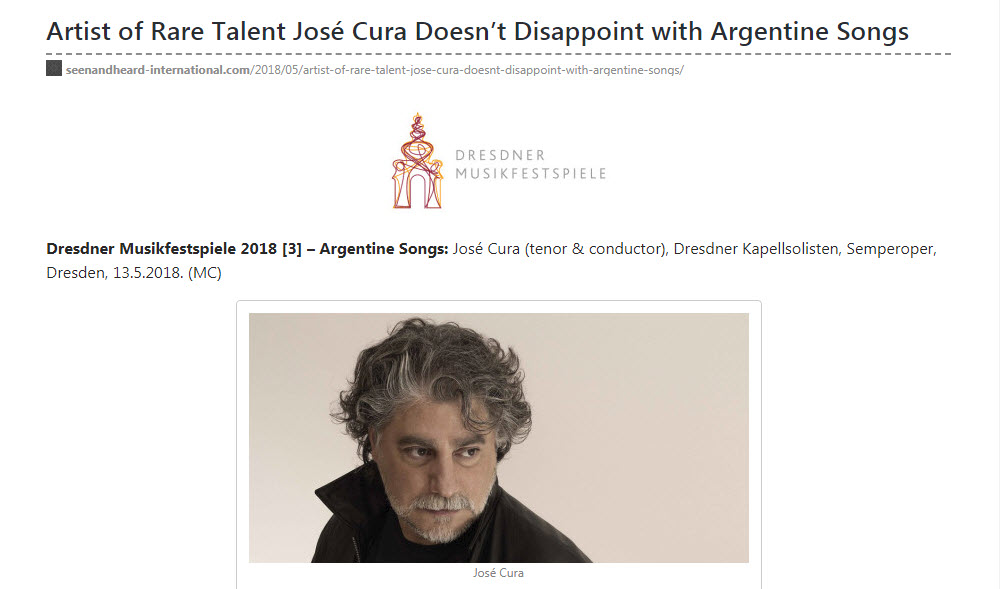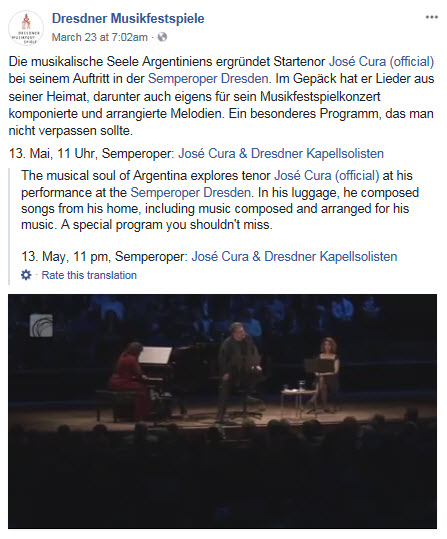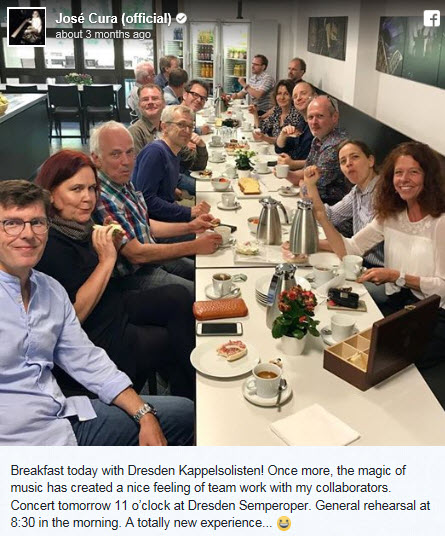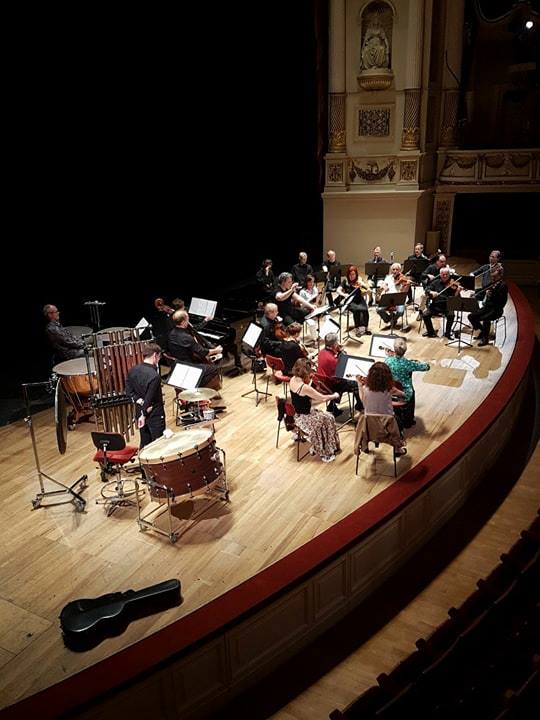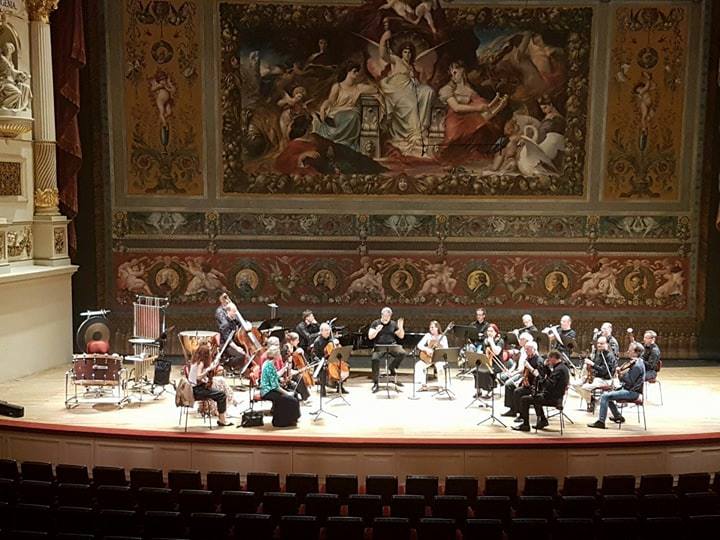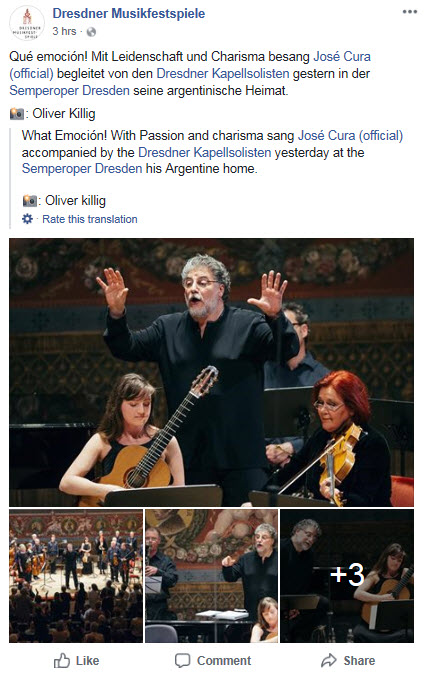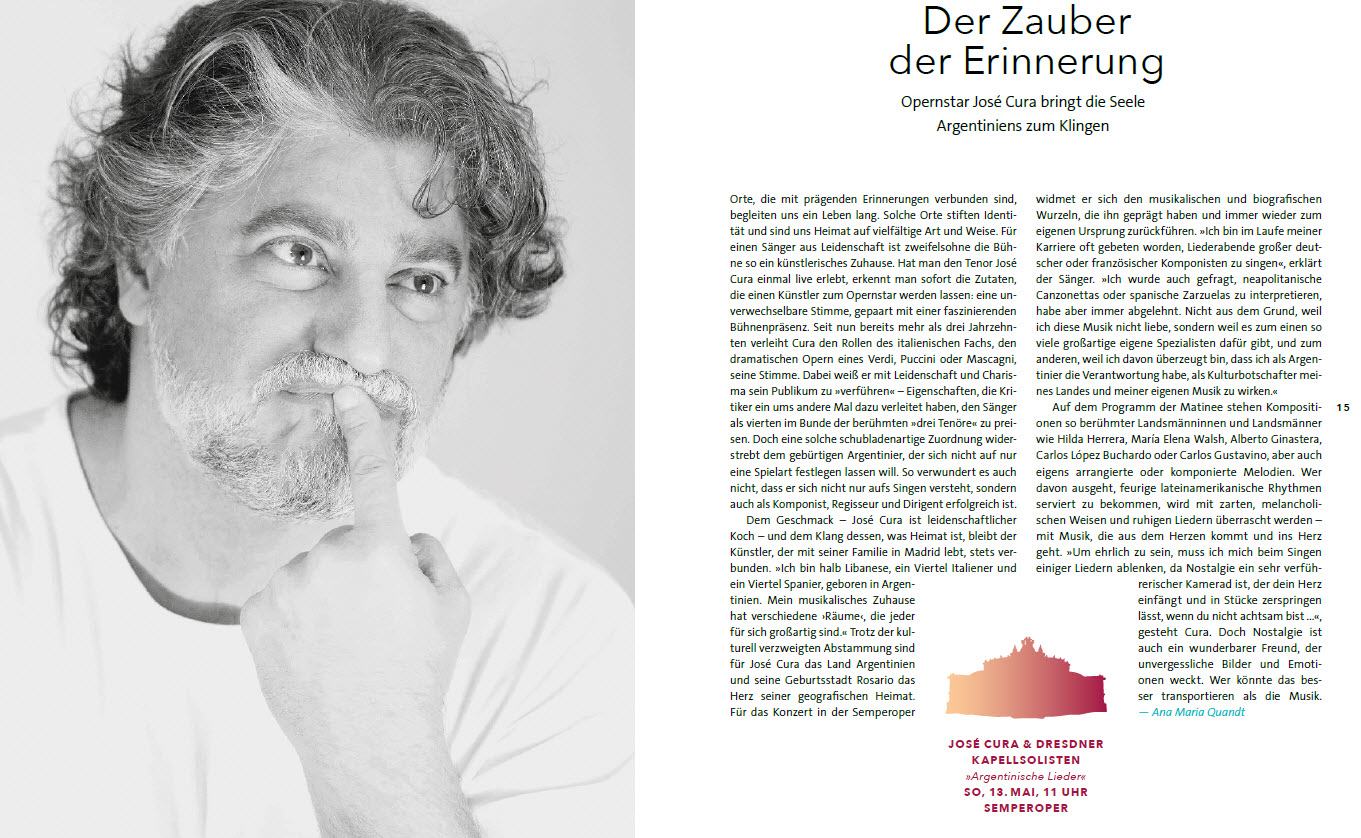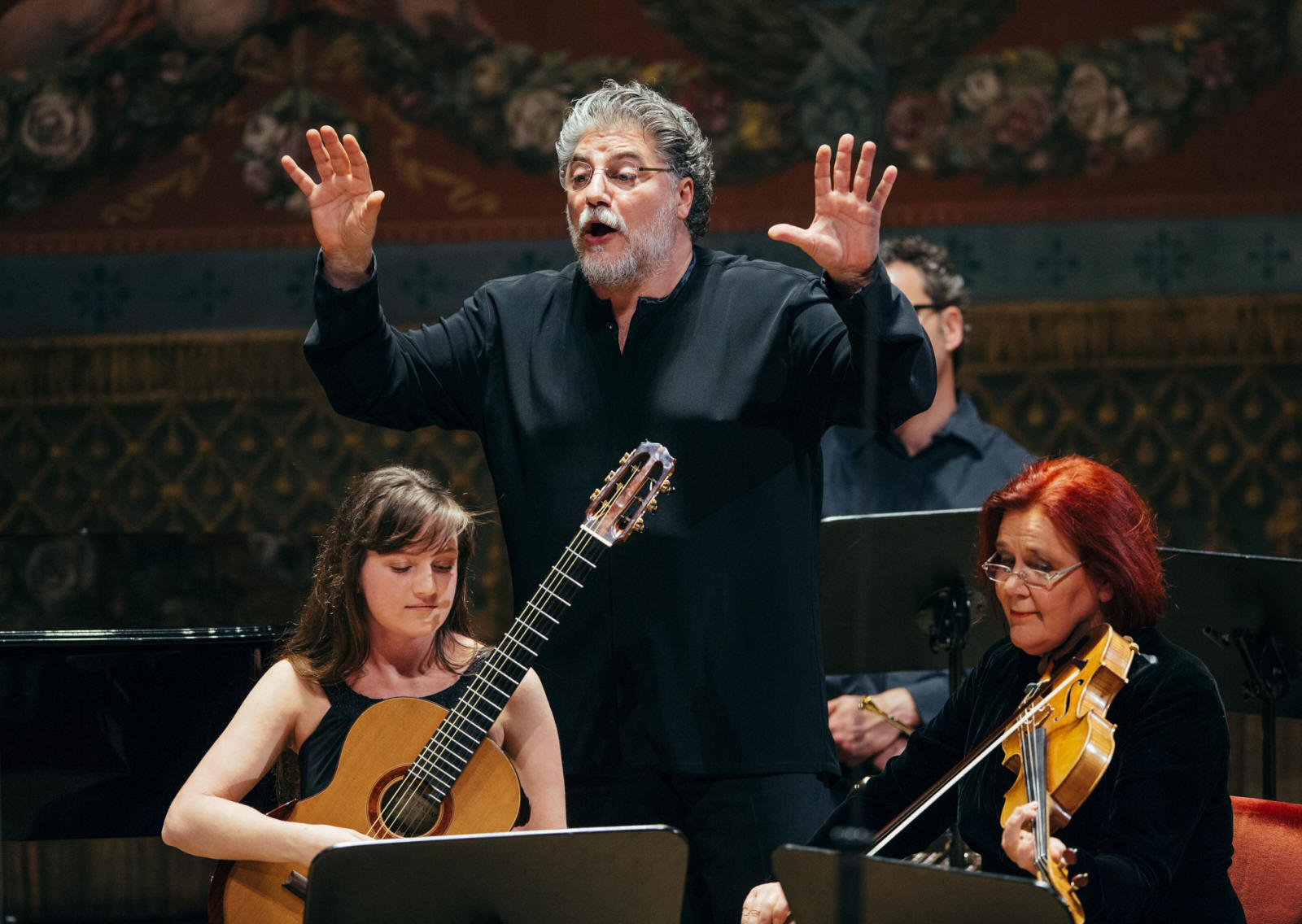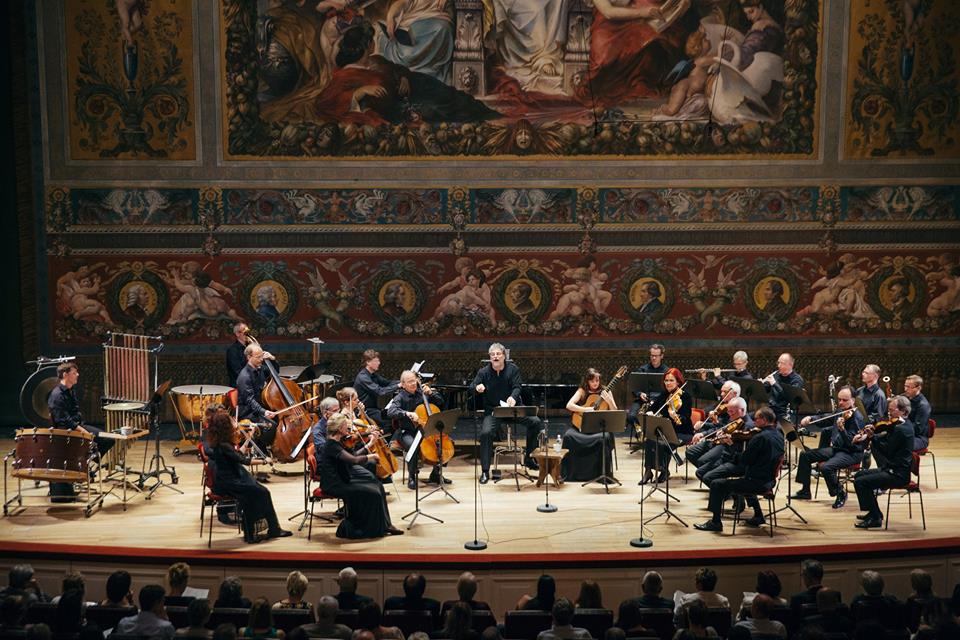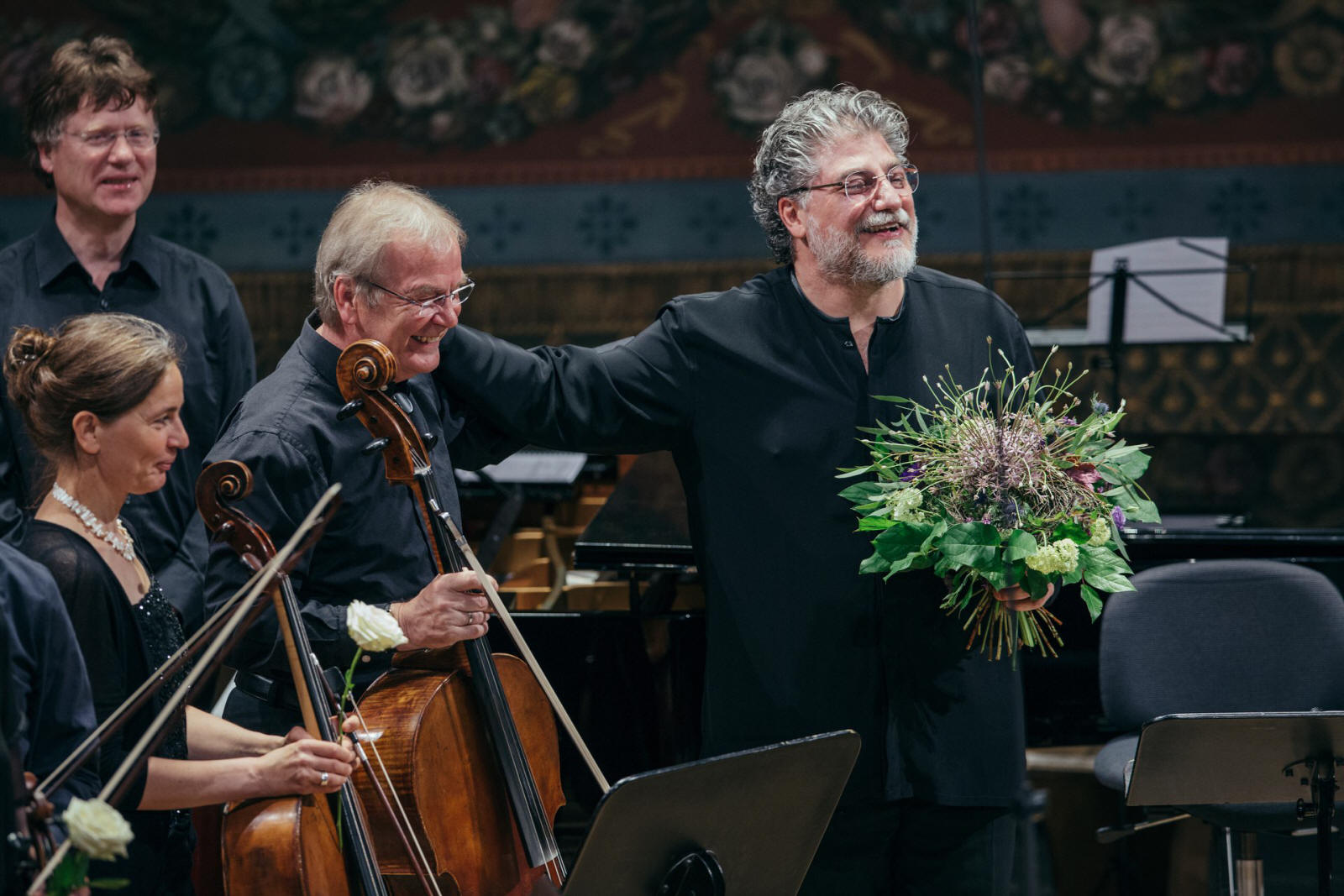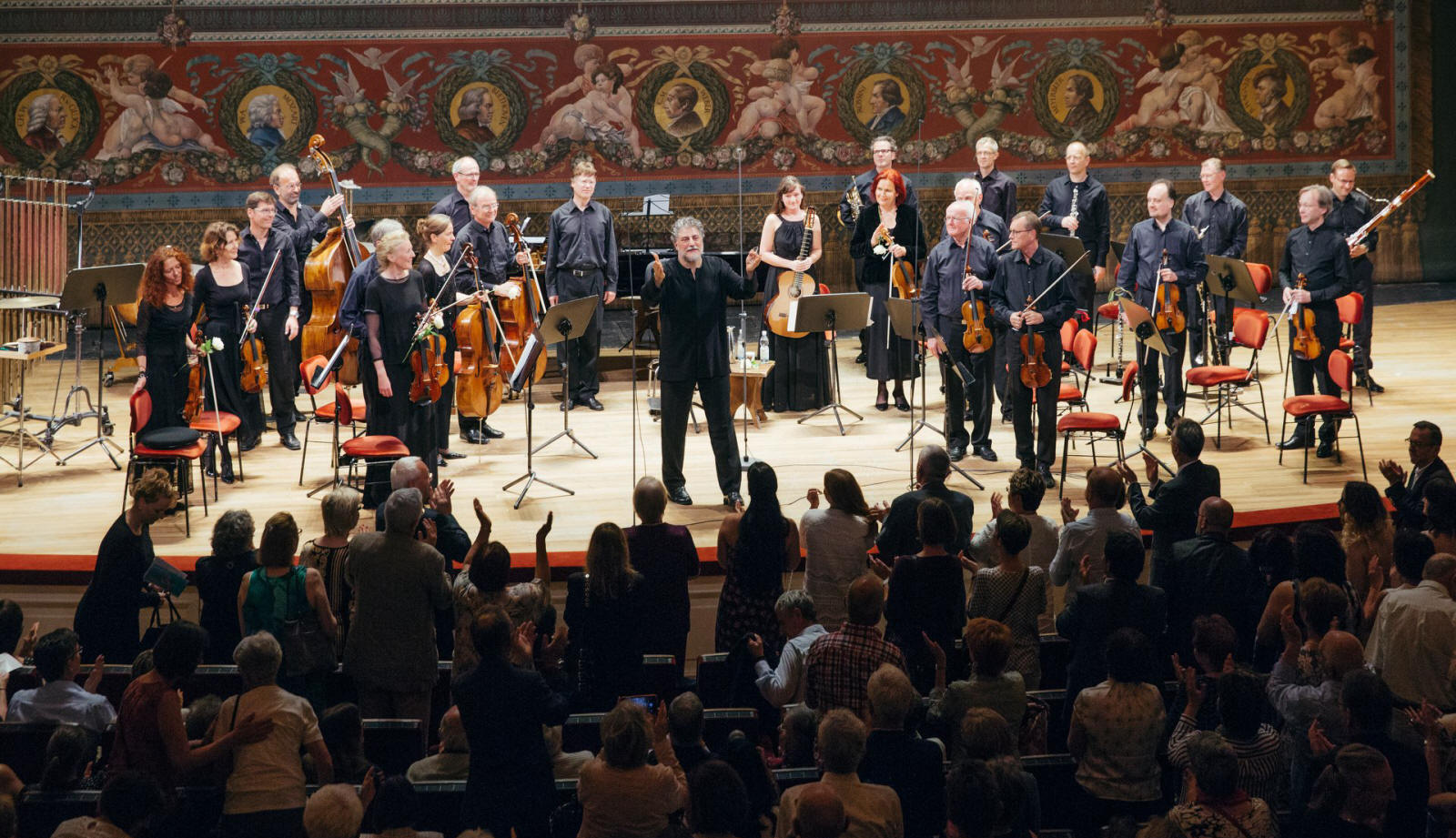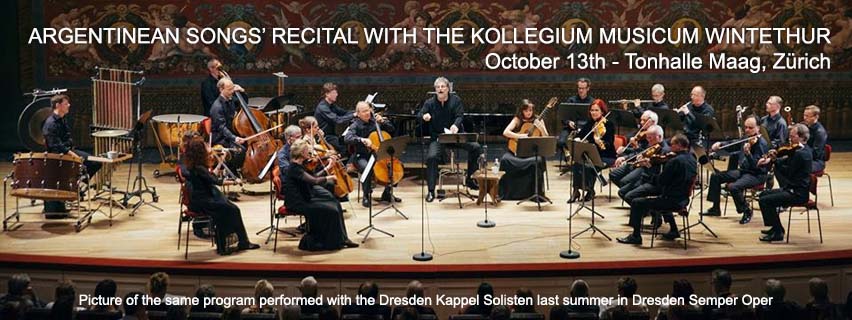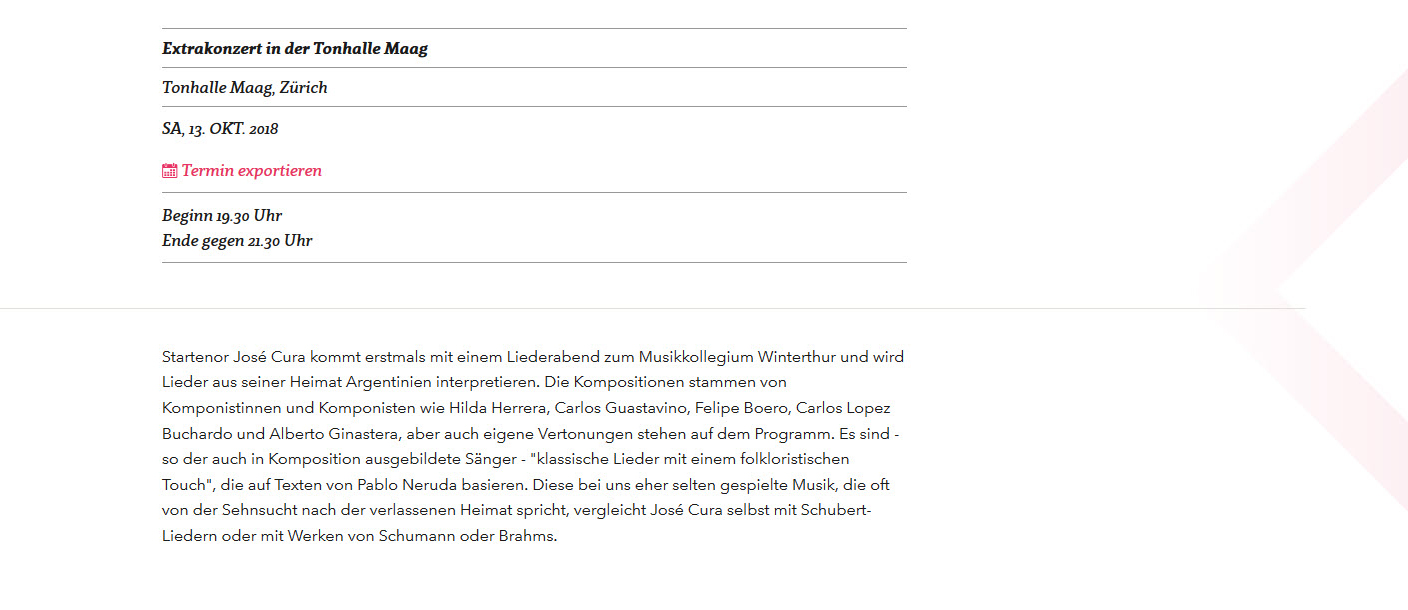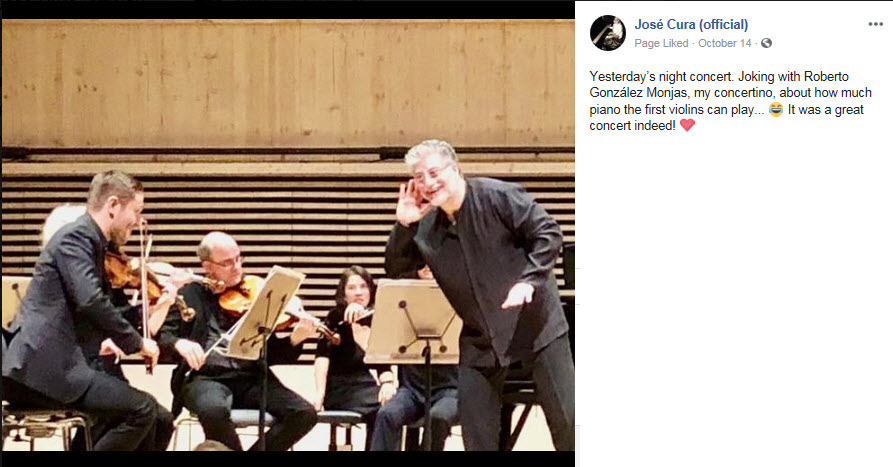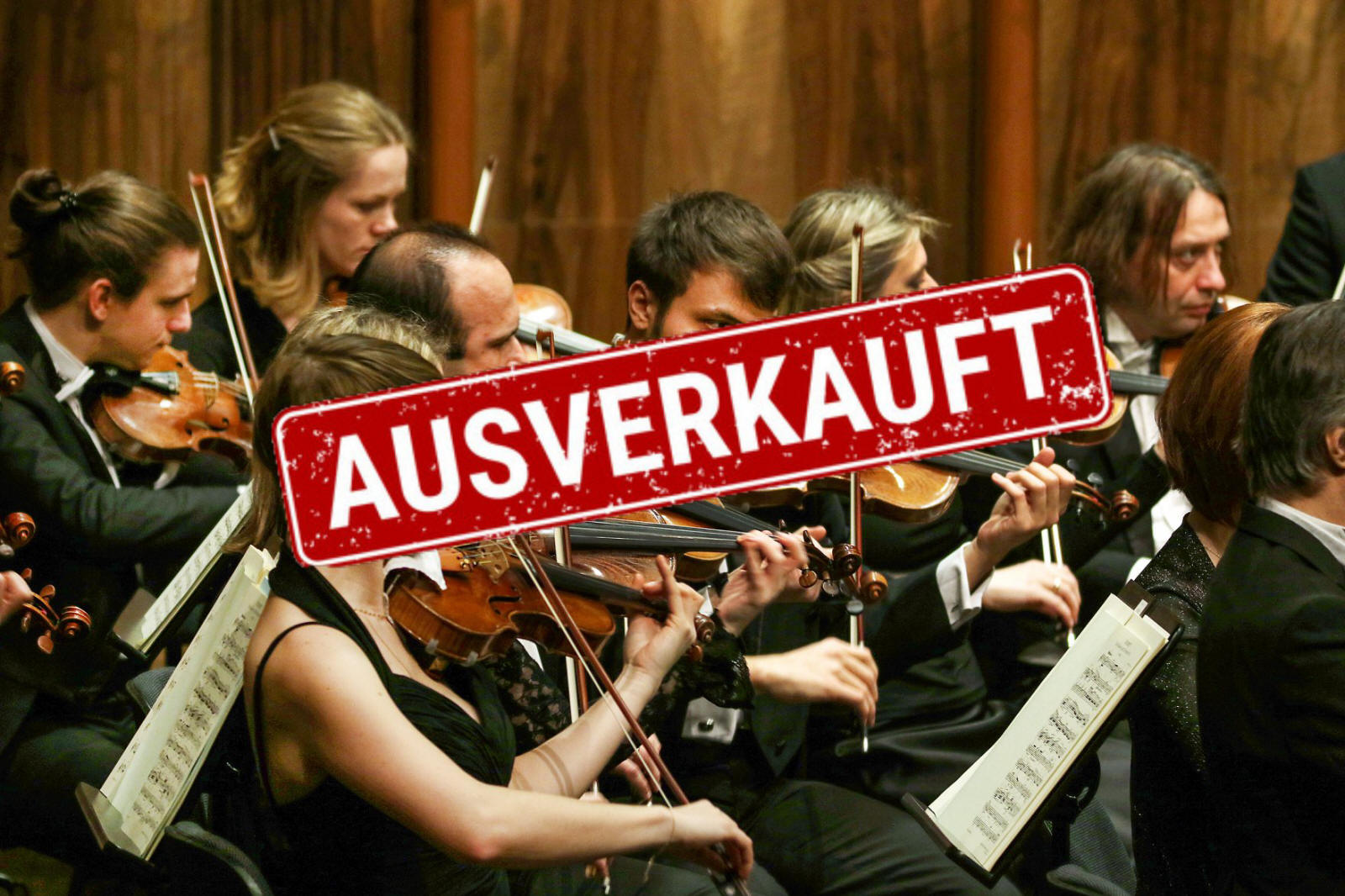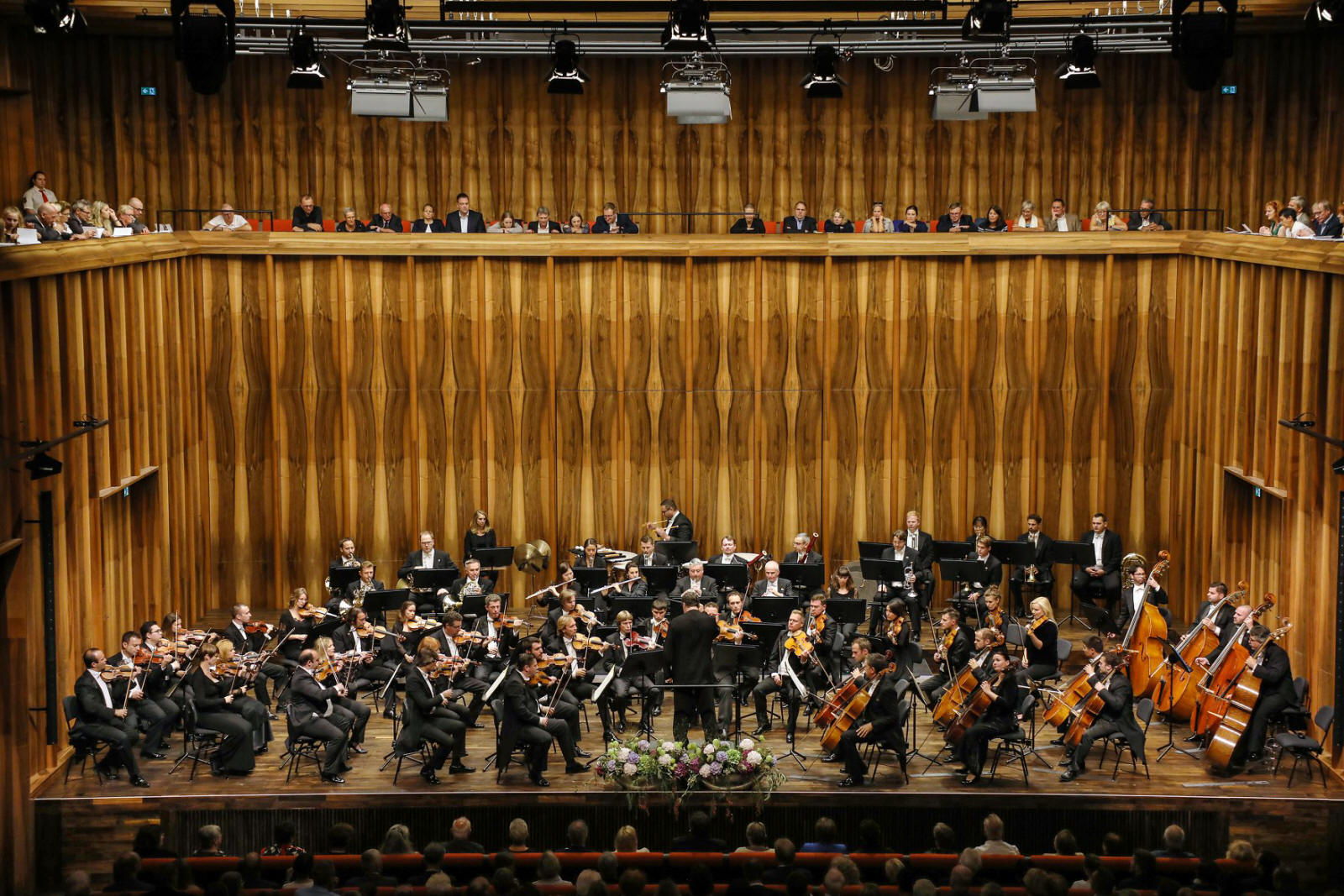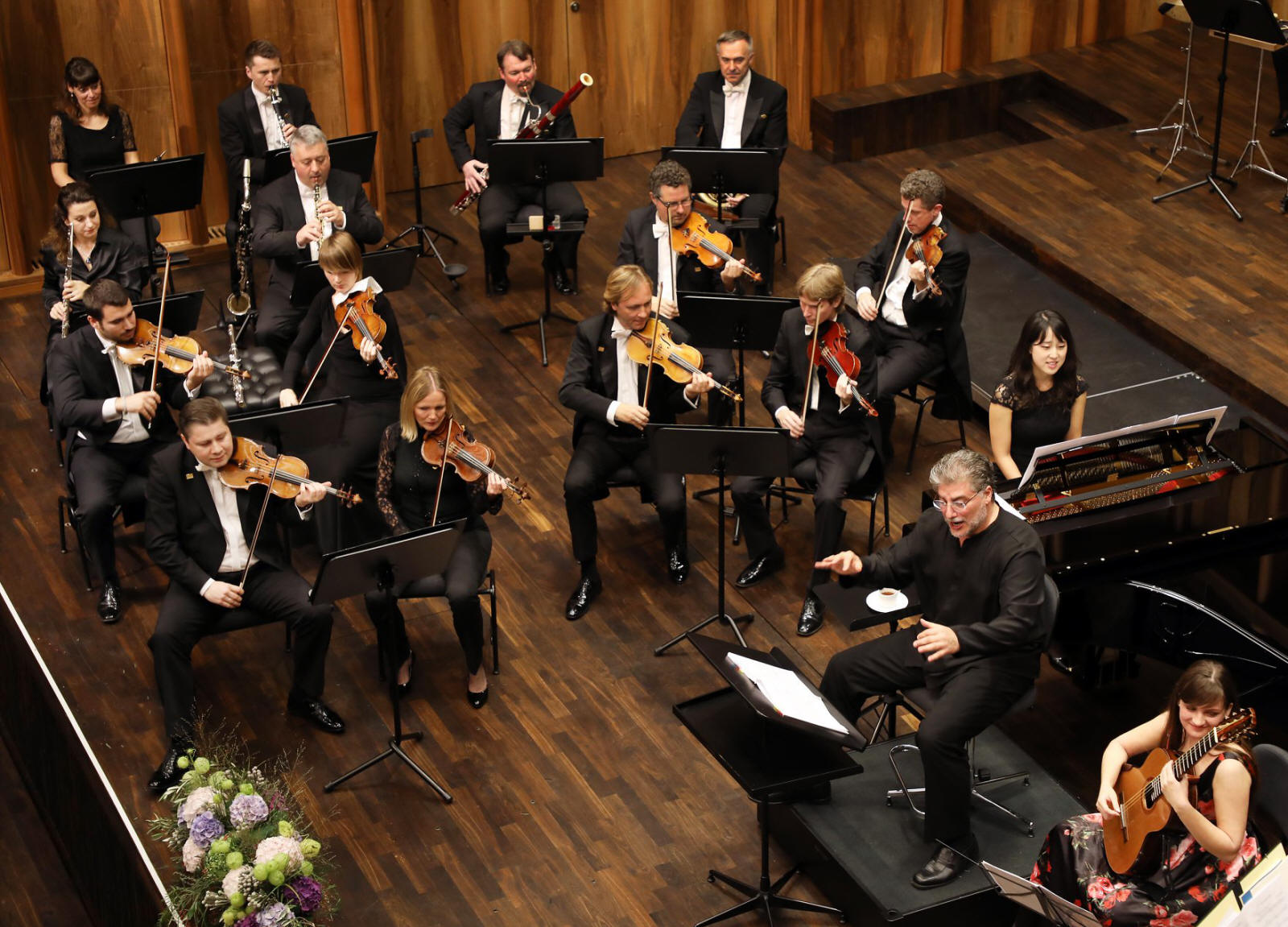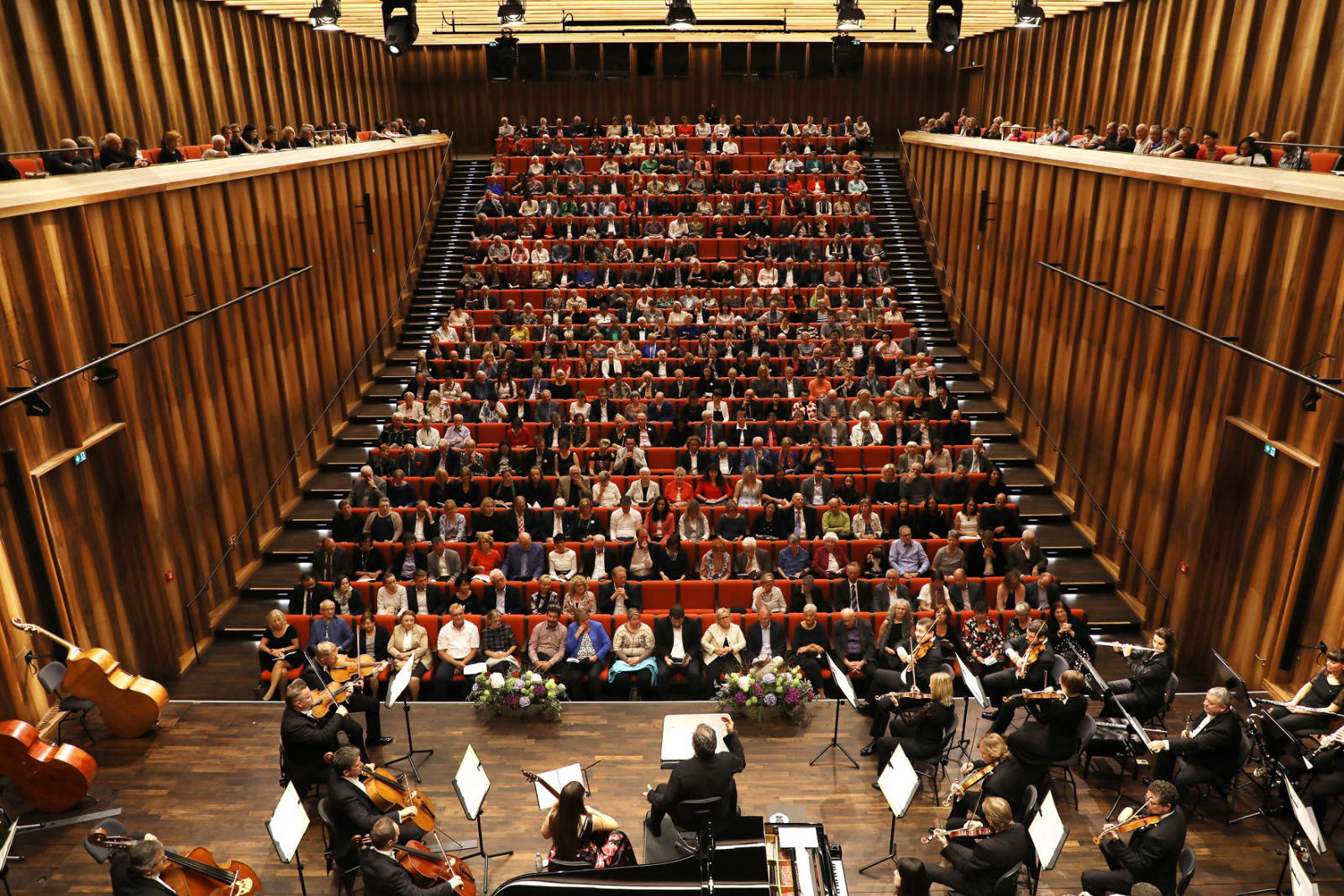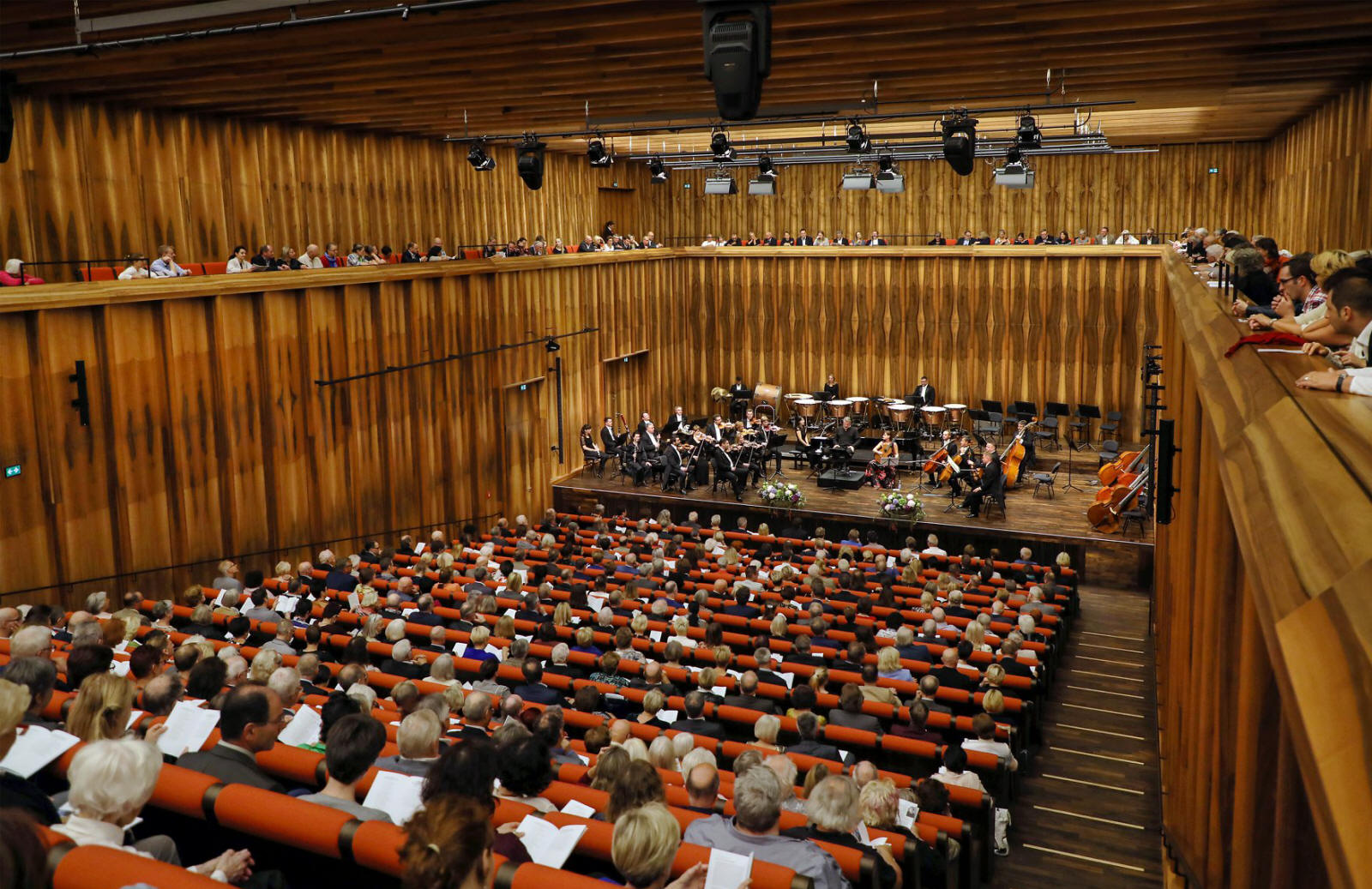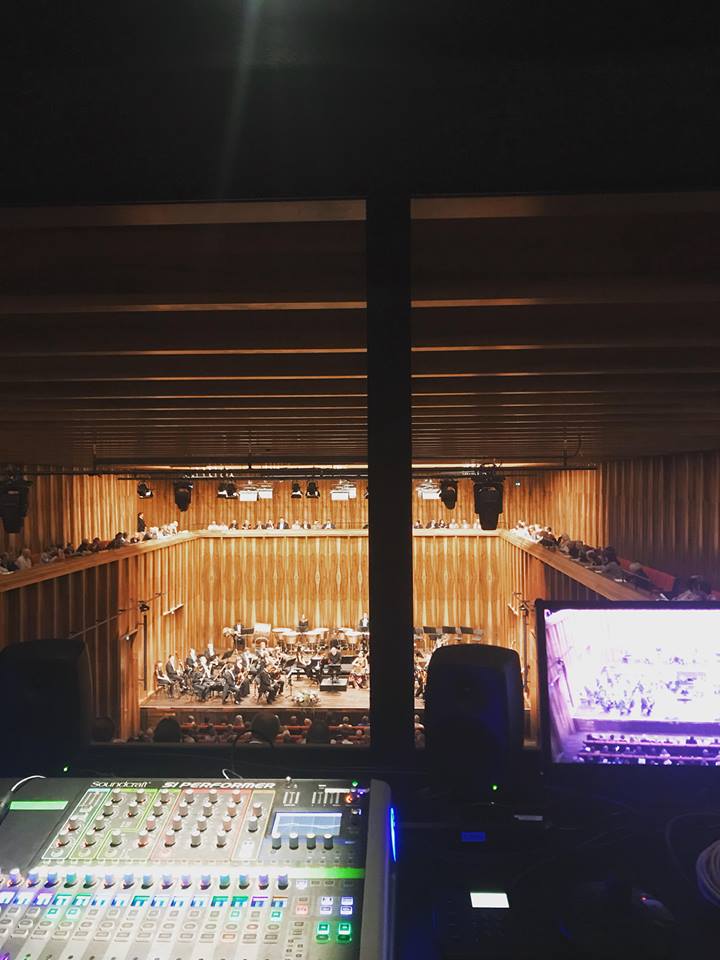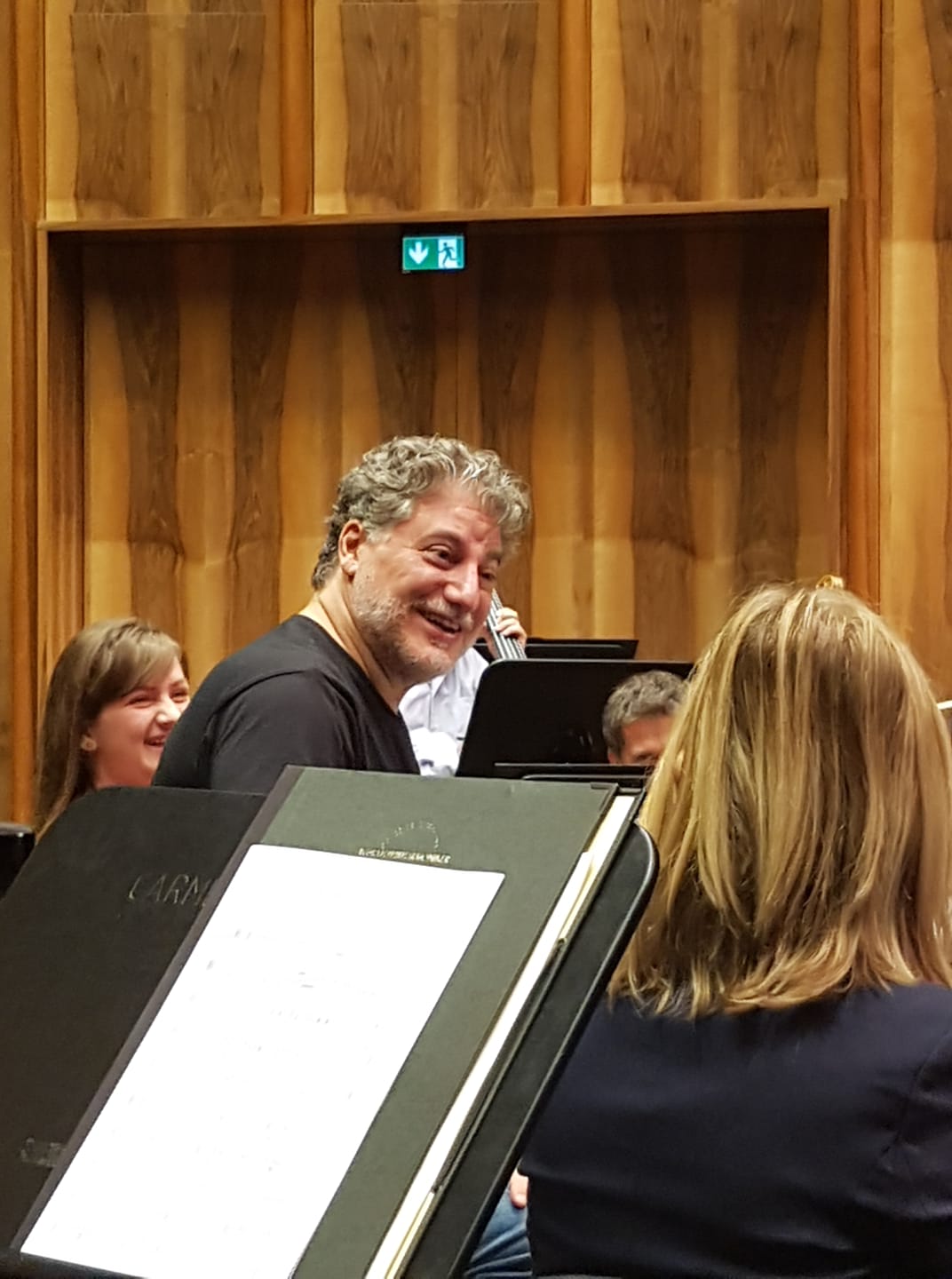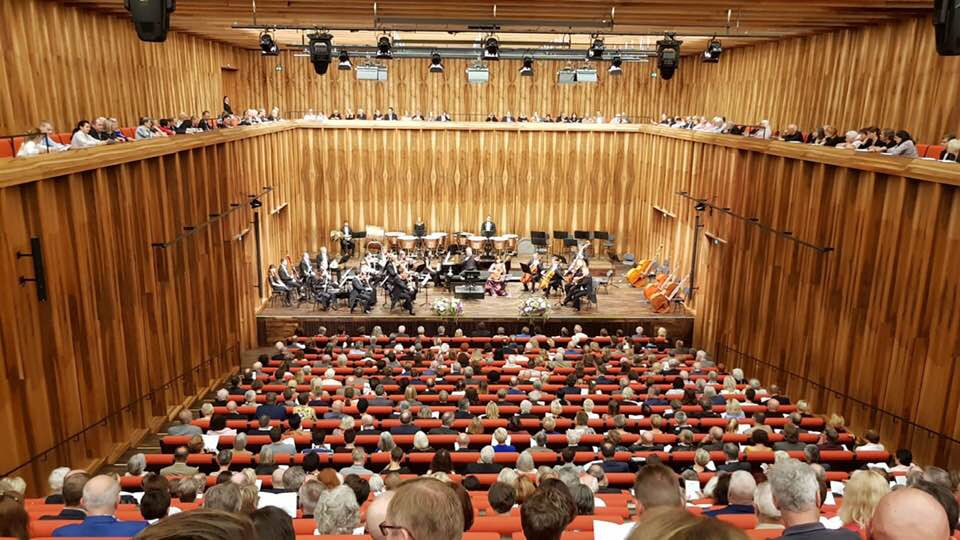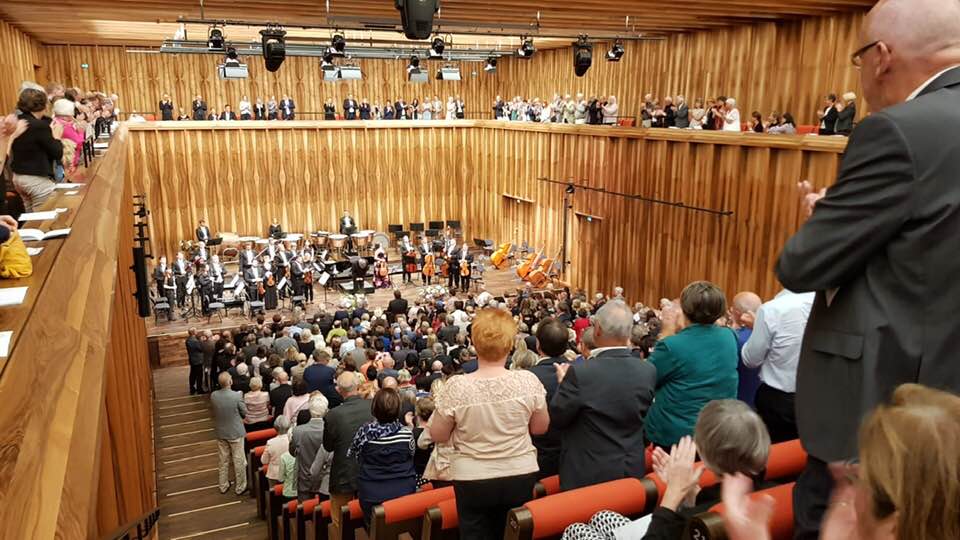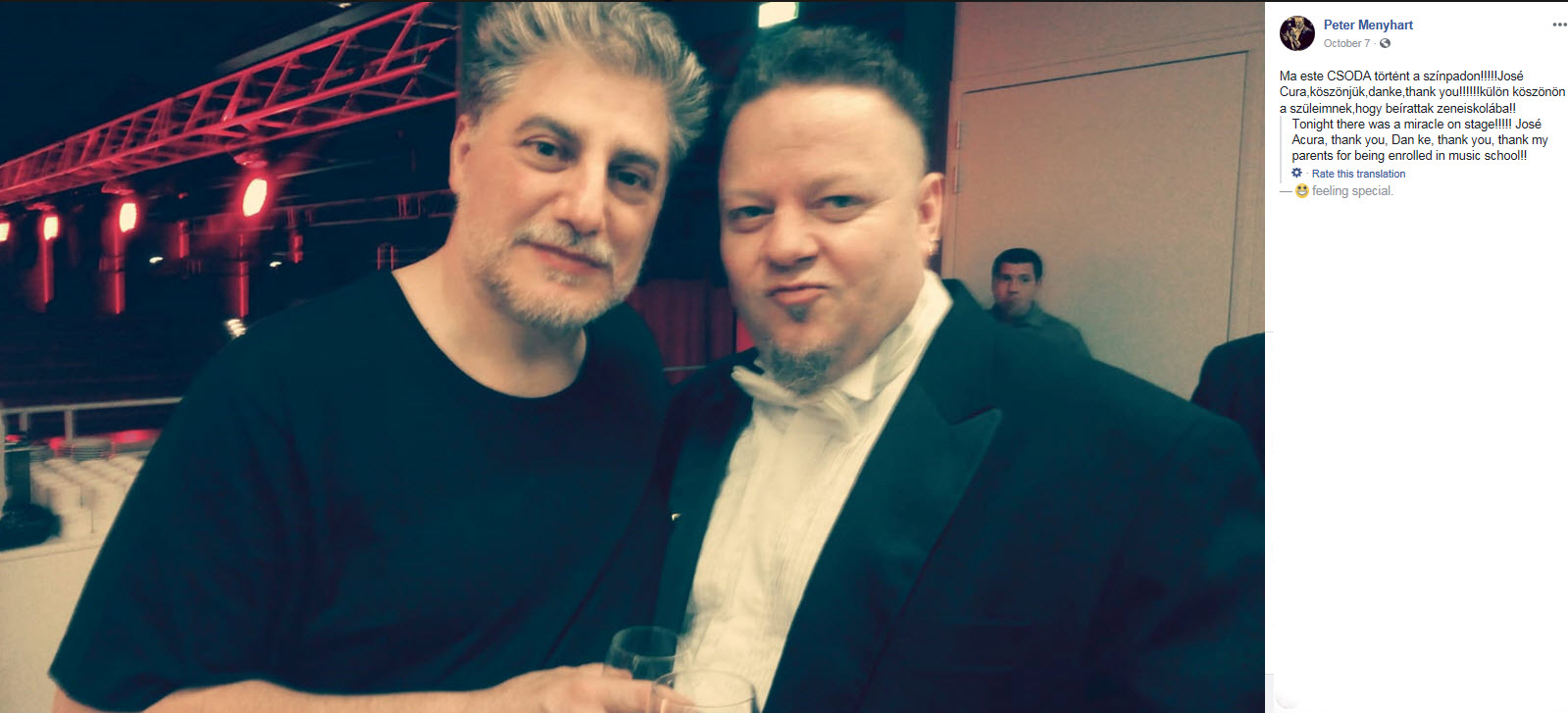|
"The Musical Universe of José Cura”,
an exceptional concert experience in MÜPA, Budapest joint production
of MÜPA Budapest and Salva Vita Foundation
29
March 2018
Report
and Photos by Zsuzsanna Suba
After
his Otello production conducted in Győr in 2016, José Cura returned
to Hungary and Budapest again this time with a very original concert
program. The particularity of the concert was ensured since the
entire program of the evening was dedicated to José Cura’s own
compositions, his three oratorical works. So we really had the
unique opportunity to get acquainted with his musical universe. This
concert was held to honor the 25th anniversary of the establishment
of the Salva Vita Foundation. For 25 years the Salva Vita Foundation
has supported those with intellectual disabilities in finding their
vocation and integration socially. José Cura works with Salva Vita
regularly offering his help to popularize the work of the foundation
since 2008. This was his fourth charity concert here in Budapest for
this goal in the row after 2008 (Verdi’s Requiem), 2009 (J. S. Bach:
Mass in B minor) and 2013 (Argentine Evening). This concert was
jointly organized by the Salva Vita Foundation and Palace of Arts
Budapest (MÜPA). José Cura conducted his Modus and
Magnificat (written in 2016 and 1988) and sang the part of Jesus
Christ in his Ecce homo oratorio (written in 1989). He shared
the stage with the Hungarian Radio Symphony Orchestra, Choir and
Children's Choir (leading by Zoltán Pad and László Matos), four
Hungarian vocal soloists - Zita Váradi (soprano), Krisztina Simon
(mezzo-soprano), István Horváth (tenor) and Marcell Bakonyi (bass) –
and the Argentine conductor Mario De Rose, who conducted the second
part of the concert featuring Ecce homo. The monumentality of
this repertoire can be well characterized by the fact that Cura
worked with 200 musicians on the stage together during the concert.
The audience coming to the concert could watch the Argentine Flag at
the facade of MÜPA blown by the wind.
The chosen program of the concert represented splendid musical
interest taking into account the rare opportunity to enjoy
contemporary oratorical works dealing with vital questions. It also
carried excellent themes and timing to deepen our thoughts on Holy
Thursday before Easter and to force our souls for paying attention
to the objectives of Salva Vita Foundation. José Cura’s art and
music, his wholehearted commitment and high-level performance in his
amplified roles together with the great achievements of the
musicians acted as an exquisite medium throughout the evening for
these purposes.
It was a huge surprise and pleasure to receive and read the nice and
rich program booklet of MÜPA. It centered on a long interview with
José Cura, his thoughts about his works as composer and conductor,
his compositions, his opinions about contemporary music and theatre
including also summary information about the participated artists
and musicians. The concert began with a short and pleasant
introduction about the long activity of Salva Vita foundation in the
form of projected pictures and short interviews. Then the musicians
came to the stage and the program “The Musical Universe of José
Cura” started. It was also a very practical solution, that the texts
of the pieces were projected above the stage so everybody could
follow it without losing any trace of the music.
I’ve already heard all the three pieces before performed by the
Prague Symphonic Orchestra (FOK), Prague Philharmonic Choir and
Czech Children’s Choir Jitro in Prague with Cura’s leadership in the
occasions of various concerts according to his three year artistic
residency with FOK recently and admired their wonderful results and
successes. It was a delight to realize the achieved level of
perfection and beauty of his staging and interpretation here in
Budapest with Hungarian musicians. Cura’s words were faithfully
followed - “For me the only reason for music making is to create
magic!” -, he and the musicians perfectly applied this winning
password of success supported by the wonderful acoustics of MÜPA. It
could be a terribly difficult task to make these new pieces
understand and perform by the musicians deeply during the available
rehearsing period. They also had to save and adapt the result of
their fruitful cooperation of the rehearsals into the particular and
very favorable concert venue of the Béla Bartók National Concert
Hall of MÜPA with its huge place, amazing acoustics and sold out
auditorium. This concert hall is operating like a gothic cathedral
with its monumental, nicely illuminated inner space and stage
together with the finely coordinated, unique acoustic-system and
huge organ.
With Cura’s leadership, the obtained result was a miracle and it
created magic indeed according to the effect of its profound impact
and delight to the audience as they managed to solve this enormous
task beautifully. The audience was also affected by the striking
experience of thematic and musical enhancements as the three pieces
followed each other. Already in the first part at the end of
Magnificat enthusiastic jubilation was heard from the rows of the
auditorium and we happily joined to the really huge celebration of
the audience at the end of the concert, after Ecce homo. Our
frenetic and rhythmic applause didn’t decrease for a moment during
its almost 10 minute’s interval and we simply didn’t want to let the
musicians leave stage. Our enthusiastic acknowledgments acted like a
perfect finale of the concert. Altogether we were very proud and
happy that this event and its overwhelming success took place and
were achieved here with the participated very committed and
enthusiastic musicians.
All the elements of the concert hall were utilized when Cura placed
the soloists at the center of the lower gallery of the stage and he
surrounded them with the children’s choir. It highlighted the vocal
performance of the soloist while gaining more fragility in the
combined vocal sound especially in Magnificat with Mary in
the central role. The large adult choir stood on the upper gallery
in three rows and we could see the two huge drums (including the so
called Japanese “big drum”, the odaiko) above them on both sides of
the stage, on the balcony. The symphonic orchestra had spacious
place on the huge stage. The soloist Cura stood at the front of the
stage in a slightly inclined position toward the audience in Ecce
Homo. It was a really effective and original arrangement indeed.
All the three pieces radiated a kind of solemnity and sublimity
while we were forced to breathe their dramatic contents supported by
the wide dynamic and instrumentation range of the music. Cura’s
first piece (Modus) was inspired by the atmosphere of the
medieval Prague and based on the musical variation of the main
recurring Kyrie melody from the 10th century. It recalled the purity
and beauty of a Gregorian chant. The man choir and especially its
bass section was targeting here virtuously. The piece began with the
impressive ensemble of the gently male voices and highlighted their
enchanting sound for a while. Then it turned into an ever-growing
and polyphonic, multilayered musical performance thanks to the
gradual joining and contribution of the dark sounds of the orchestra
and other vocal parts of the choir. The haunting melody captivated
us with its many appearing forms as it was just picking up,
celebrating, releasing or repeatedly playing as a “mantra-like”
sequence in various circles. It prevailed on our senses giving
pleasure for the ears with the wide variety of the authoritative
sounds of the double basses, strings, little bells, drums, other
instruments and human voices. These elements together borrowed a
nice dignity, harmony and mysticism to the music. After the
well-built, striking climax in the turmoil of intensifying sounds,
the music returned to its starting phase again with its fading,
wonderfully pure melody, this time produced by the flutes. This
nicely complex and serious piece absorbed our attention deeply with
its 15 minute’s length, sublime sound and innovative music. All the
singers, musicians and our conductor did an excellent job here.
Great applause granted them.
The second piece of the concert, Cura’s Magnificat (1998) had
approximately the same length of Modus. It was inspired by the birth
of his first child. According to Cura’s words “The Magnificat,
in my view is, certainly, the quintessential Marian Song of
Exultation, but it is also the song of an adolescent Mary, full of
dreams, as well as fearful of what was to come.” The oratorio
began with Mary’s voice and Zita Várady’s fragile soprano and warm
vocal lines acted perfectly giving central weight as well delicate
guideline to the story and the surrounding children’s choir, adult
choir and orchestra. The very accurate, crystal clear and
beautifully sounding children’s choir added an unrealistically glass
and graceful presence for the vocals like an accompanying,
reinforcing angel choir. It was a very emotional performance; we
were targeting with the whirlpool of emotions from every side of the
participants according to the reactions of the young Mary and her
environment. Many feelings were flowing around us; expectation, joy,
fears of the unknown, disbelief, astonishment, gratitude and
celebration. The news about the incredible miracles and its
consequences was spreading like a gossip in more waves. The latter
gave the main structure of the piece and it appeared as a really
novel, rhythmical and returning musical sequence produced by the
dynamic competition between the razor-sharp, fading-growing,
whisper-shouting declamation of the choirs (“Fecit
potentiam in bracchio suo..”),
and the scream-like, exalted and very exciting orchestration of the
accompanying orchestra. Their culmination was masterly timing in a
frozen, unshakable climax and silence and then, the dramatic
sequence developed again with even greater force and tension. Among
the different participants, Cura brilliantly used the various vocal
parts and their complex interaction with each other and other
instruments like the little bells and strong drums in the sound and
creating the atmosphere. The conclusion radiated hope, power, faith
and greatness of the future in the ever-growing, reinforcing words
of the choirs and a God-like, bass voice citing “Gloria
Patri, et Filio, et Spiritui Sancto…”
accompanied by Mary’s and the choir’s repeating words (“Magnificat,
anima …”). I think that this music and the quality of the
performance really surprised us and we were prompted to express our
immediate acknowledgment for this enjoyment with long applause and
many shouts of joy before the intermission.
The second part of the concert featured Cura’s longest piece, the
Ecce homo oratorio with its almost 40 minute’s length. It talks
about the last moments of Jesus Christ’s life in a dramatic
arrangement of an almost operatic theatre. Cura visualises Jesus
Christ ’s more human side, his sincere feelings and visceral despair
here alternating this with his relationship of the mythical depth
related to his divinity. Cura also combined some crucial moments of
the Passion and Stabat Mater in one piece delineating also the
greatest pain of Mary and her human side seeing her Son’s cruel
death.
The oratorio started with a verse written by Cura (“There was
once a king”) and it was sounded from the loudspeakers in the
performance of the famous Hungarian actor, Sándor Lukács. He gave us
his unique, velvety dark voice and his brilliant interpretative
recitation here. Then we were surrounded by an extremely dark and
densely woven polyphonic and multilayered musical texture produced
by the orchestra. This music beautifully conveyed the atmosphere of
mystical insecurity and omnipresent danger, the sinister and bad
premonition of the upcoming events at the beginning (“Quando
corpus morietur..”). Soon we heard Christ’s desperate, weeping
words talking about his questions, pains and fears (“..Salvum me!”).
Only the children’s choir gave some relief and ease with their
sublime sound. Then we felt the different stages of the ever-growing
human wickedness as the trial began and progressed, the suffering of
the innocent soul and body, the fulfilment of God’s will, the final
pains of the Son and his Mother. The dramaturgy and instrumentation
of the music expressively suggested to the listeners that we are
inevitably moving towards something irreversible. In José Cura’s
tangible embodiment, Jesus Chris acted in various roles, as a
commentator, a prophet, a suffering soul and body at the same time
who begged for mercifulness. In the growing turmoil of the ensuing
sequence of betrayal, trial, condemnation and execution, the
reaction and responses of the cruel crowd (“Crucify him!”...)
and begging of Jesus Christ (“Elí!!...”) created an
exceptional dramatic theatre as the various musical elements of
orchestration and human voices interacted with each other including
God's commentaries in the duels’ of the drums. All this culminated
in an expansive musical climax of great tension. Then at once the
cutting of the powerful swirling of the sounds was brilliantly
succeeded in the air so the sudden silence seemed to carry an even
bigger pressure and more dramatic moment. Then from this sudden and
tremendous silence, the transparent dialog of the children’s choir
and female choir emerged together with the impressive and
crystal-clear melody of the Stabat Mater accompanied by the soloists
and the beautiful trumpet, drums and orchestra.
The rest of the piece announced and highlighted the delight of
different vocal layers and tones including another sublime solo from
the soprano in the grief of the Mother. Christ’s words calmed down
as he reconciled to his fate and soon we heard his last, final
breath. Then the first, dark and unrestful motif (“Quando corpus
morietur…”) were sung and played again by the many layers of the
vocals and orchestra together with the steady presence of drums and
bells. This newly tensed moment changed into a peaceful harmony of
the vocals (“Paradisi Gloria”) led by the wonderful
children’s choir. Then using a final twist the music and tension
started pulsating and exploding again just to conclude it into a
very airy, gently sight of “Amen” sung by the children with
the confirming sonority of the light bells, warm organ and the last
beat of the big drum.
The tenor solo in José Cura’s stunning interpretation and vocal
performance was able to delineate not only the almost unbearable
tension, despair and pain of Jesus Christ, but also the motives and
colors of his forgiveness and hope toward the people. Along with the
applied variations of the colors and tones of his unique voice and
timbre, every moment of the changing dramatic content of the story
was also embodied and followed by his whole physical attitude and
vocal acting and it gave the very solid, main pillar to the
oratorio. All the choirs, the four soloists and the musicians also
rendered a really precious, bravura performance in their roles. The
conductor, Mario De Rose led the orchestra very precisely and
effectively and contributed greatly to a faithful and very emotional
interpretation.
When the oratorio was finished, after some genuine moments of deep
and touching silence of restrained human breathes in the auditorium
you suddenly heard the roaring applause of the audience which had a
permanently maintained huge and cheering intensity and unconditional
acknowledgement. I’ve never heard such a heartfelt and exuberant
reaction from the public here in MÜPA for a long time even knowing
our notoriously enthusiastic audience well. The amplitude, intensity
and warmth of the frenetic applause and celebration of the public
didn’t decrease for a moment during its almost 10 minute’s interval
including shouts of joy and bravi. You could see José Cura’s
touching disbelief first, then the delightful pleasure as well as
the running emotions on his face and in his eyes. Of course he was
forced to come back to the stage endlessly again and again in more
run. He did his best to pass the celebration toward his colleagues
and musicians highlighting all the participants in the hall and
behind the preparation of the concert individually or as a team
including the choirmasters of the various choirs. The magnificent
musical unity and realization of the chosen sequence of the
compositions and especially the enormous impact of Ecce Homo,
Cura’s devoted work and passion behind the performance and the
beautiful, absolutely brilliant contribution of the musicians and
singers in this extremely difficult and new repertoire provoked and
deserved our exceptional appreciation with its 10 minute’s ovation.
It was an extraordinary musical event and feast.
What is José Cura’s musical style? It’s like himself; - he used to
say it-, because the essence of his music comes from his
personality. According to the program booklet he says “When I'm
doing a stage direction or I am composing, I try to unite the best
of all worlds without complexes. The creator of an original work
will remain true to himself, his inner feelings, saturating his work
with his own personality.” Those who know well the multicolored,
renaissance background, philosophy and qualities of the
singing-actor, conductor, composer, director and complete
theater-maker Cura, it is not surprising that his musical world is
built up by colorful palette of true feelings, sensitive thoughts
and serious messages painted by passionate musical brush without any
compromise. I’m sure that we, the human beings stand at the center
of this complex system with our sufferings and joys even if “the
story” is based on biblical themes. He always gives sense and reason
for every note and musical line of the score while everything stands
in the service of expression.
This music is very rich in colors, overlaid with thousands of
musical threads, in which the ensuing silence after the stirring
climax has also unique musical and dramatic significance. Cura’s
music remained fresh and expressive at the end of the third, most
dramatic, closing piece (Ecce homo) creating ever-growing
dramatic charge and tension but also gentle closing calmness, and
above all more and more musical surprises.
Cura creates a visual theatre for us through his music when he
unfolds a story and human drama with the musicians conveying honest,
humble, also angry, passionate and immersive thoughts and emotions.
He does it with the same extra energy and devotion regardless of
whether he stays on the side of the score as a composer, or he works
together with the musicians on the podium as a conductor or he gives
a performance as an actor-singer and even more when he puts all the
little pieces together into a whole, coherent performance and
experience on the stage and in the concert hall.
In his storytelling Cura restores and emphasizes the power and
complexity of the human voices using many forms of the available
vocal resources (diverse solos or varied male/female, mixed and
children choirs) very effectively. He also requires from his singers
and even from the members of the choirs of being involved in the
theatre and behaving like an actor as we had seen it in Magnificat
or in Ecce homo during its monumental, incredible tensed and
brutal acting of the crowd against Jesus Christ. They were treated
as full-valued, equal partners as the complete symphonic orchestra.
As a conductor José Cura’s personality prevailed with his expressive
instructions and never ending support aiming to reach the magic of
touching, heated and lively performance. He put his whole body,
experience, high spirits and craftsmanship into the performance and
transmitted it remarkably to the musicians to serve and support
them. And the musicians honored it with absolute interest, love and
cooperation. Everyone played for each other and for the audience on
the stage; we’ve seen a cohesive team together. And when Cura moved
from the role of conductor/composer to the role of the singer in the
tenor solo, then it was rated as a special event. He added new
charge and impetus to the drama and the whole team with his passion,
energy, singing-acting presence and pervasive but also delicate,
unique timbre and vocal performance.
Fortunately José Cura continues to perform this year, in the summer
festival season in Hungary too in the reputable VeszprémFest in
Veszprém and in the fast growing festival in Tokaj, which is one of
the finest wine regions of Hungary. In the program booklet he also
mentioned his recent work as a composer and theatre maker, working
on his opera “Montezuma y el Fraile pelirrojo” for which he is
looking for a theater. It would be really interesting to see this
piece staging and performing by him here in Budapest. |
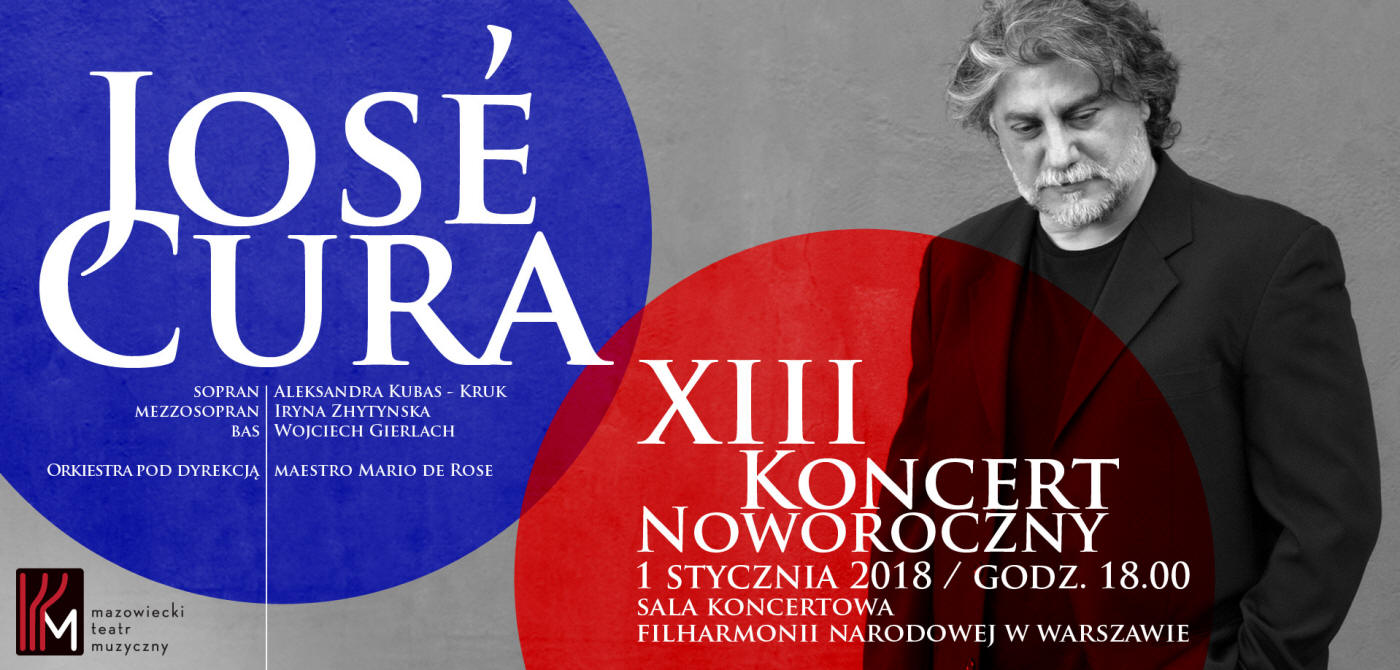
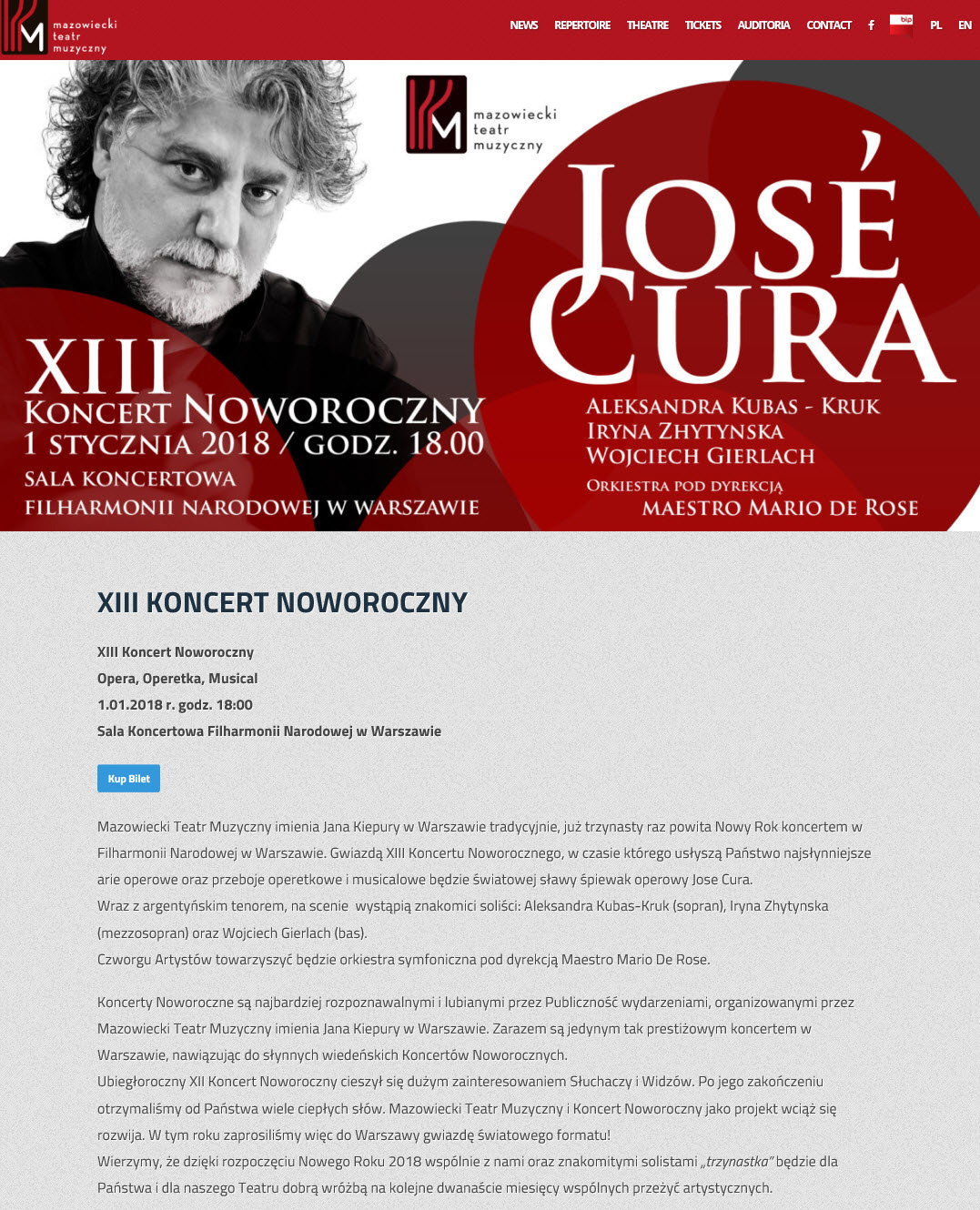
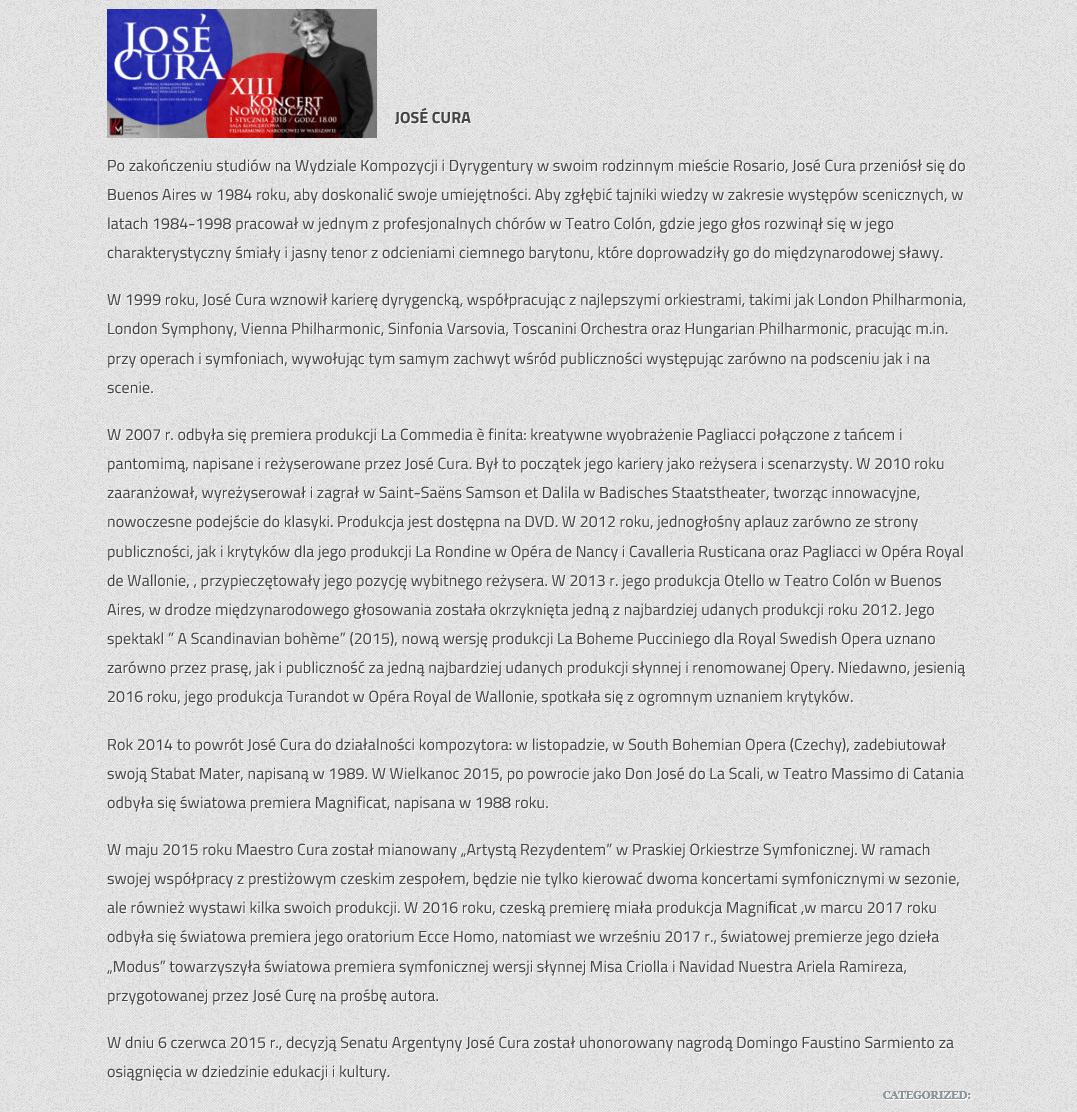


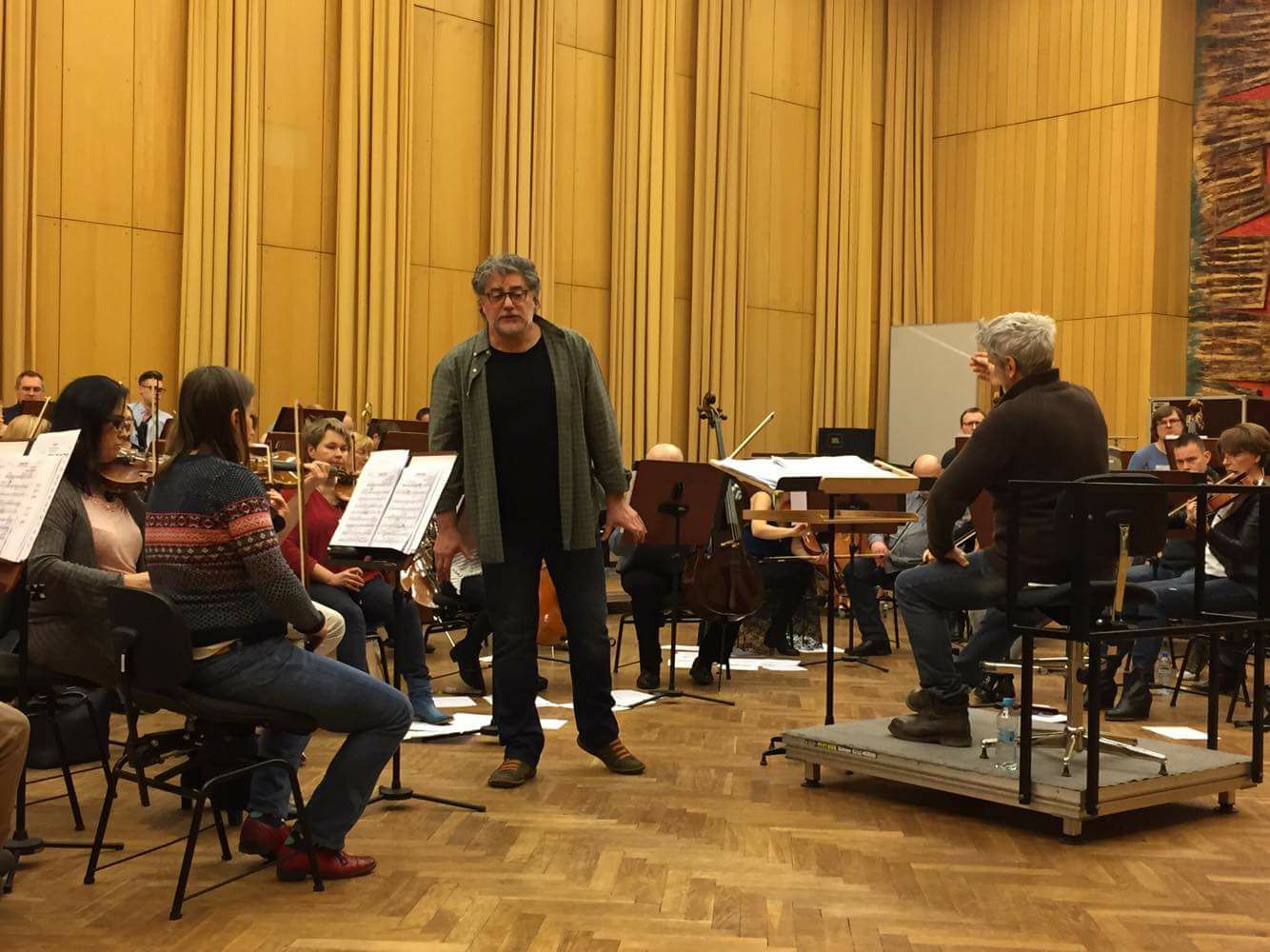

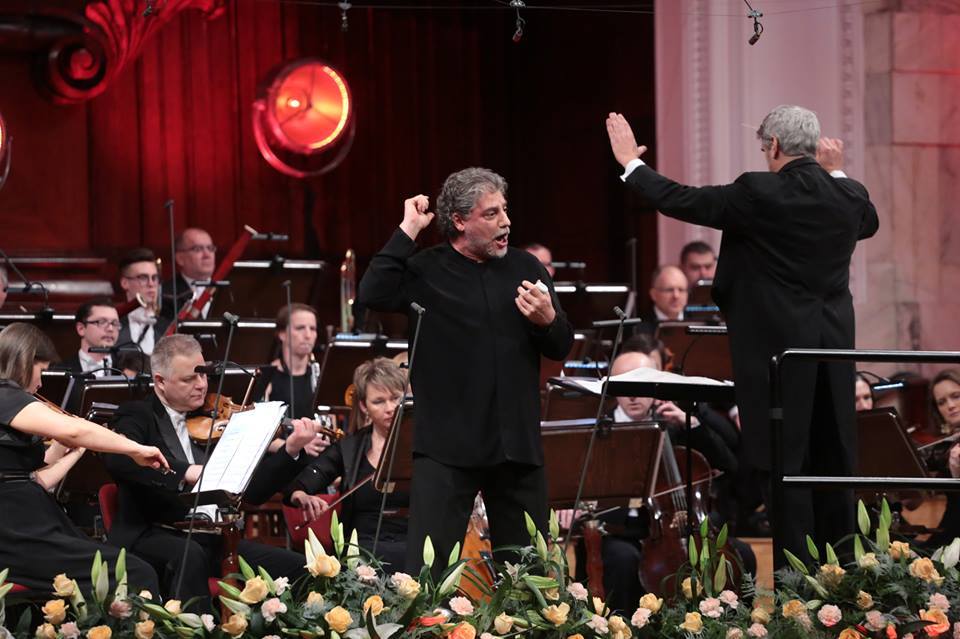
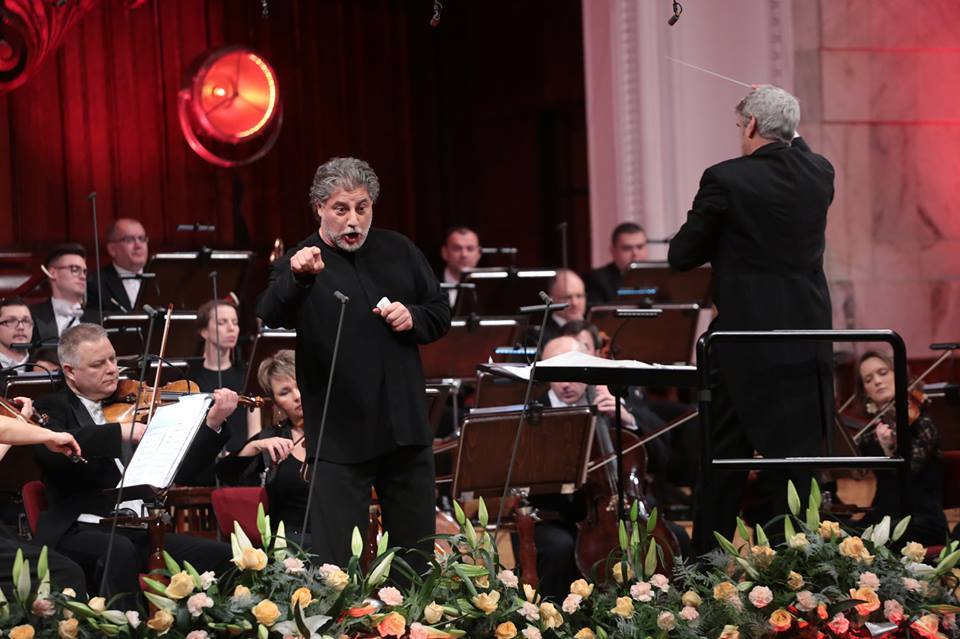
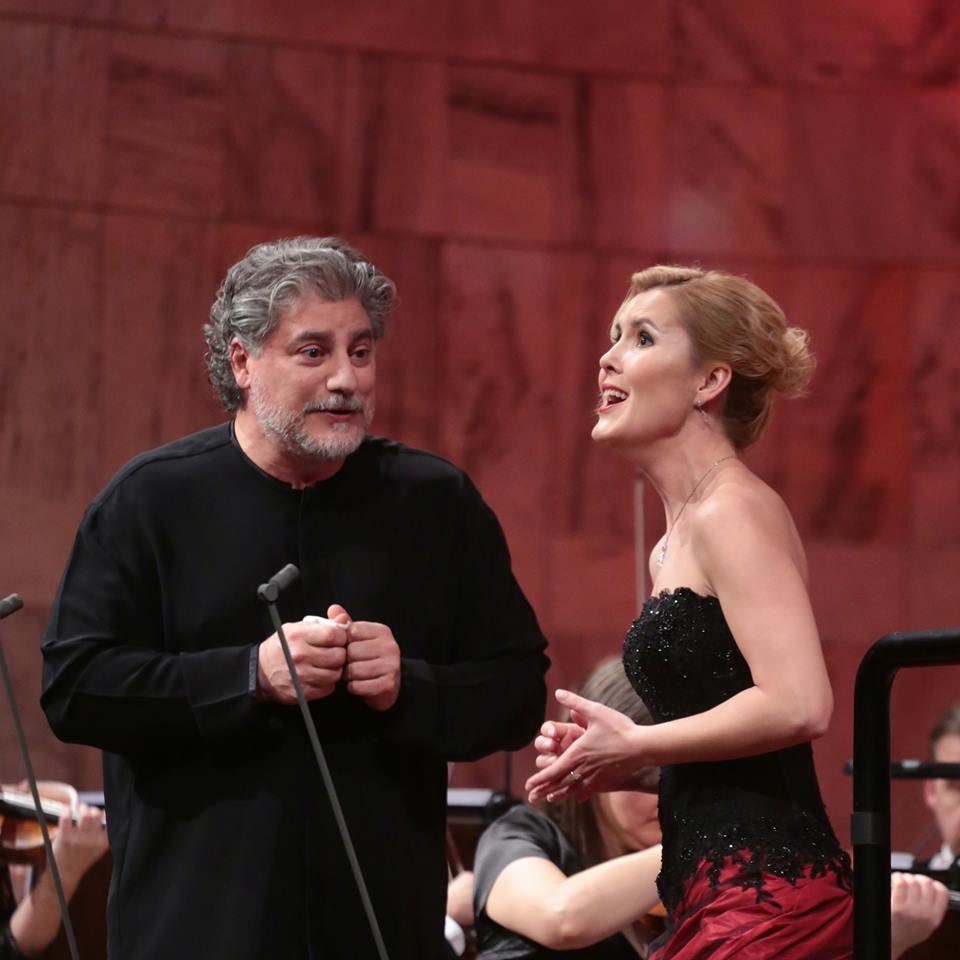
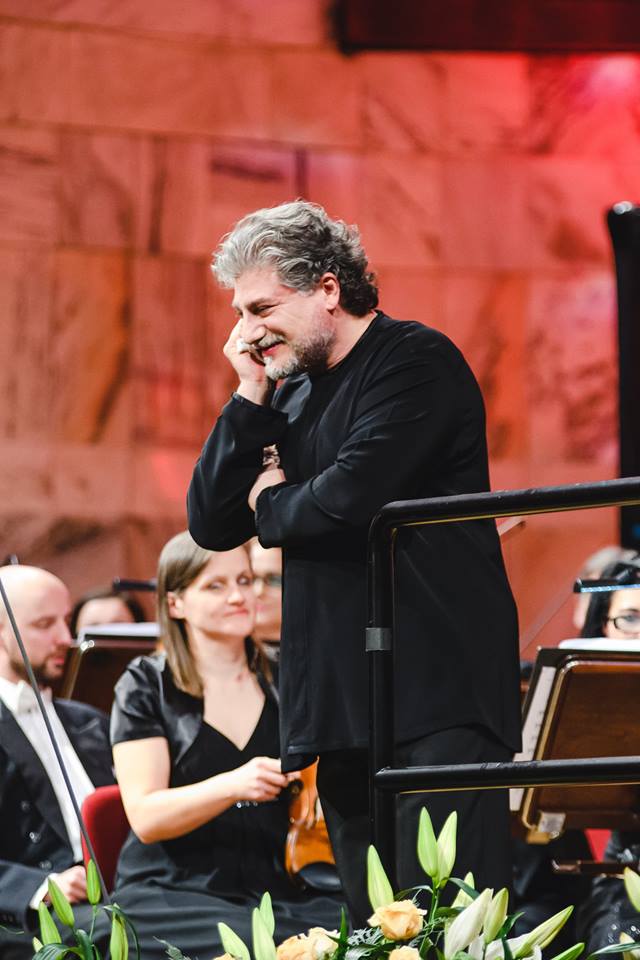
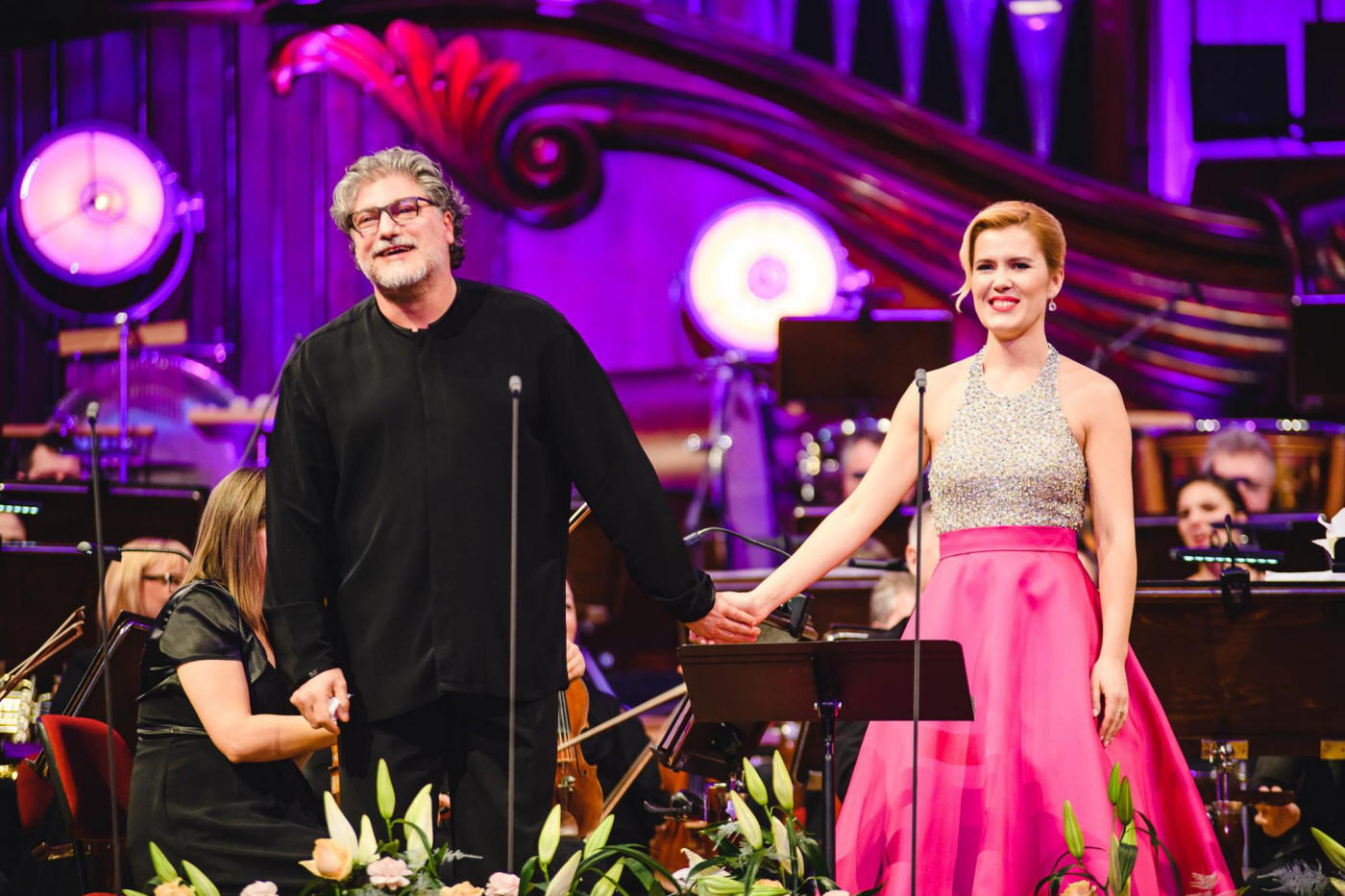
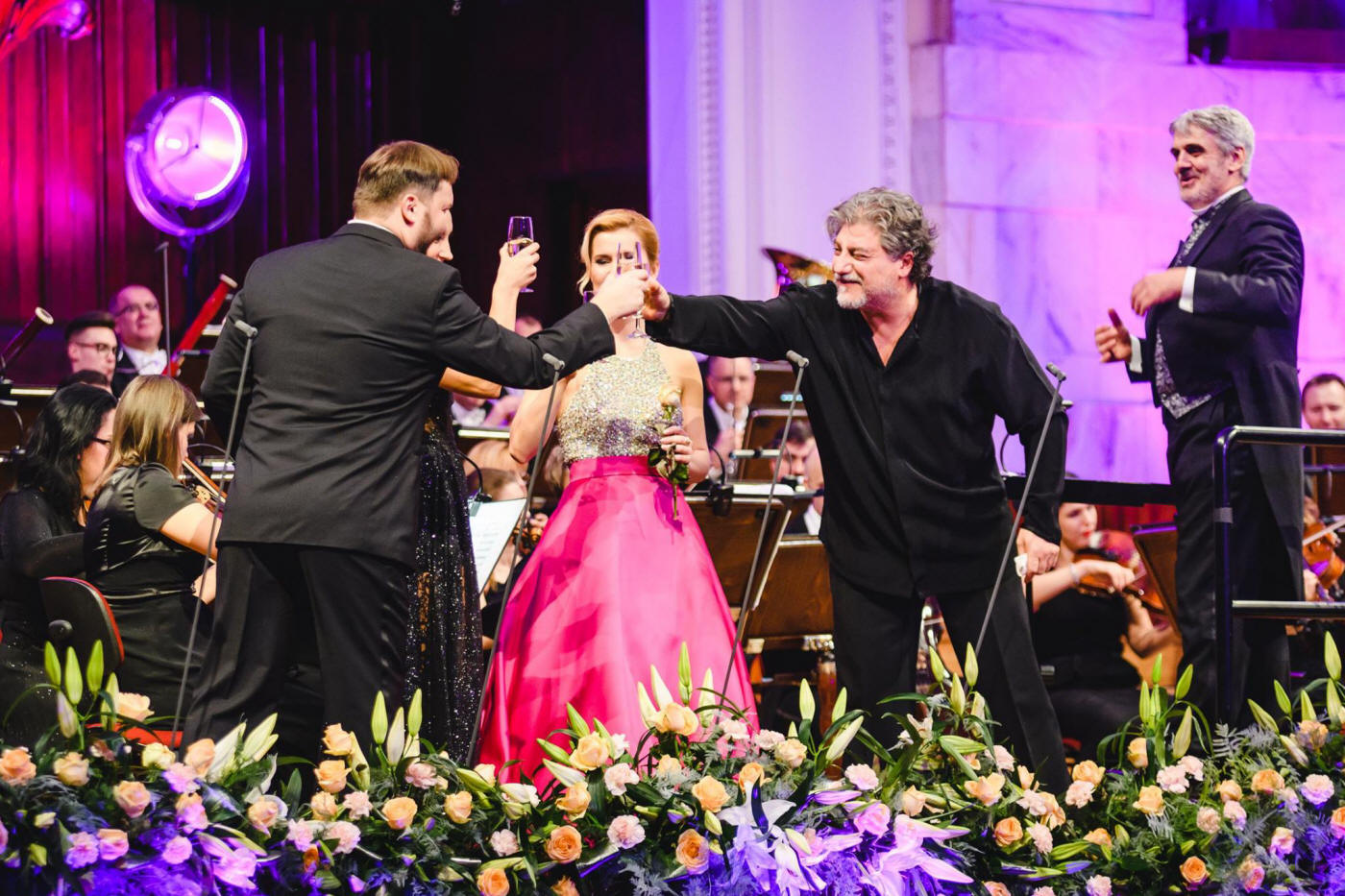
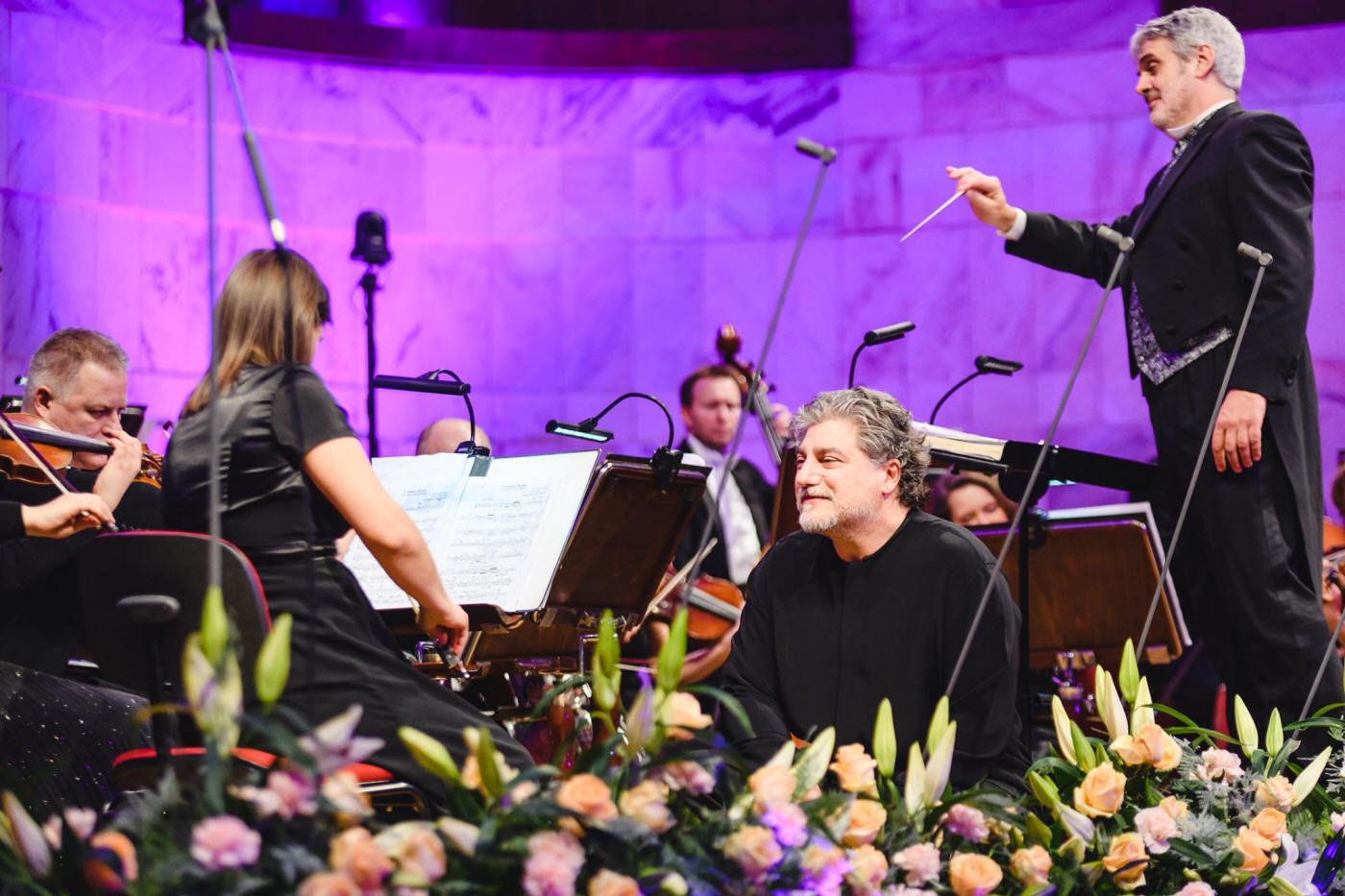
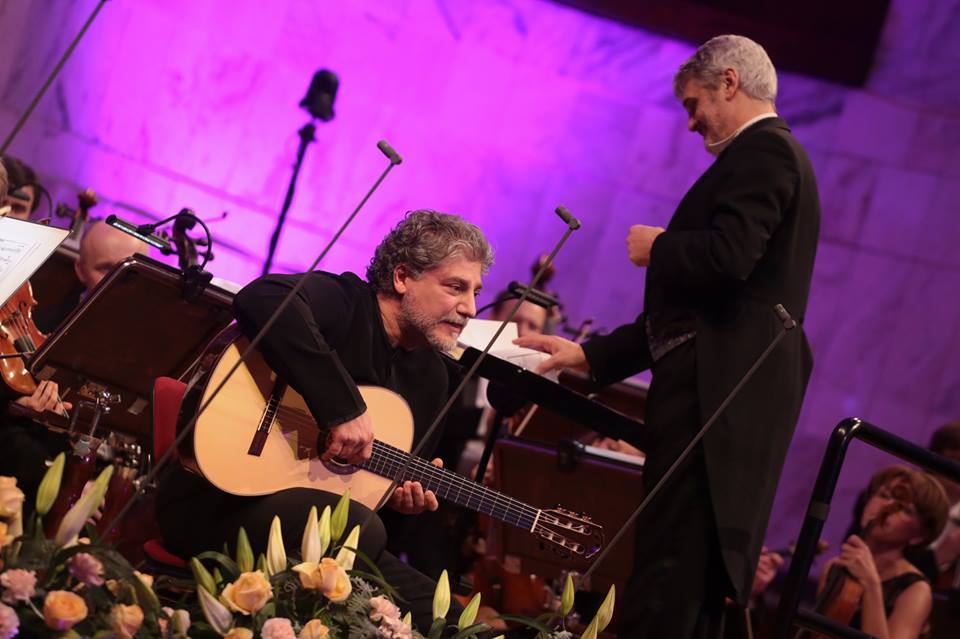
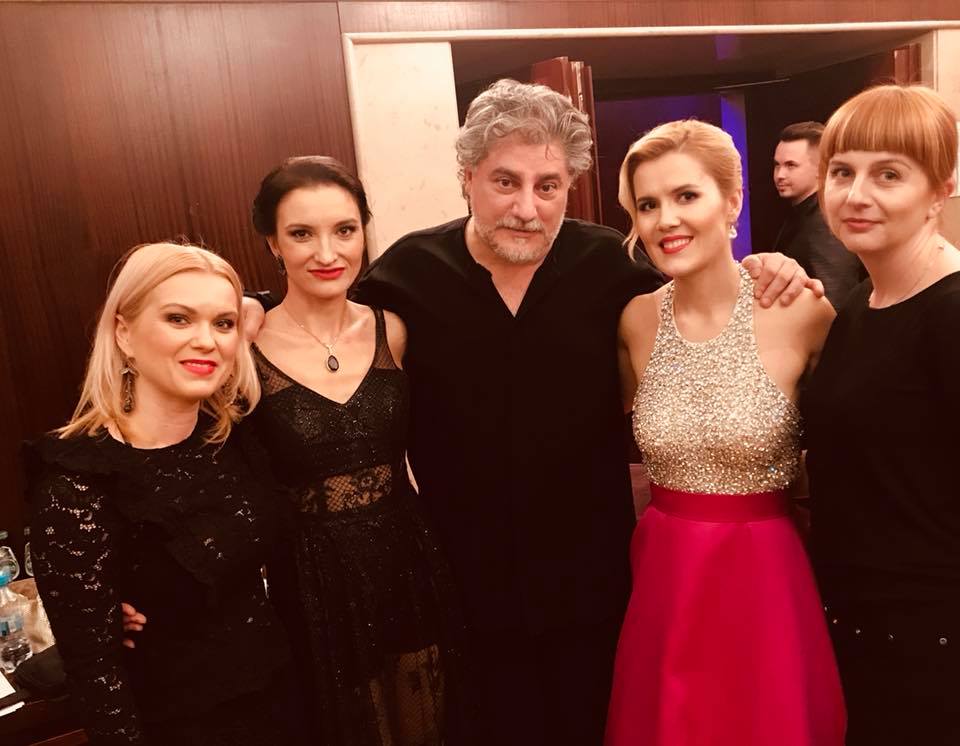

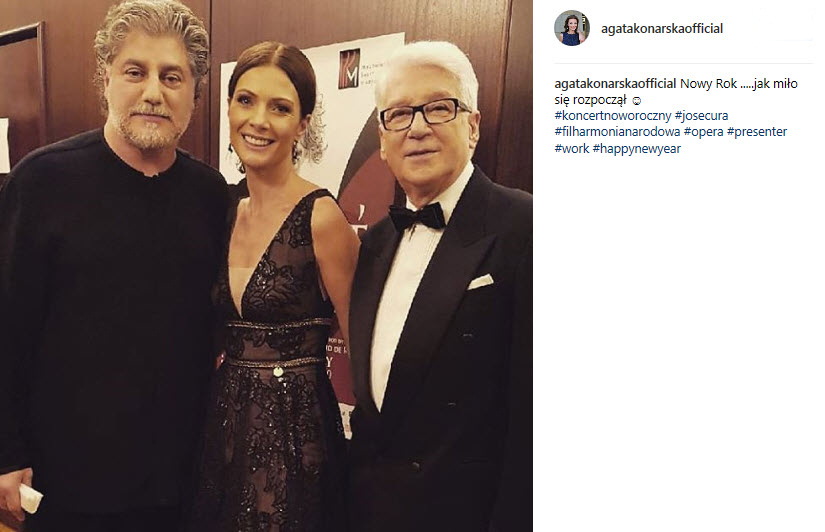
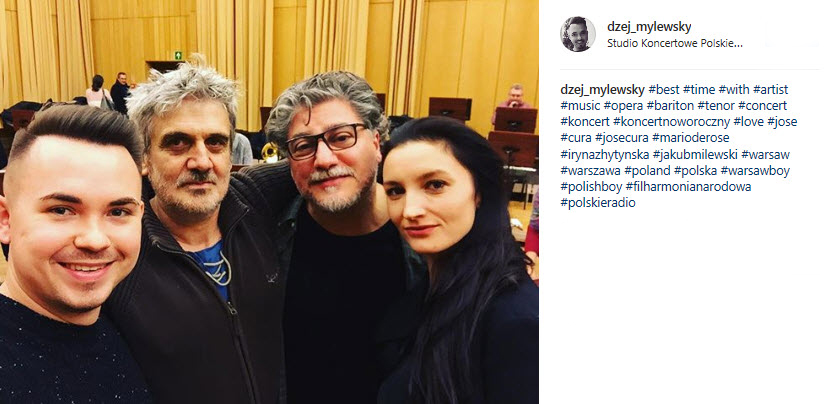
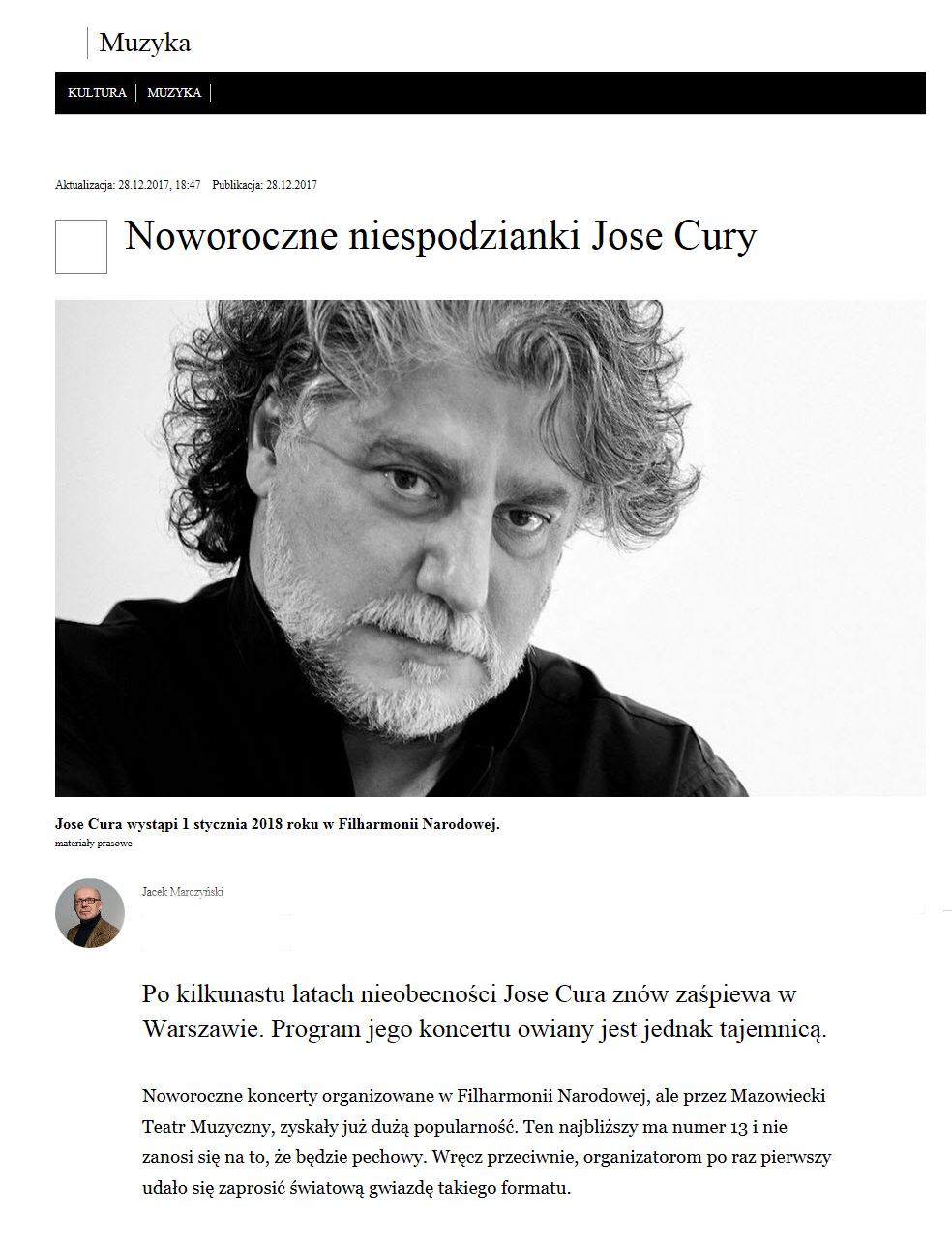

.jpg)
%20en.jpg)

